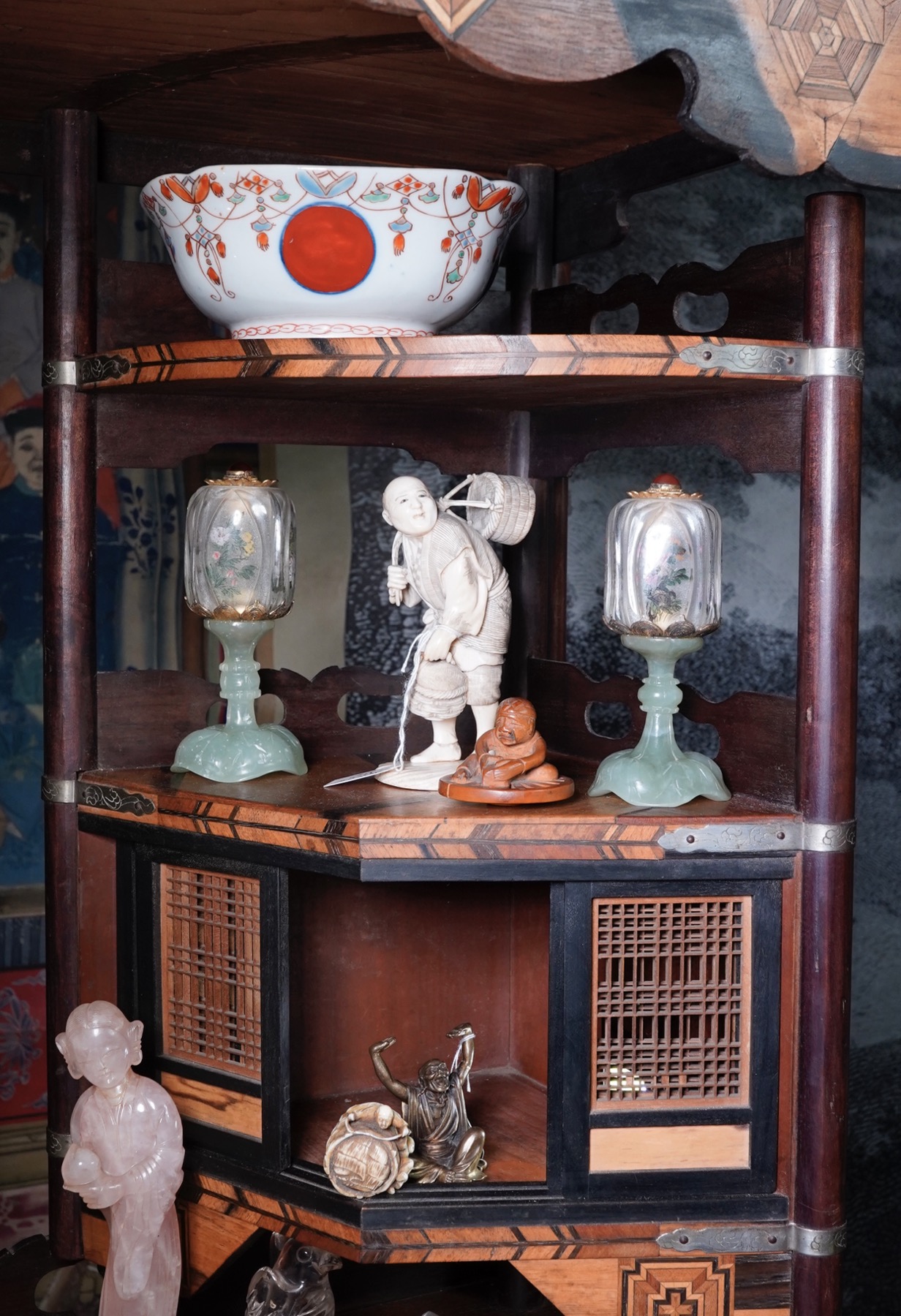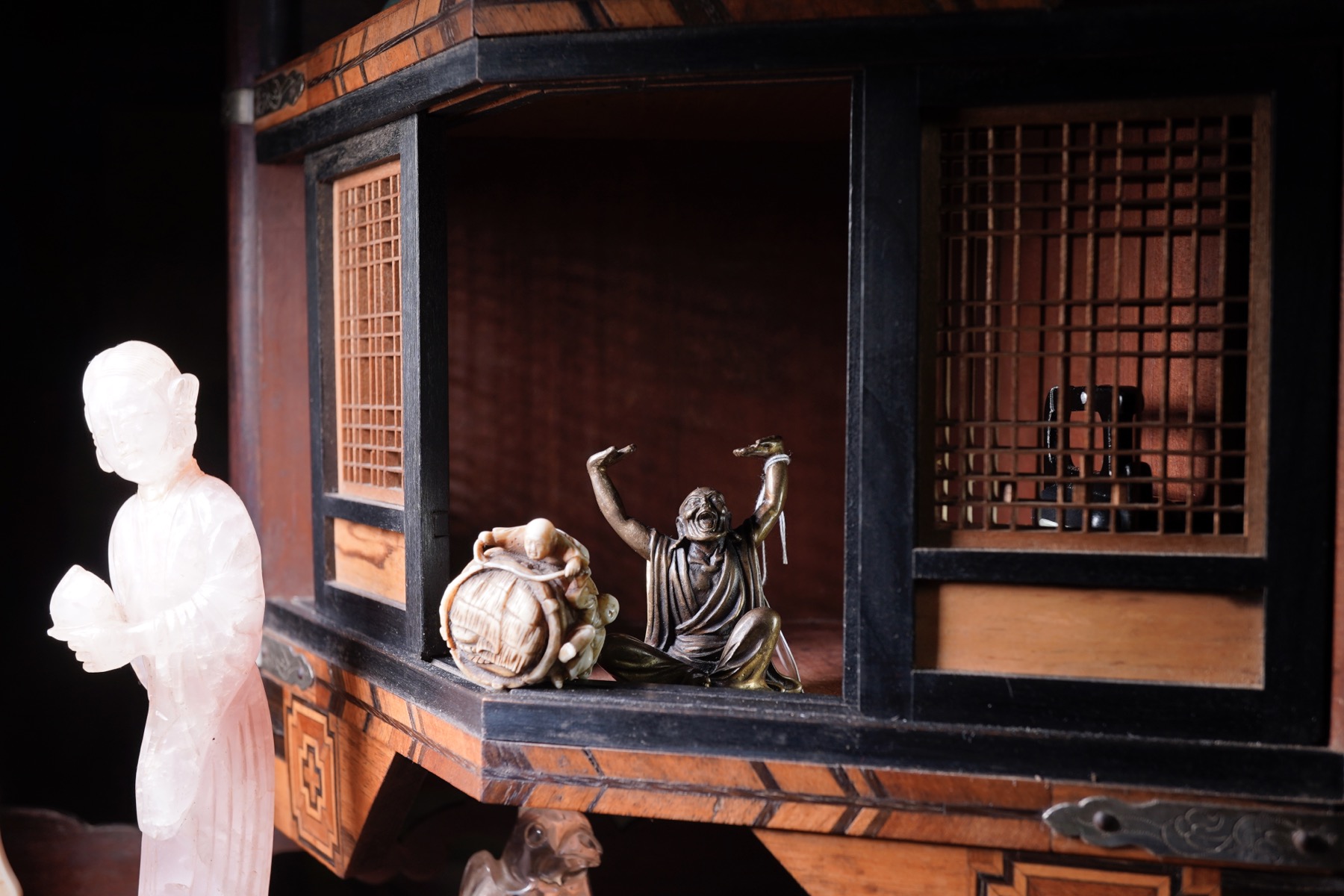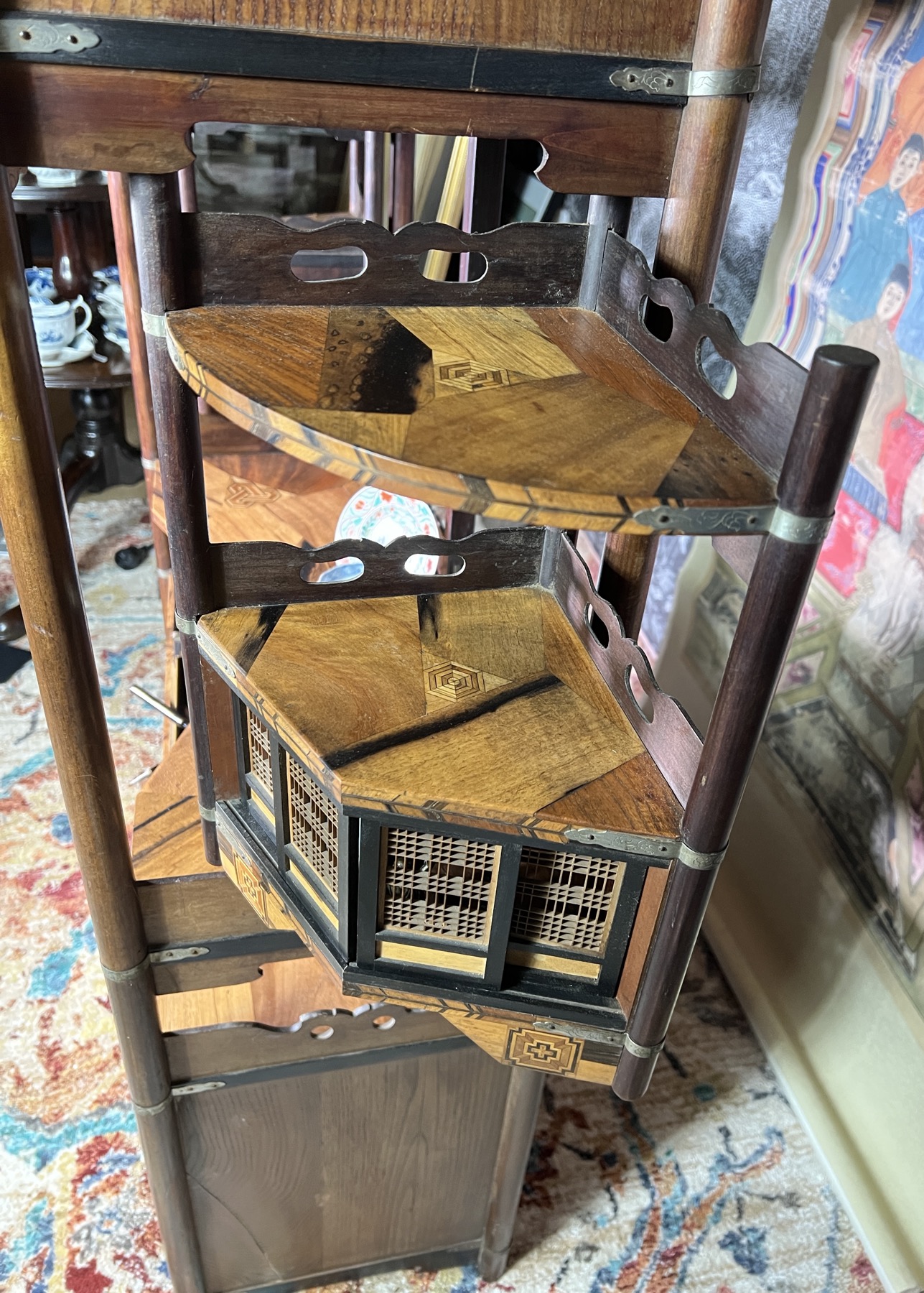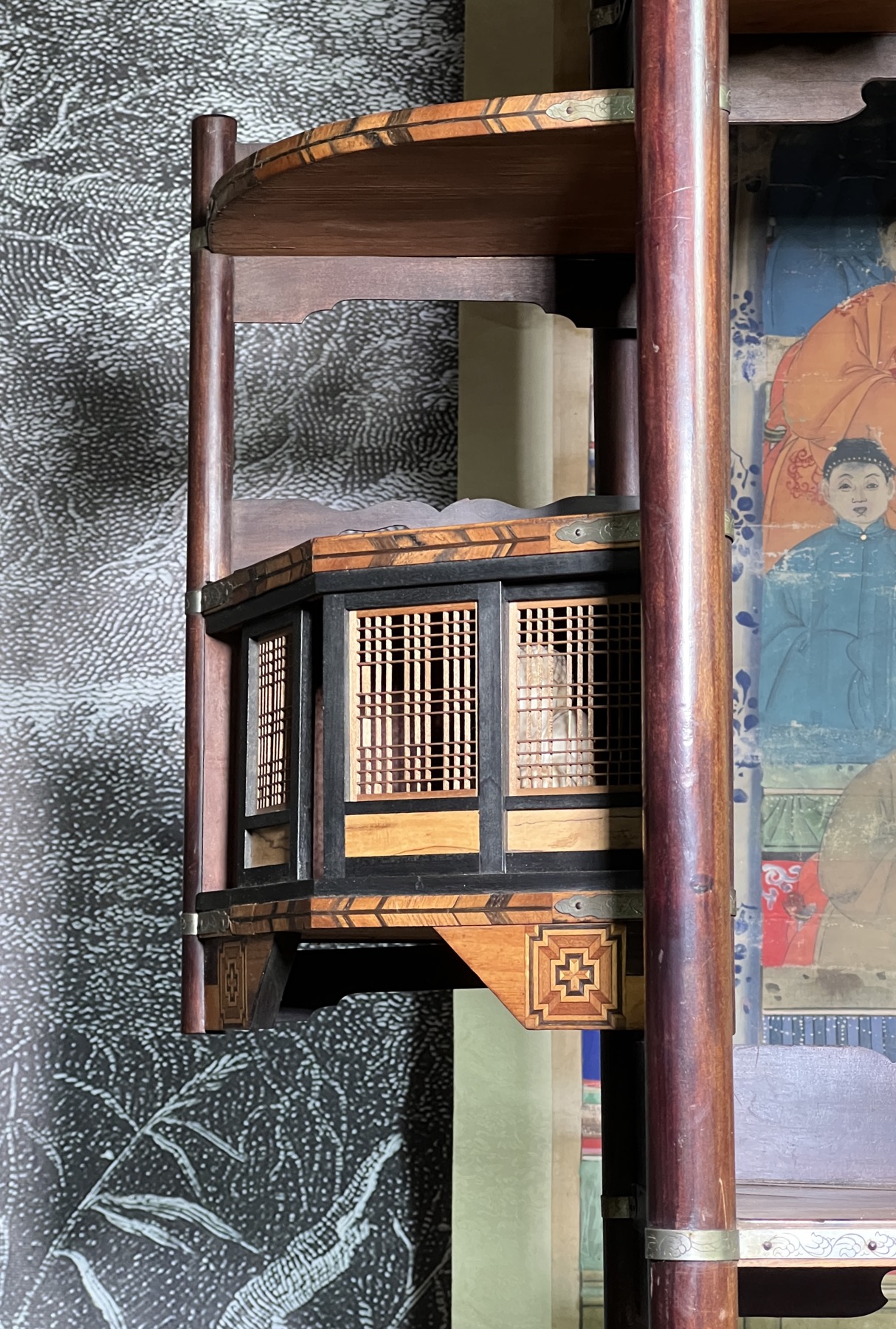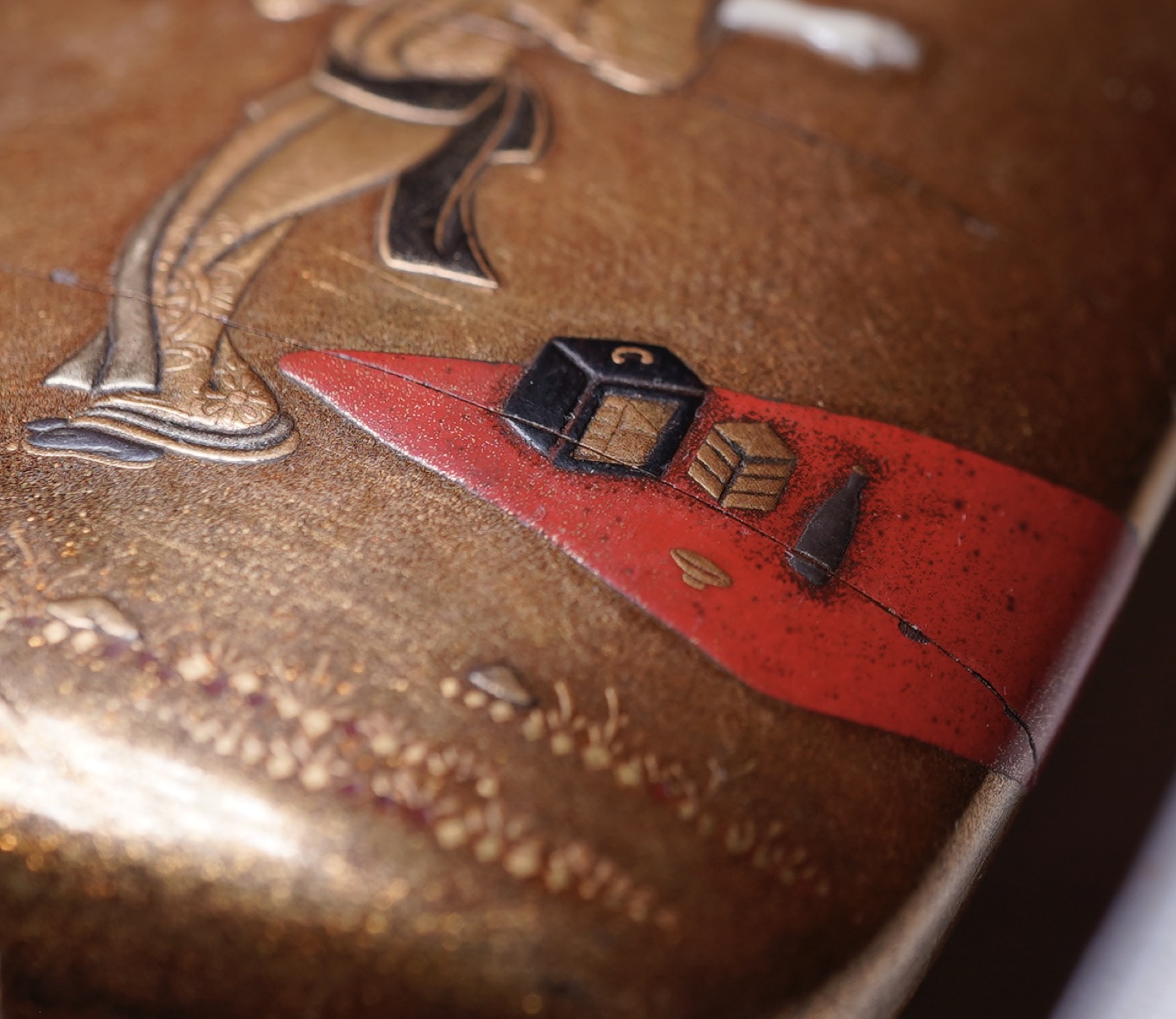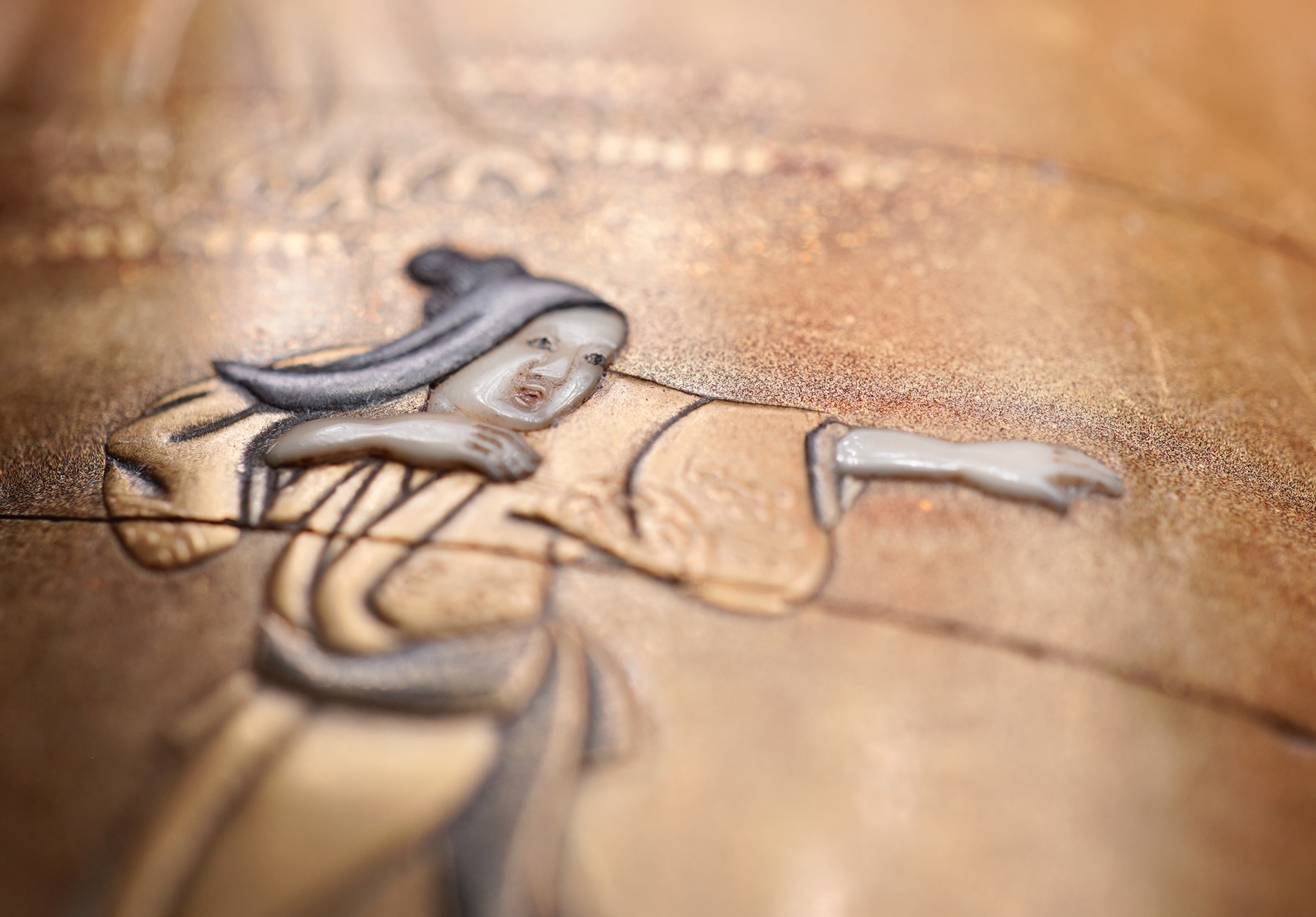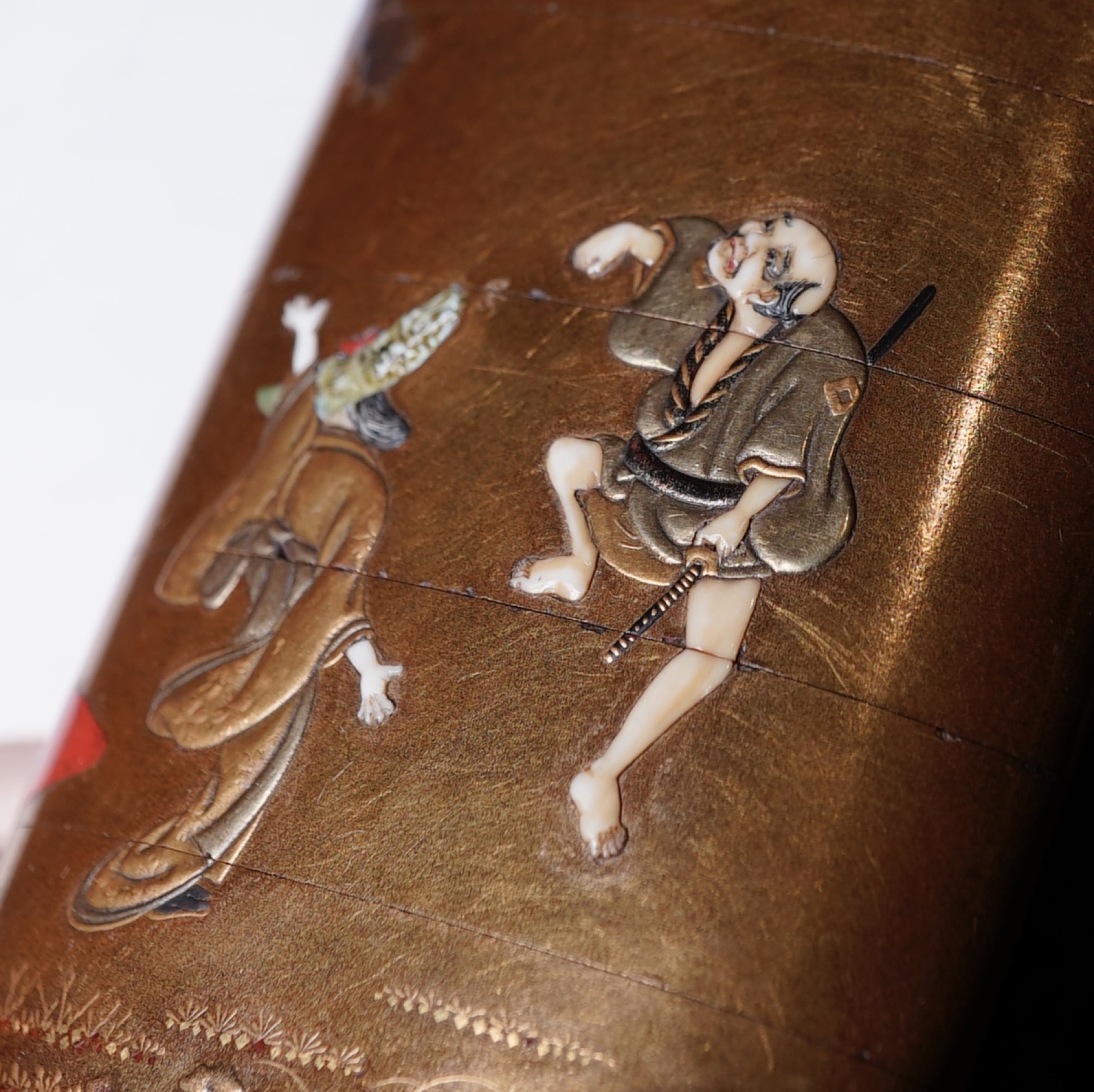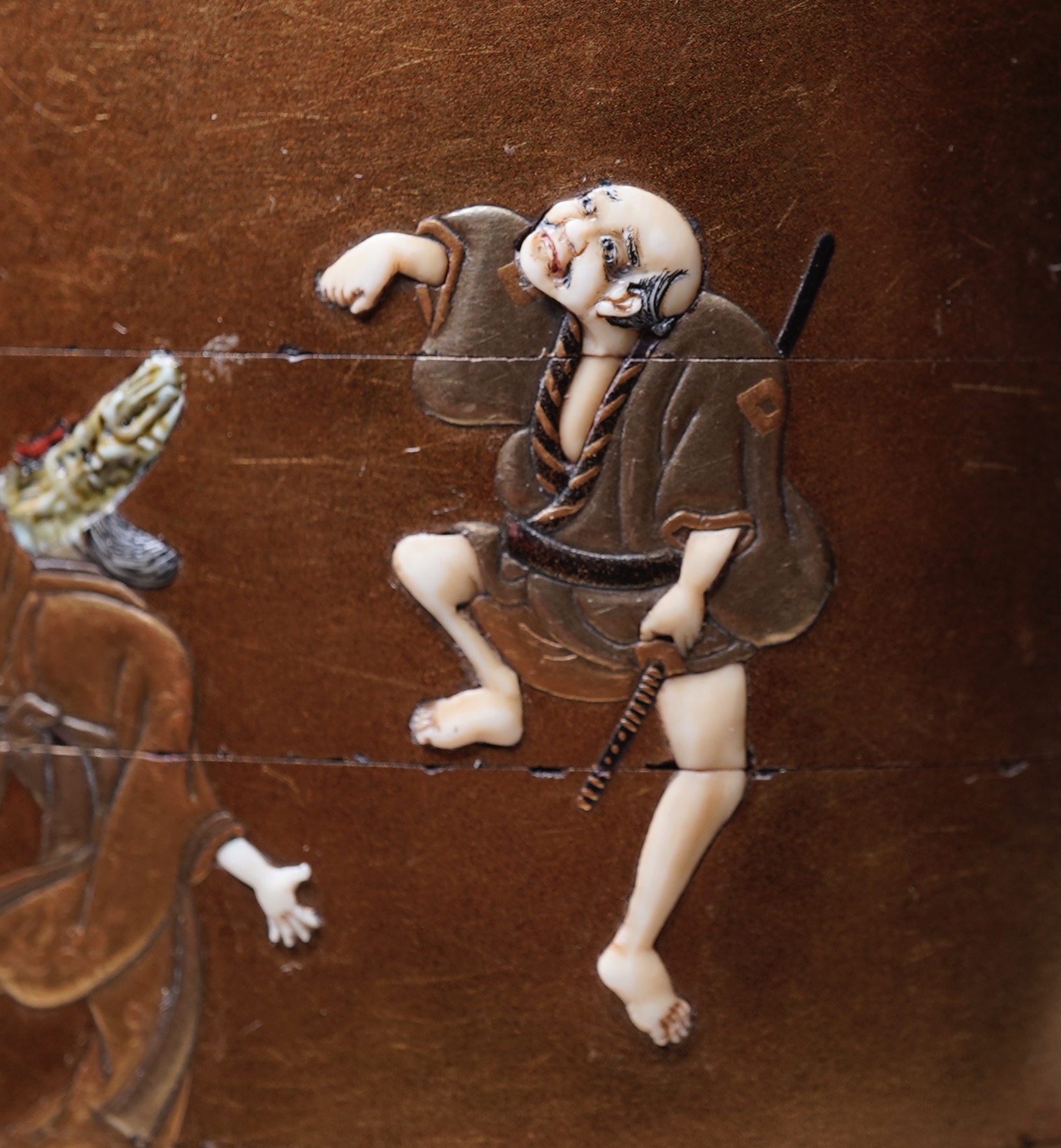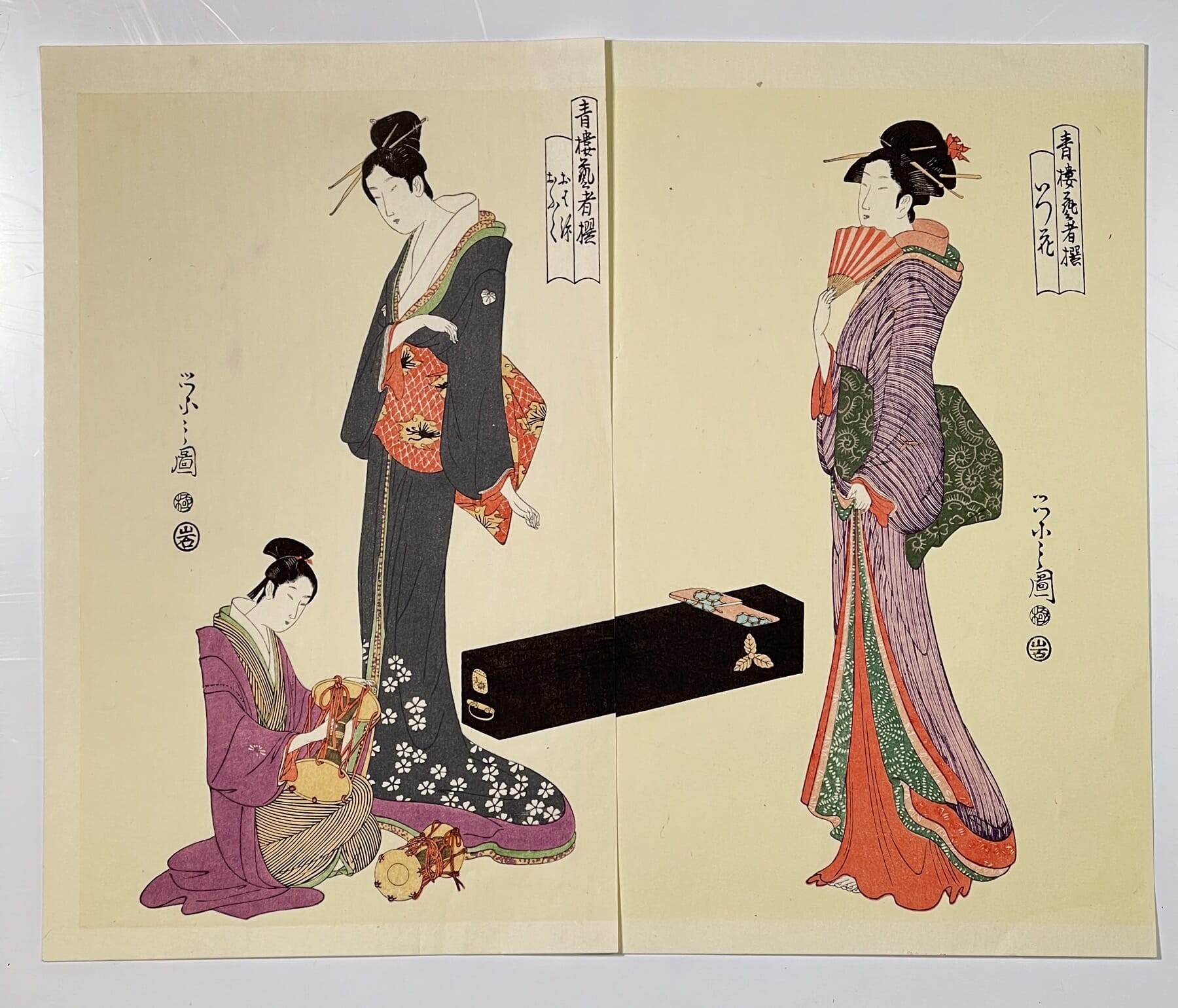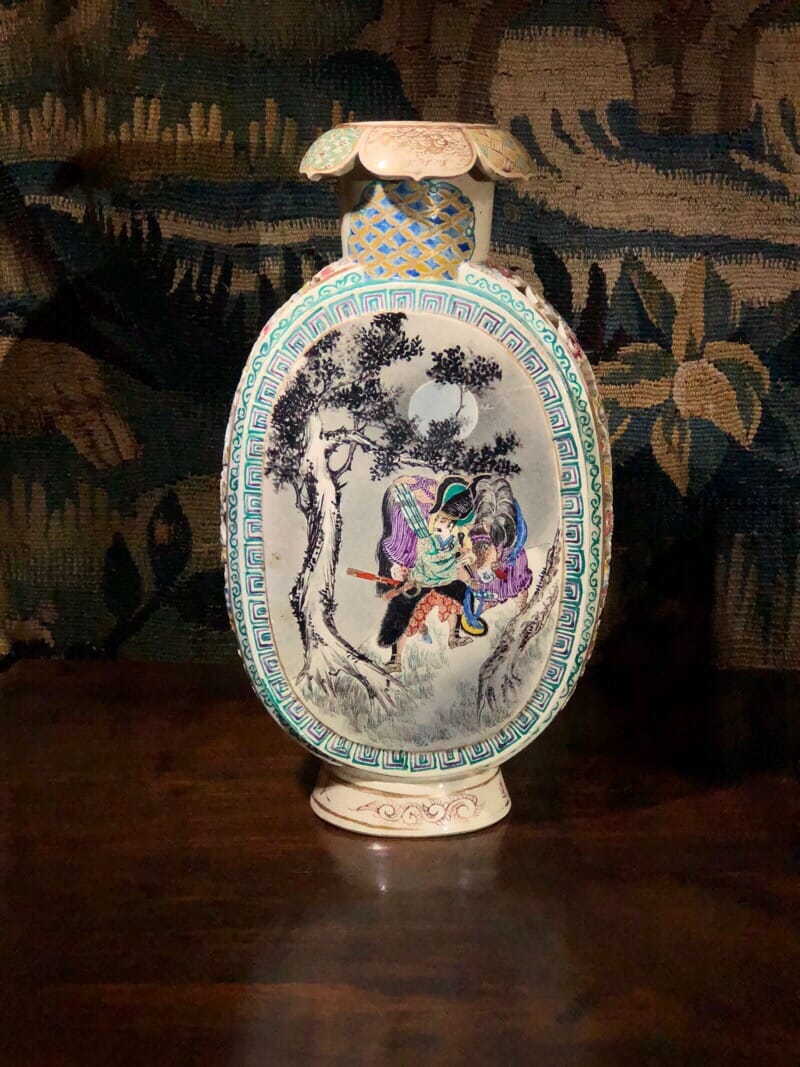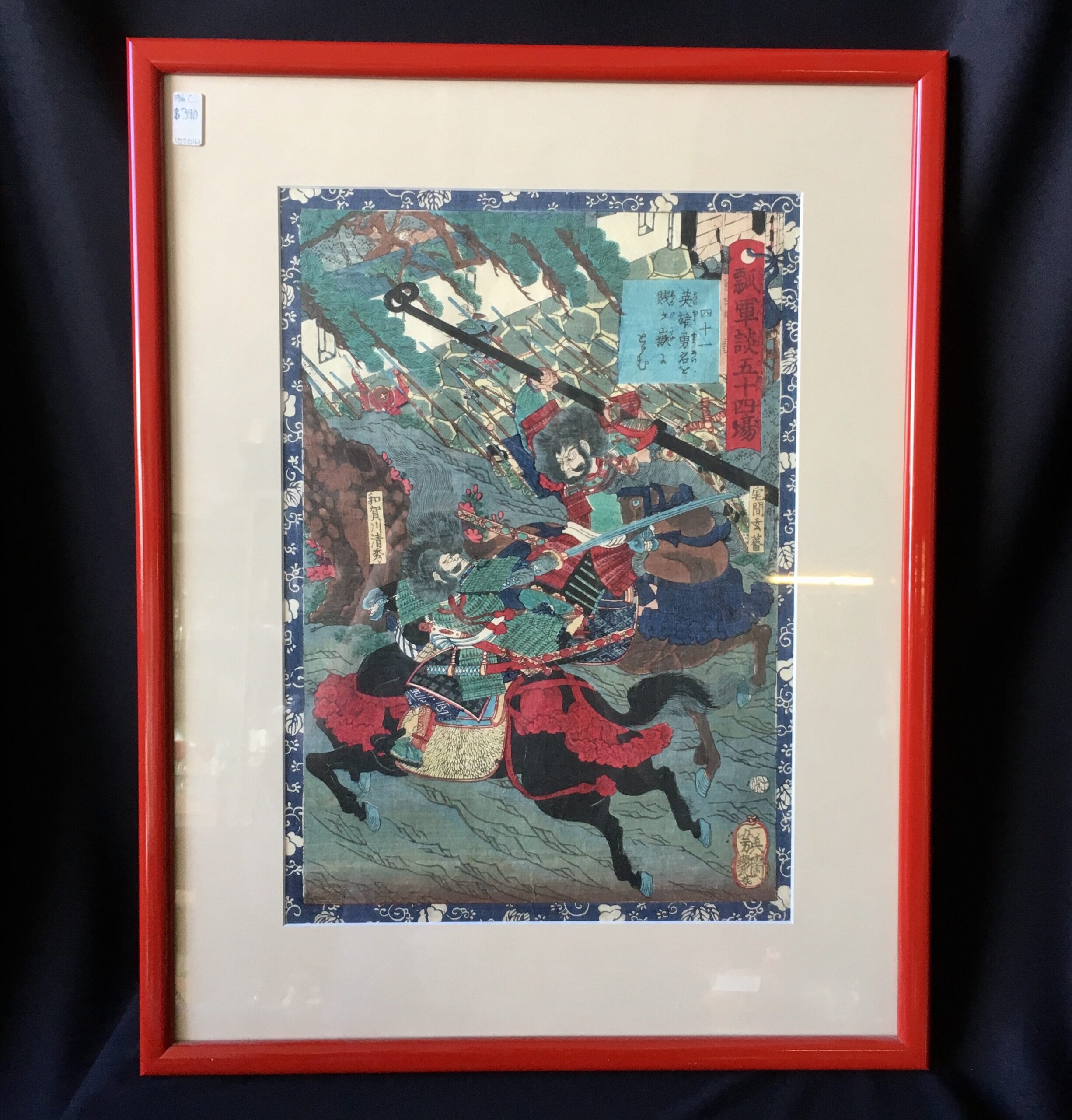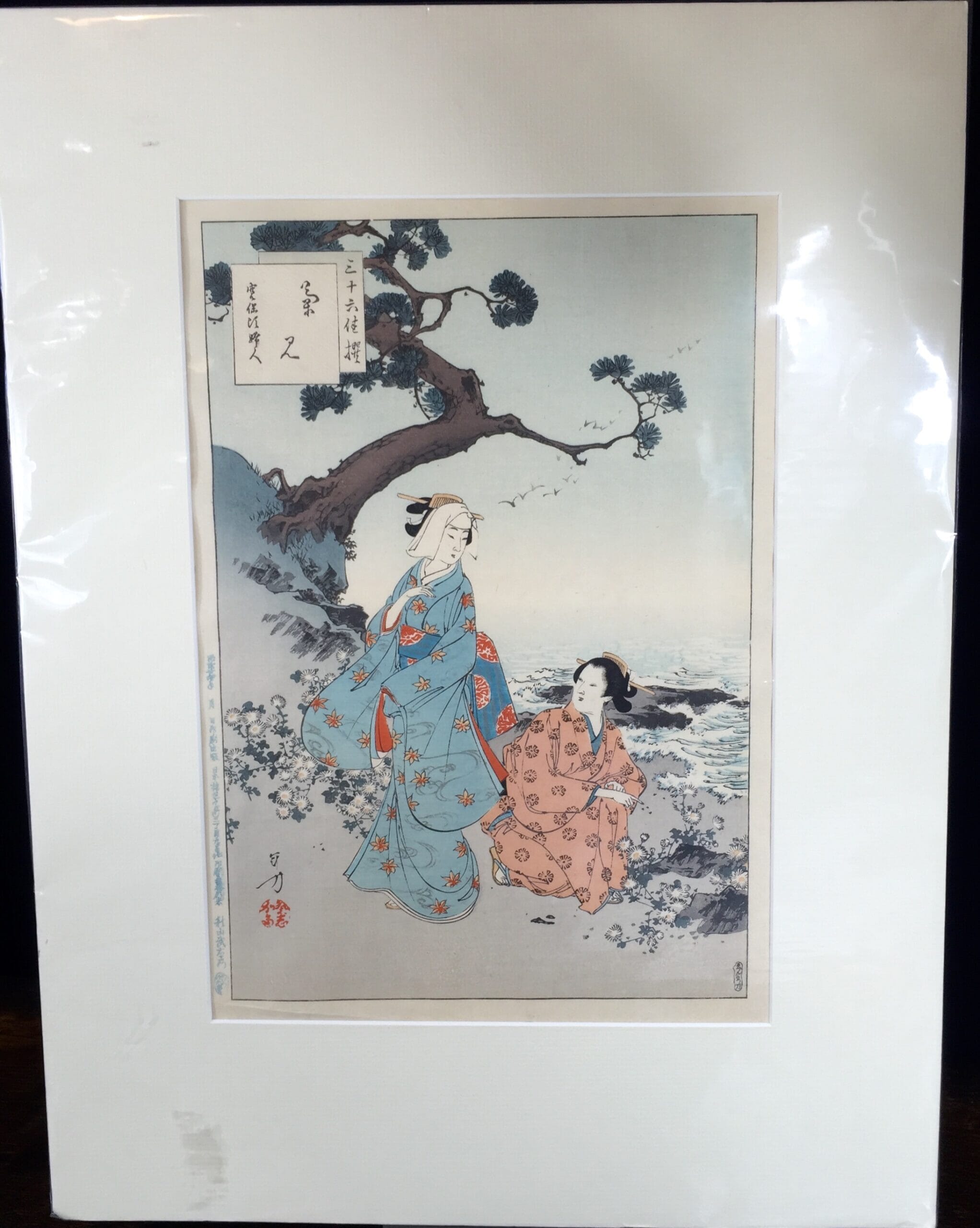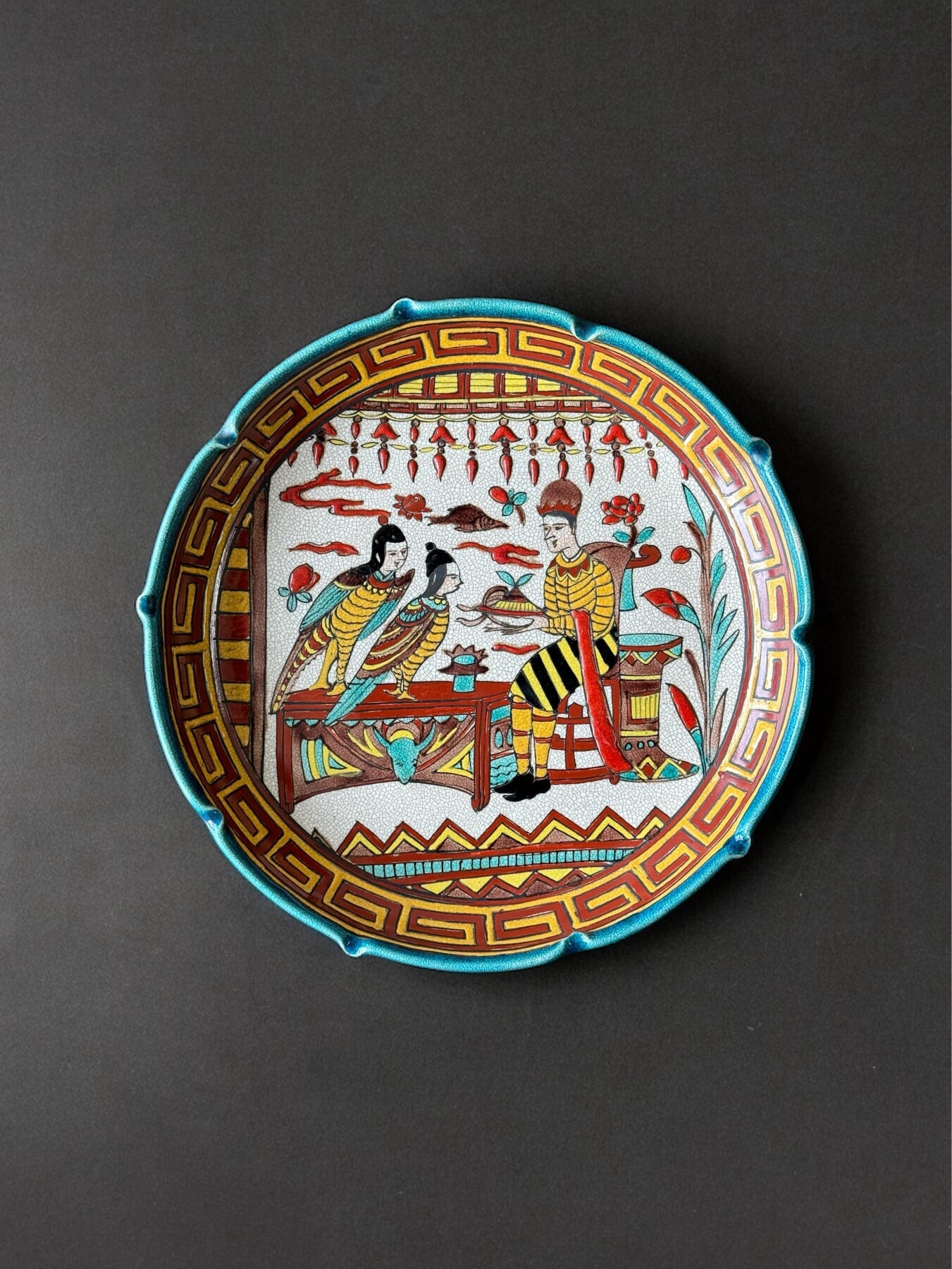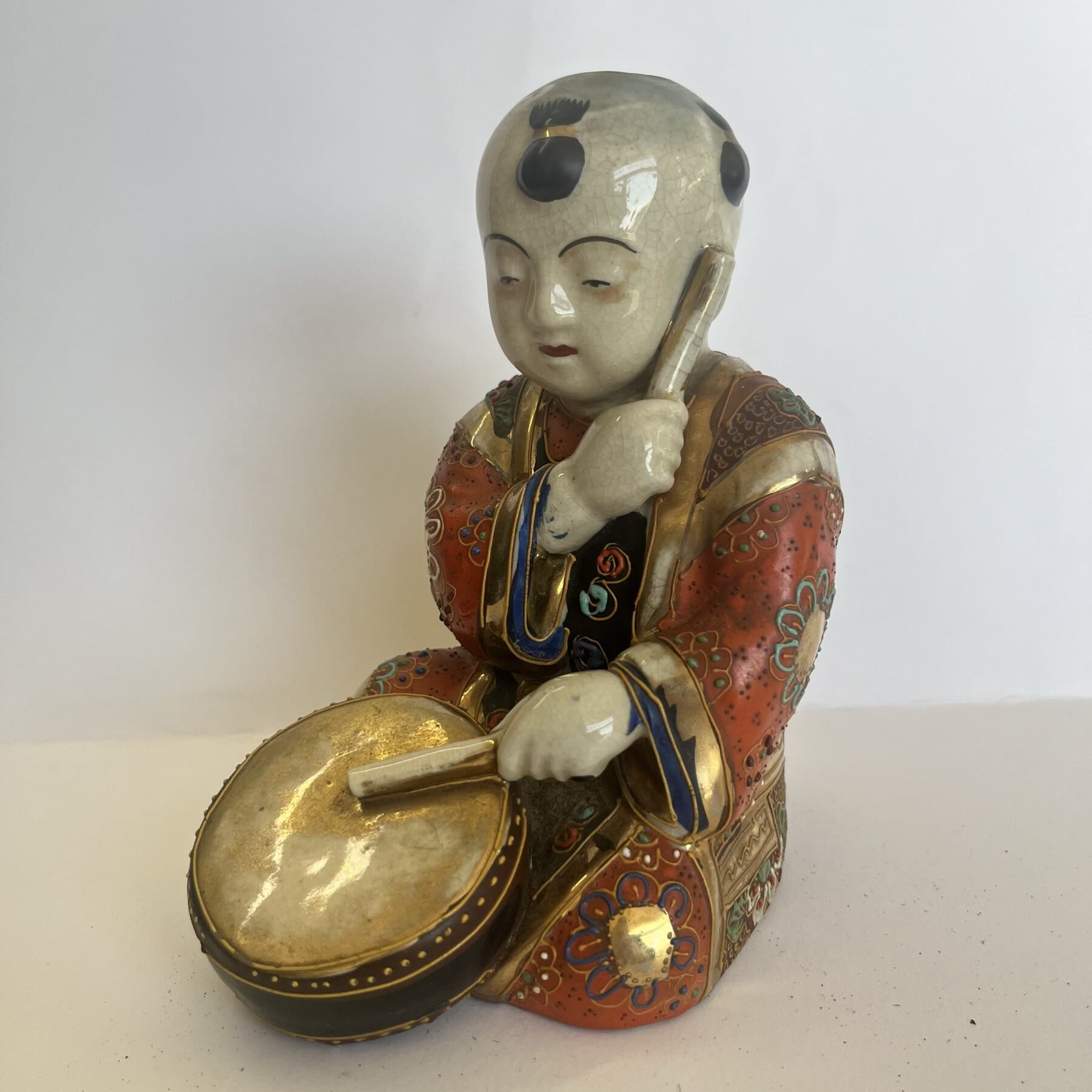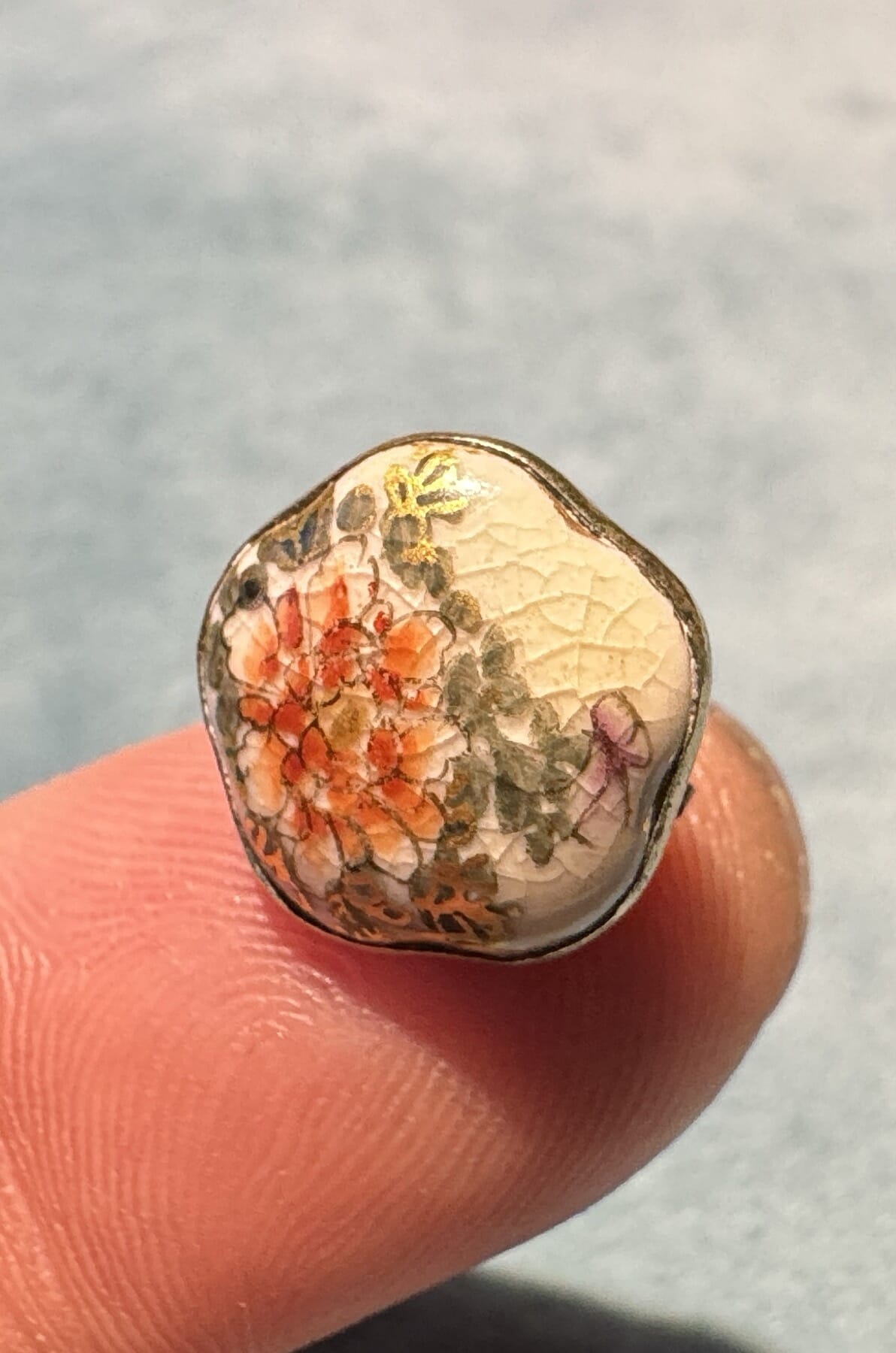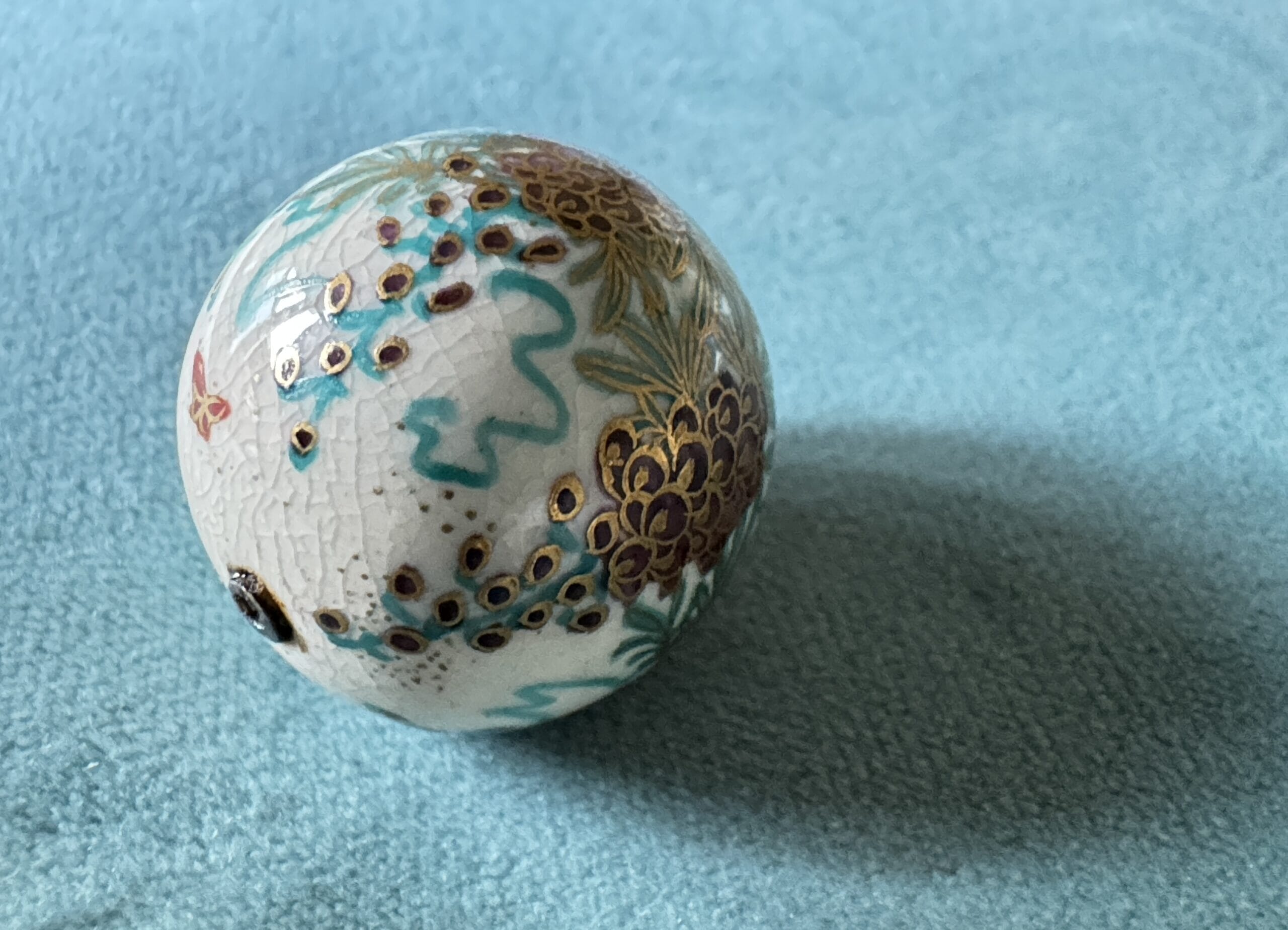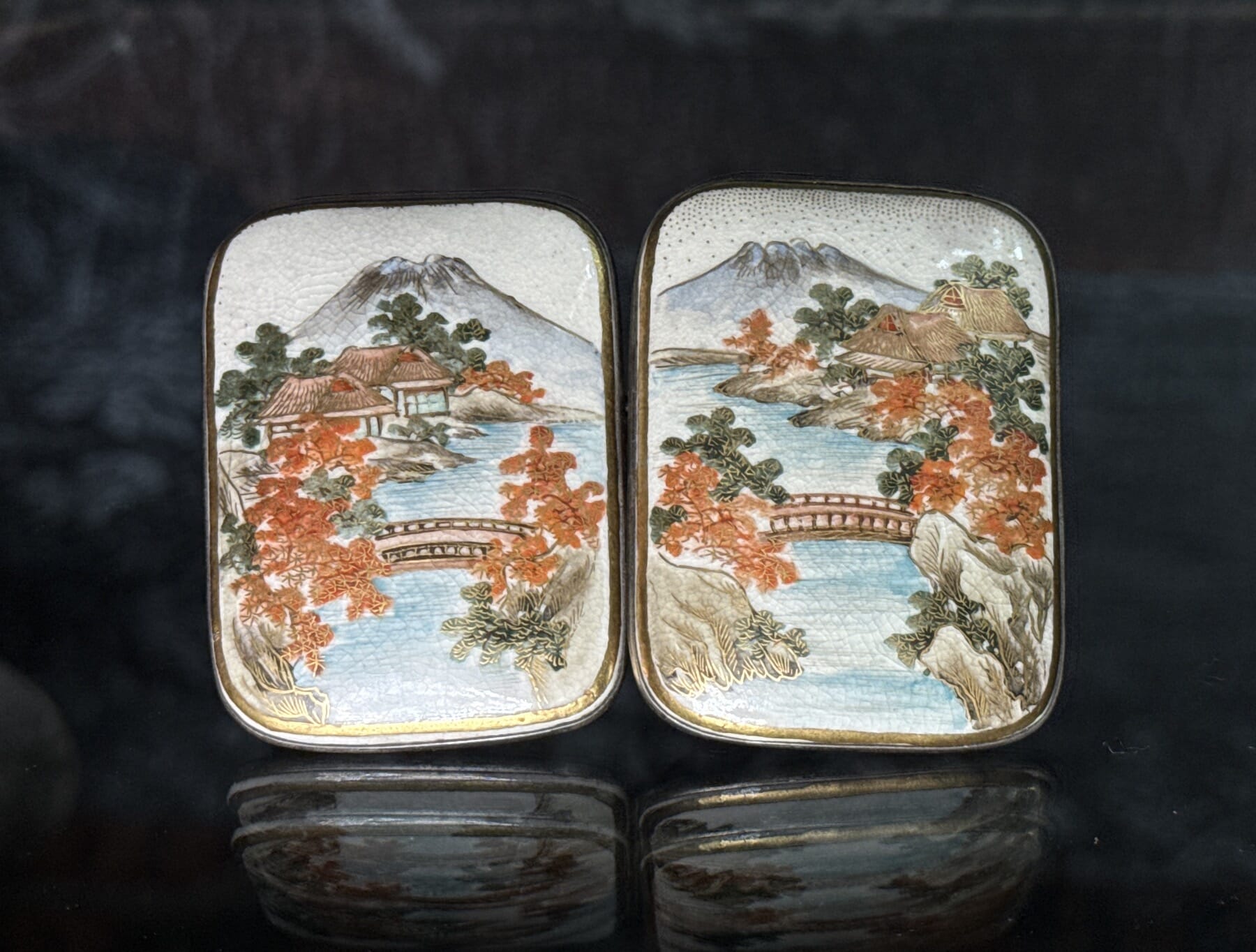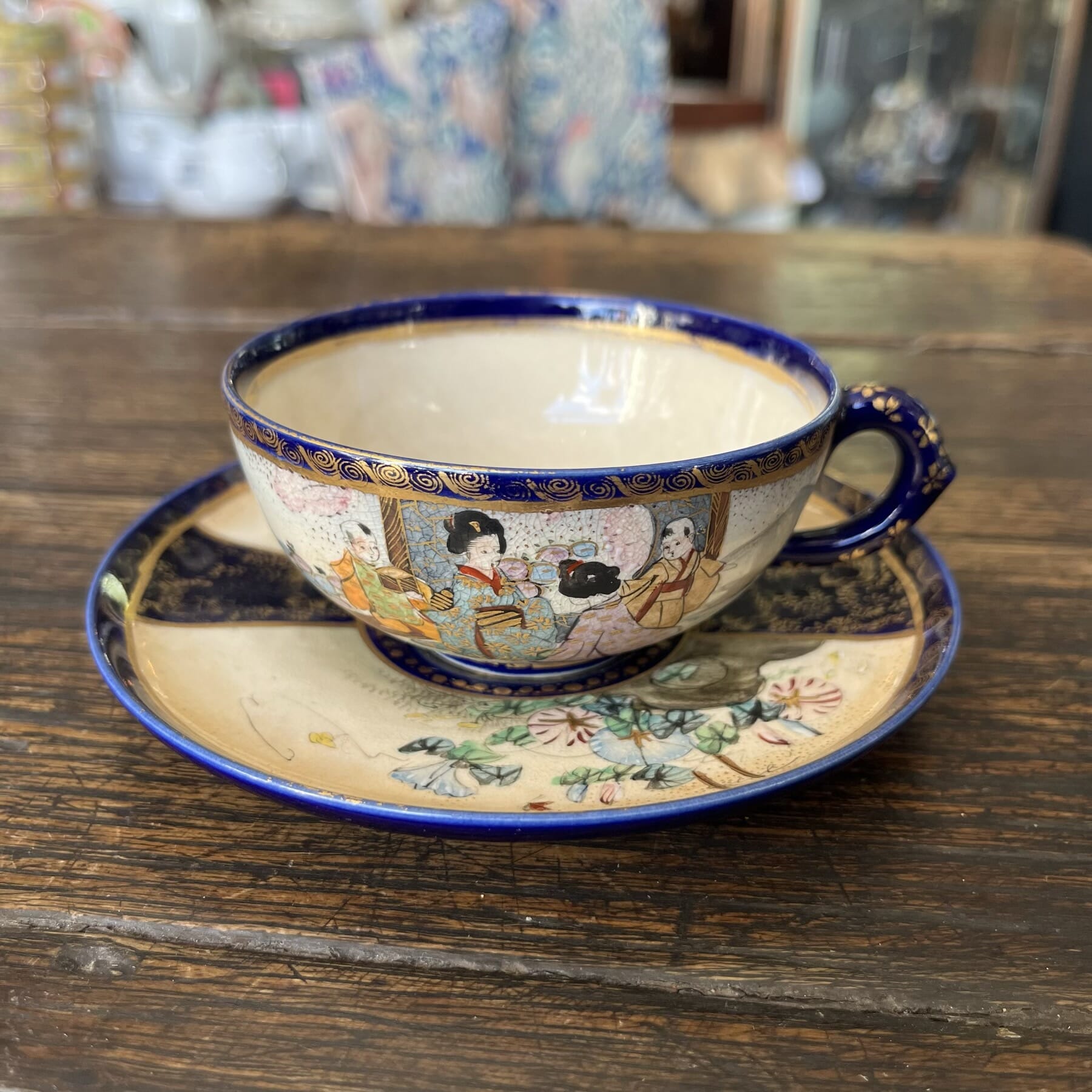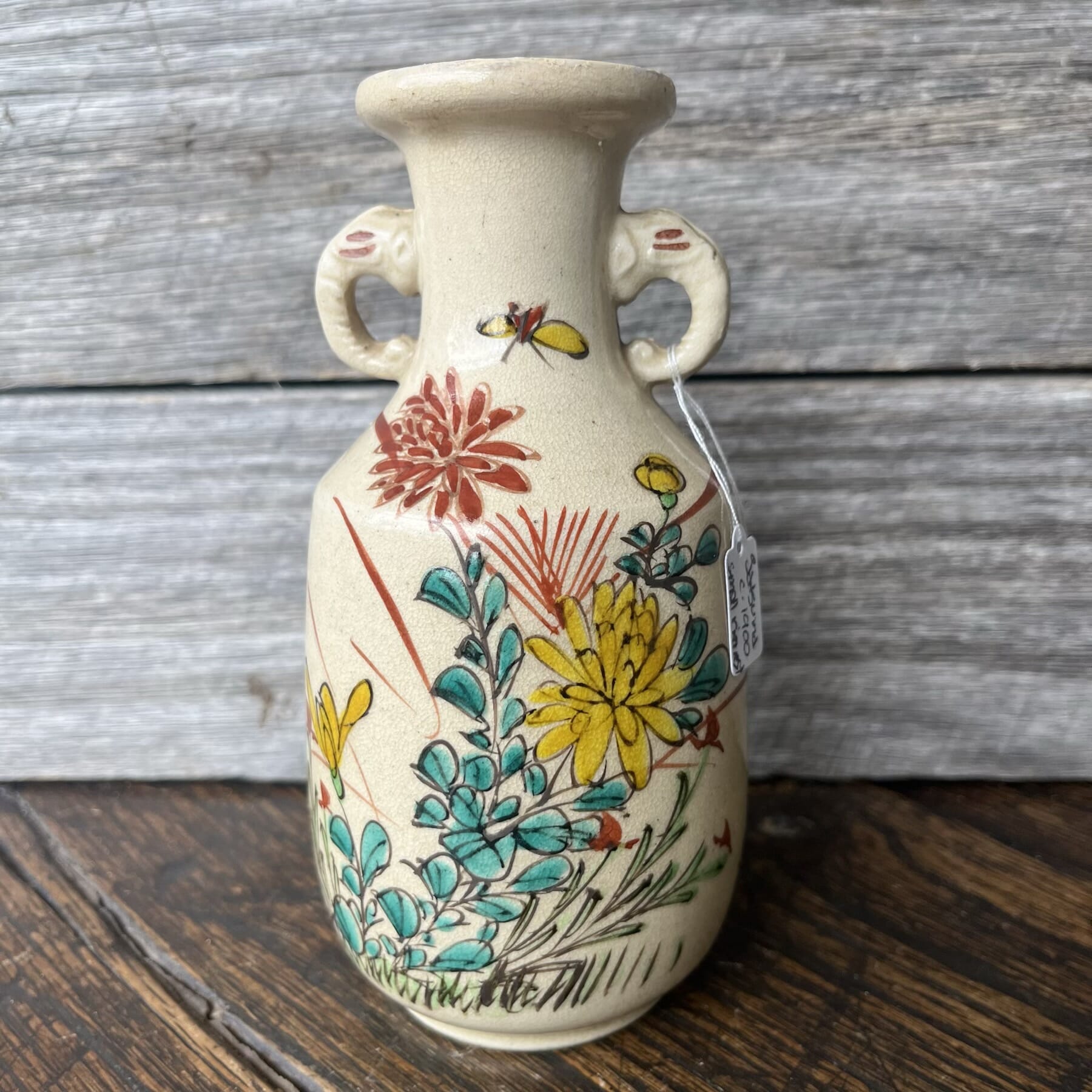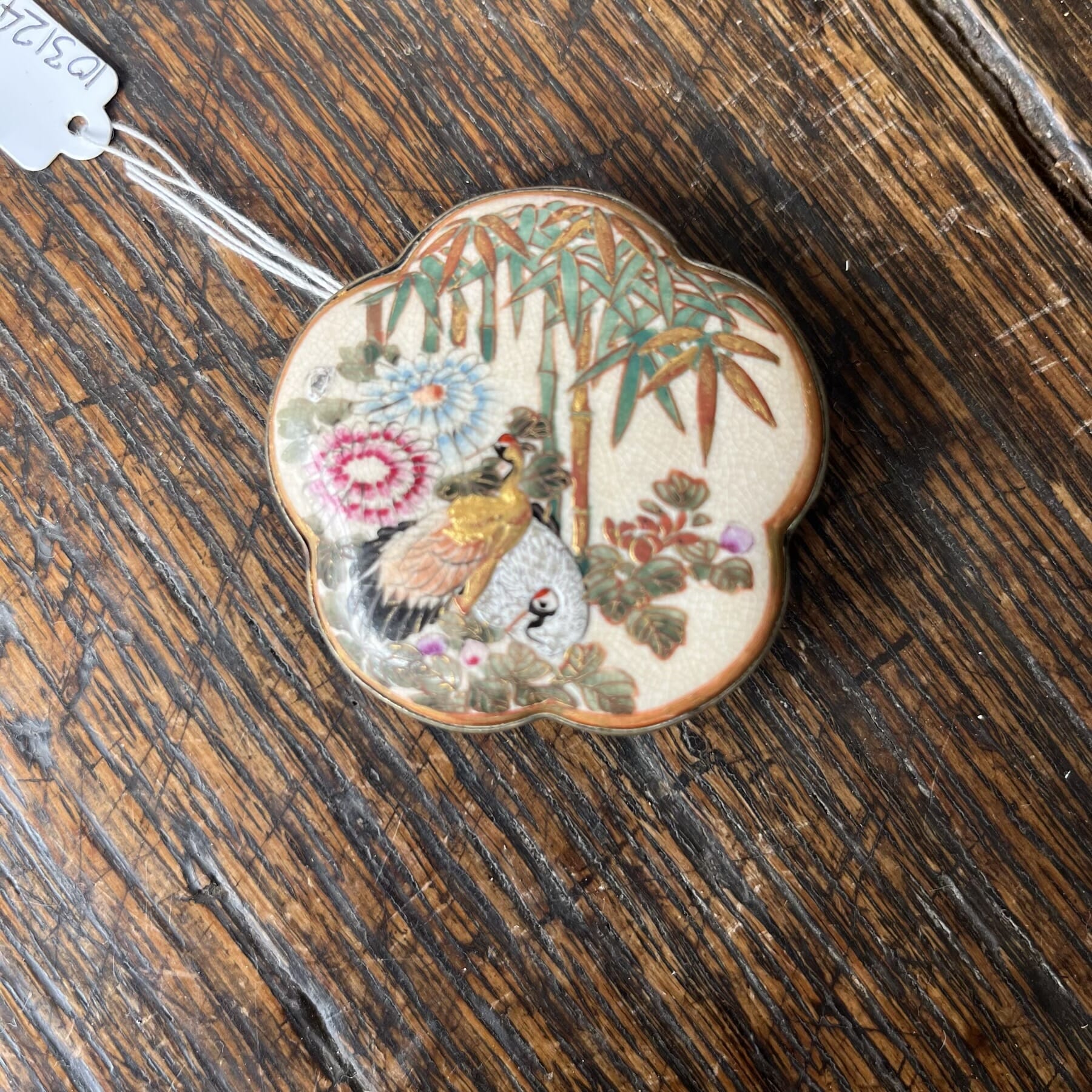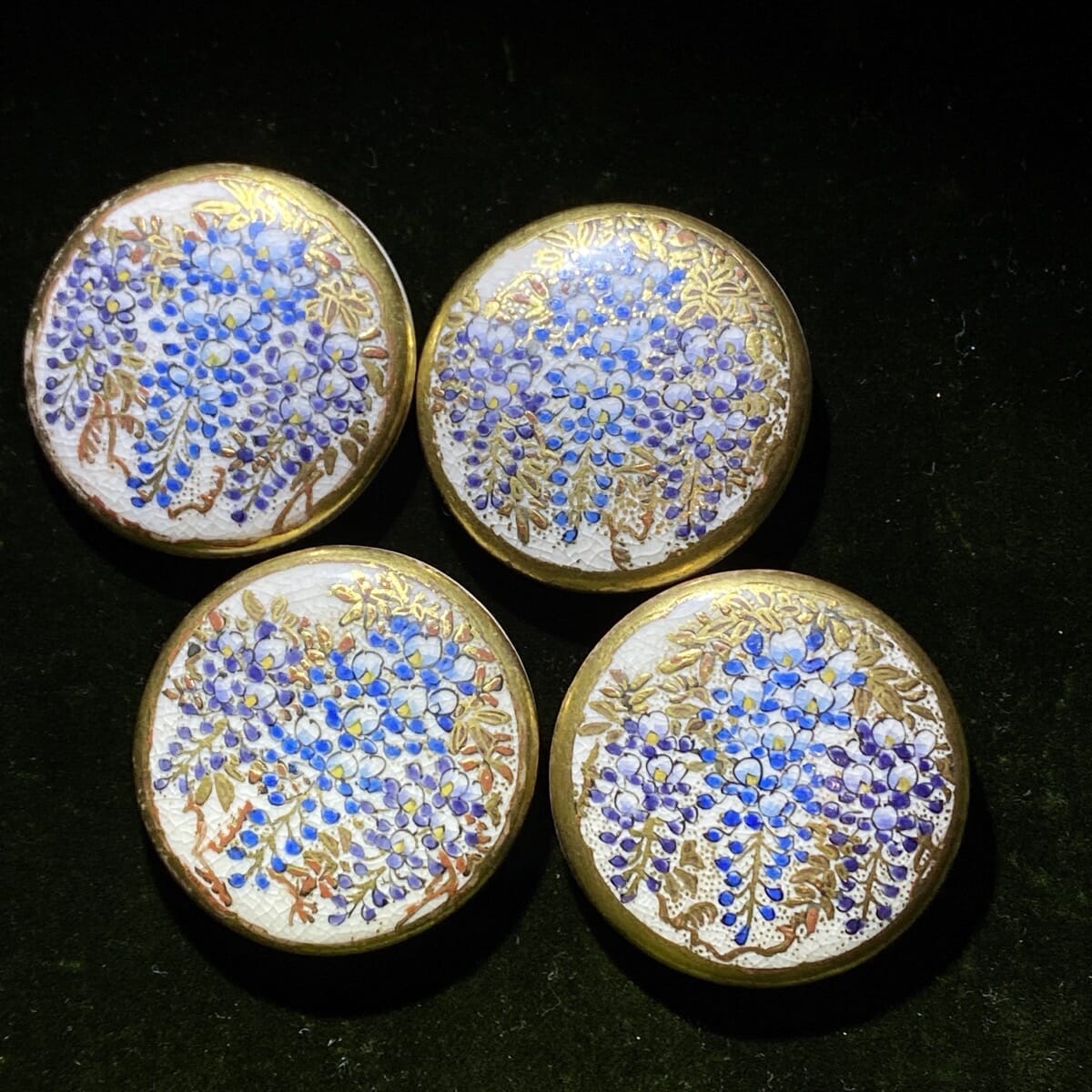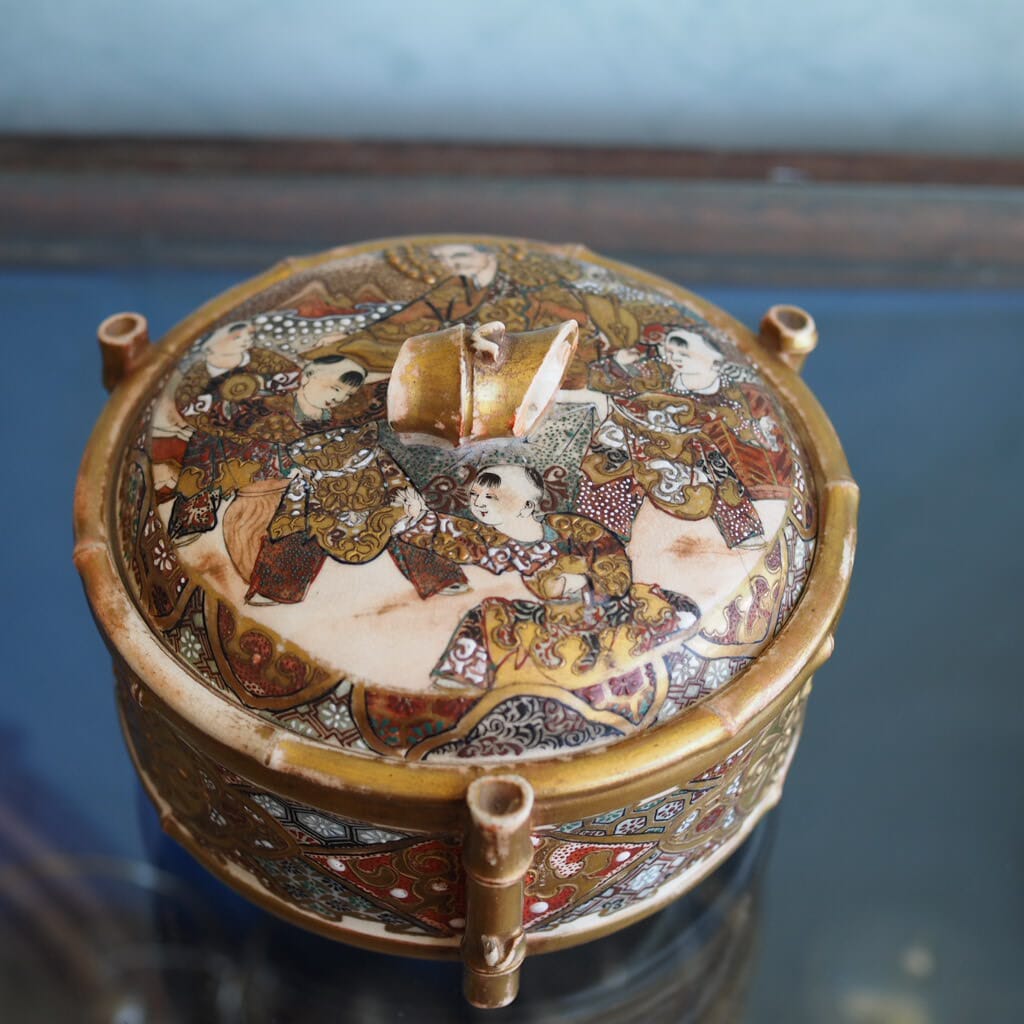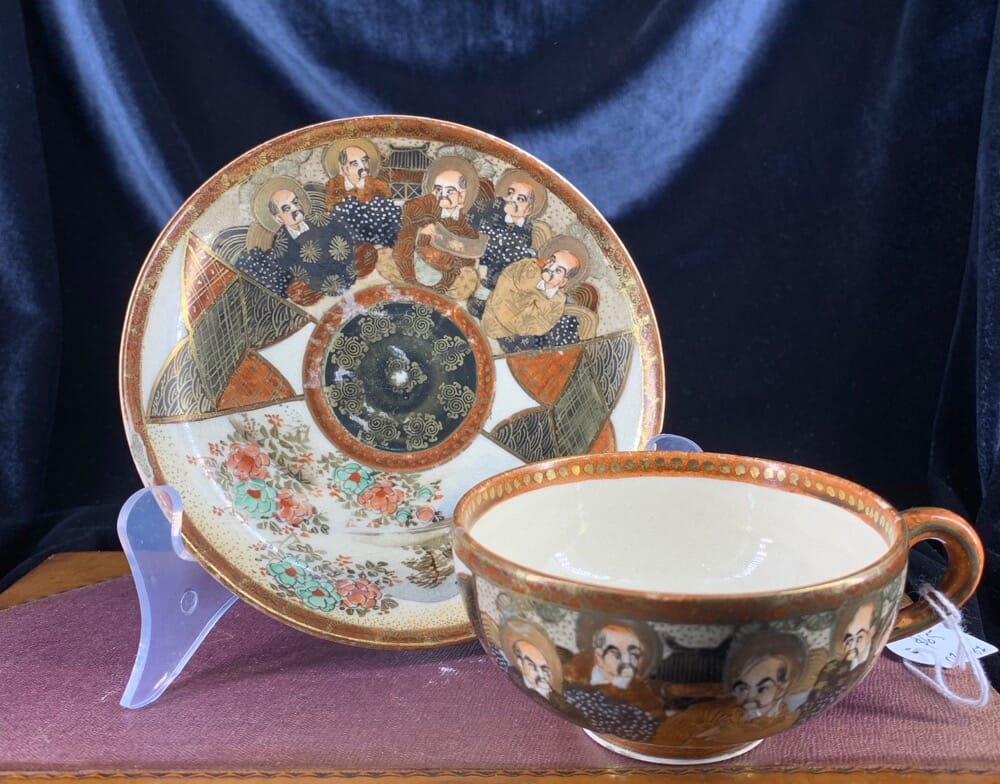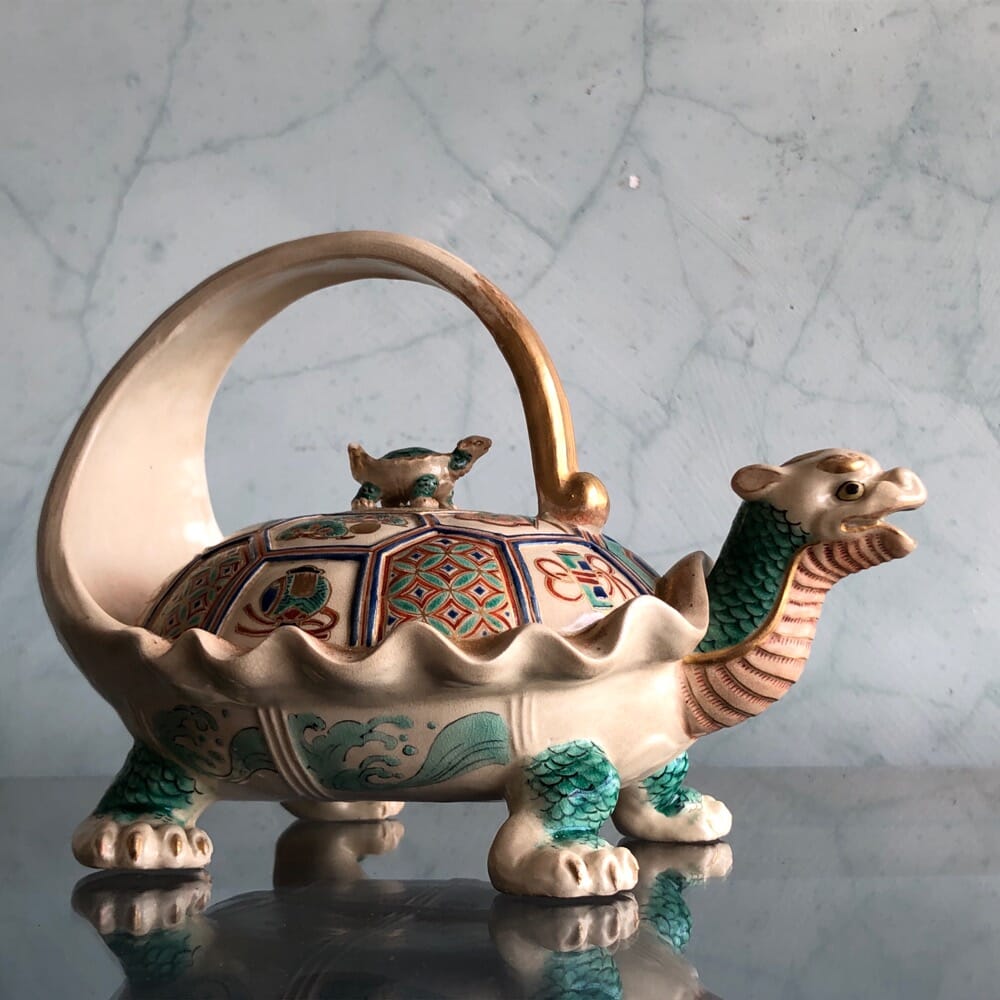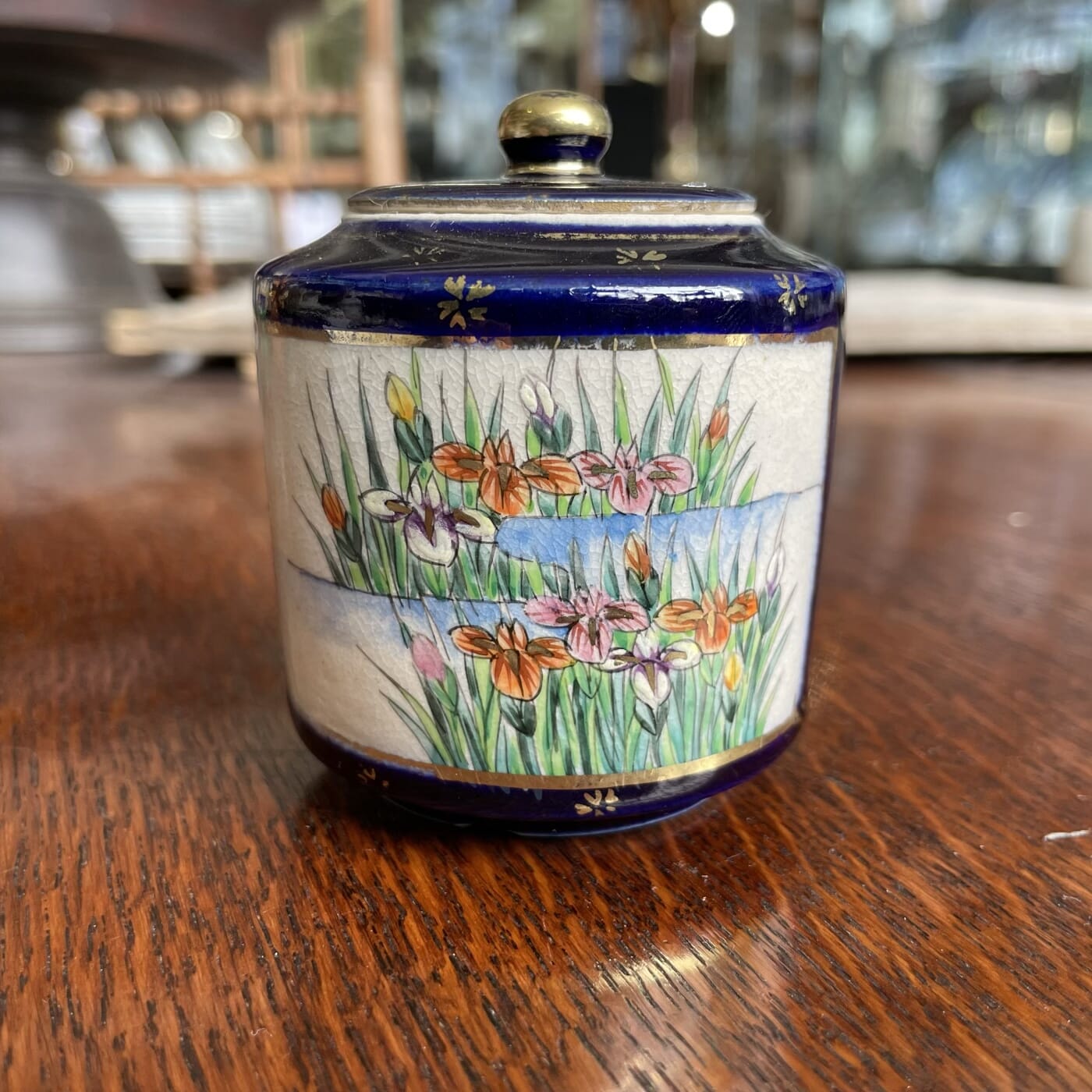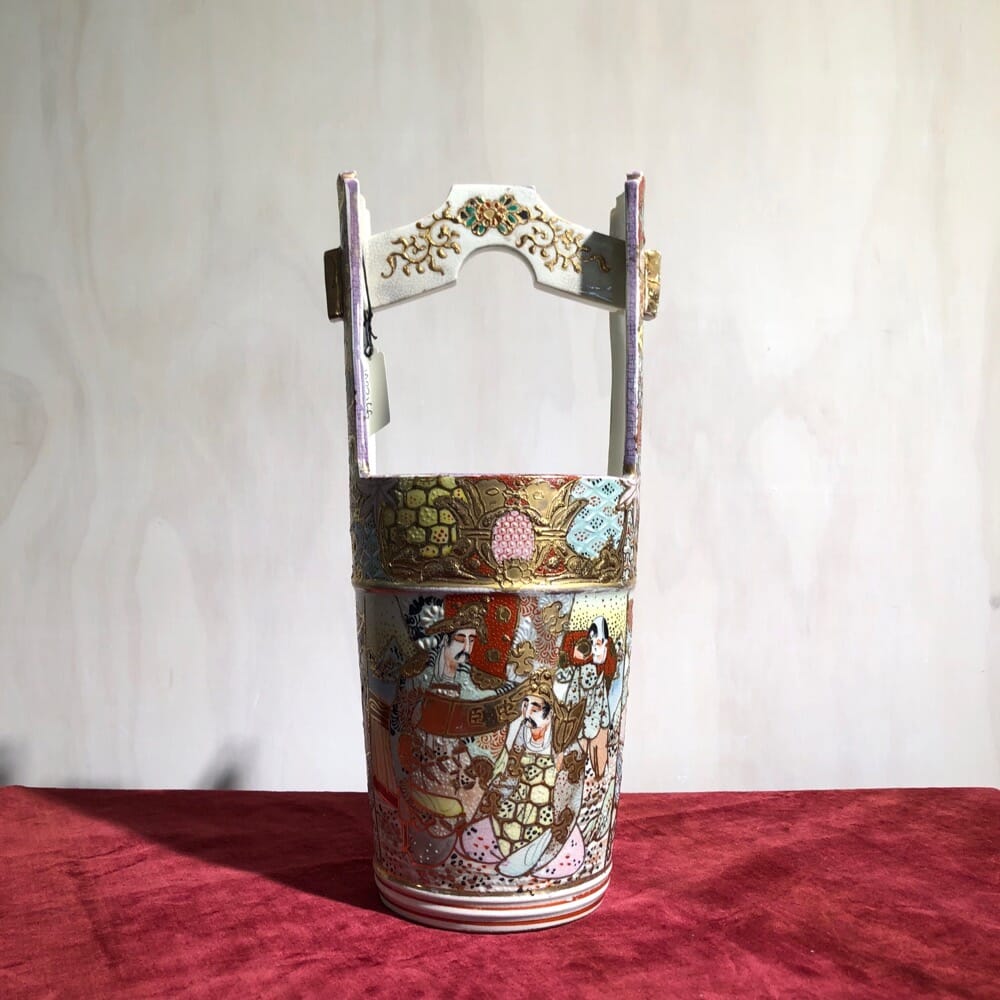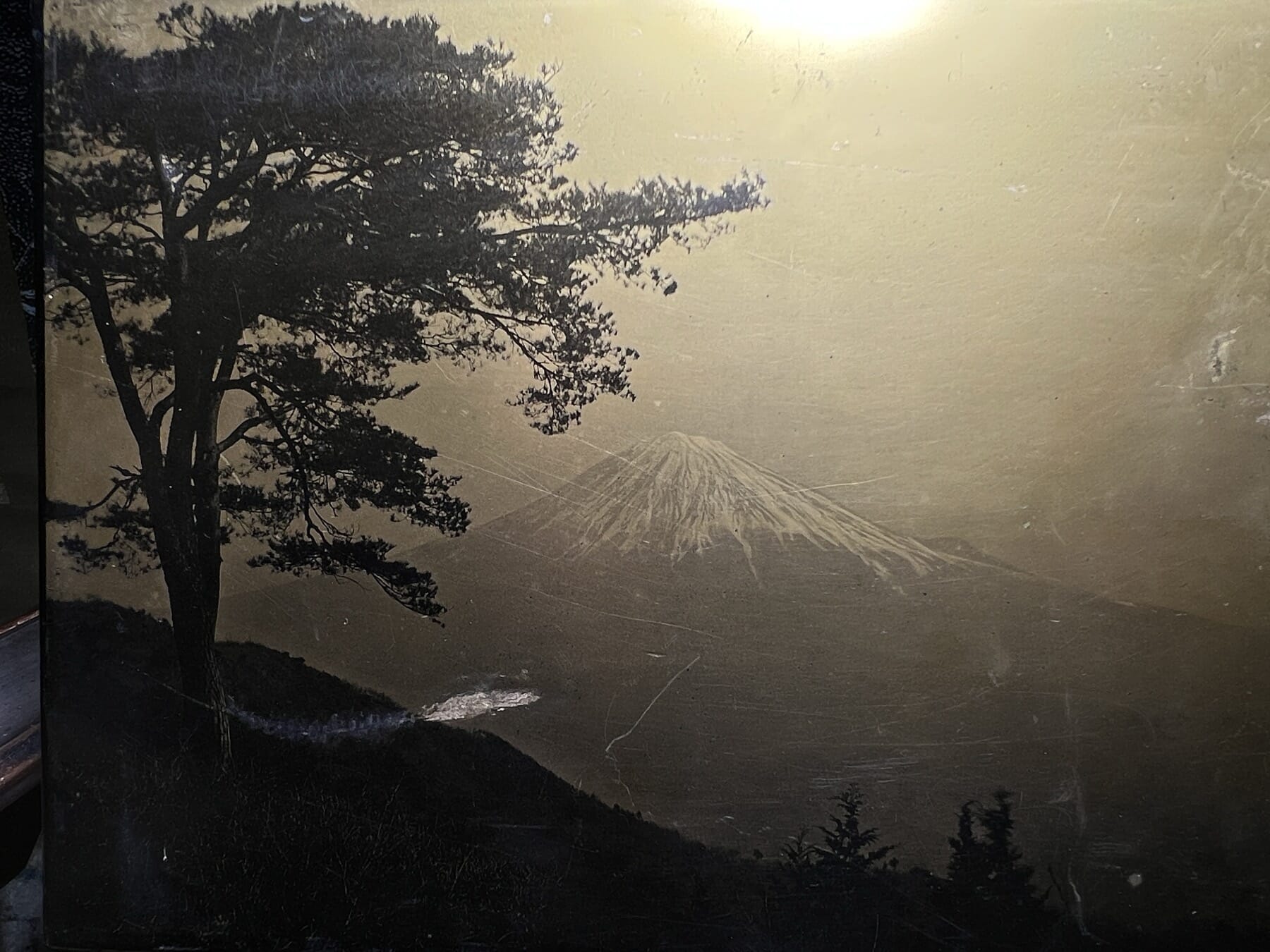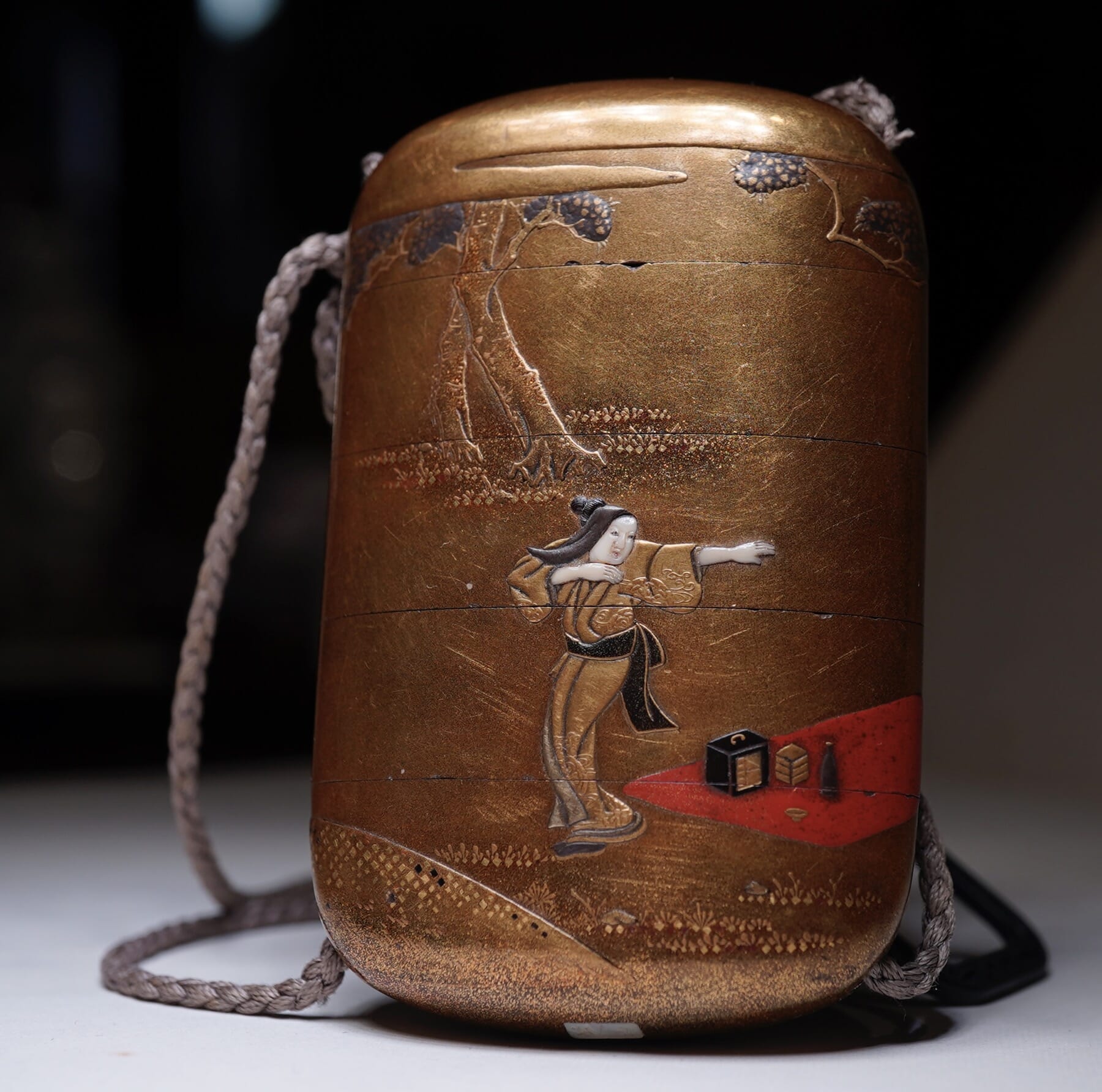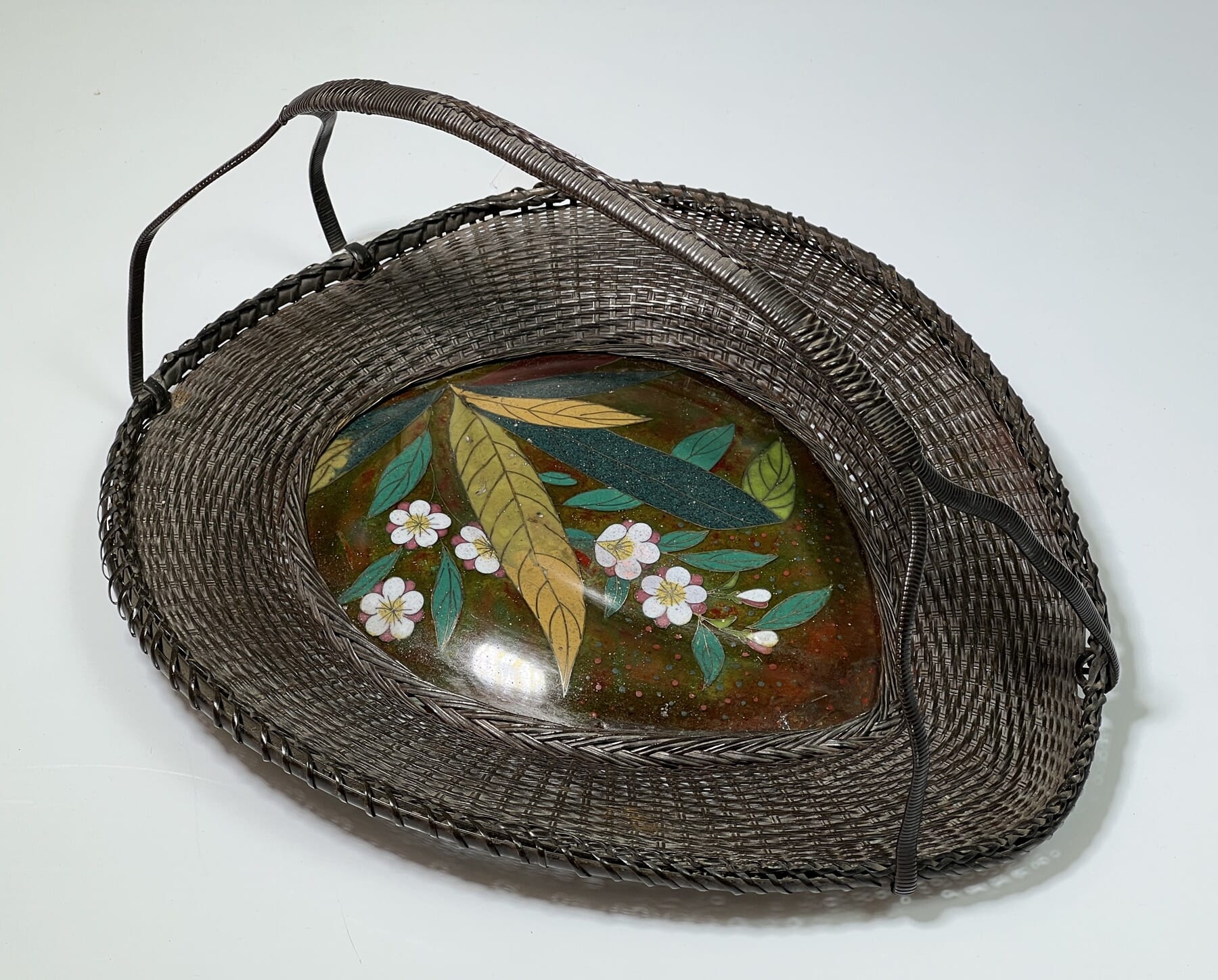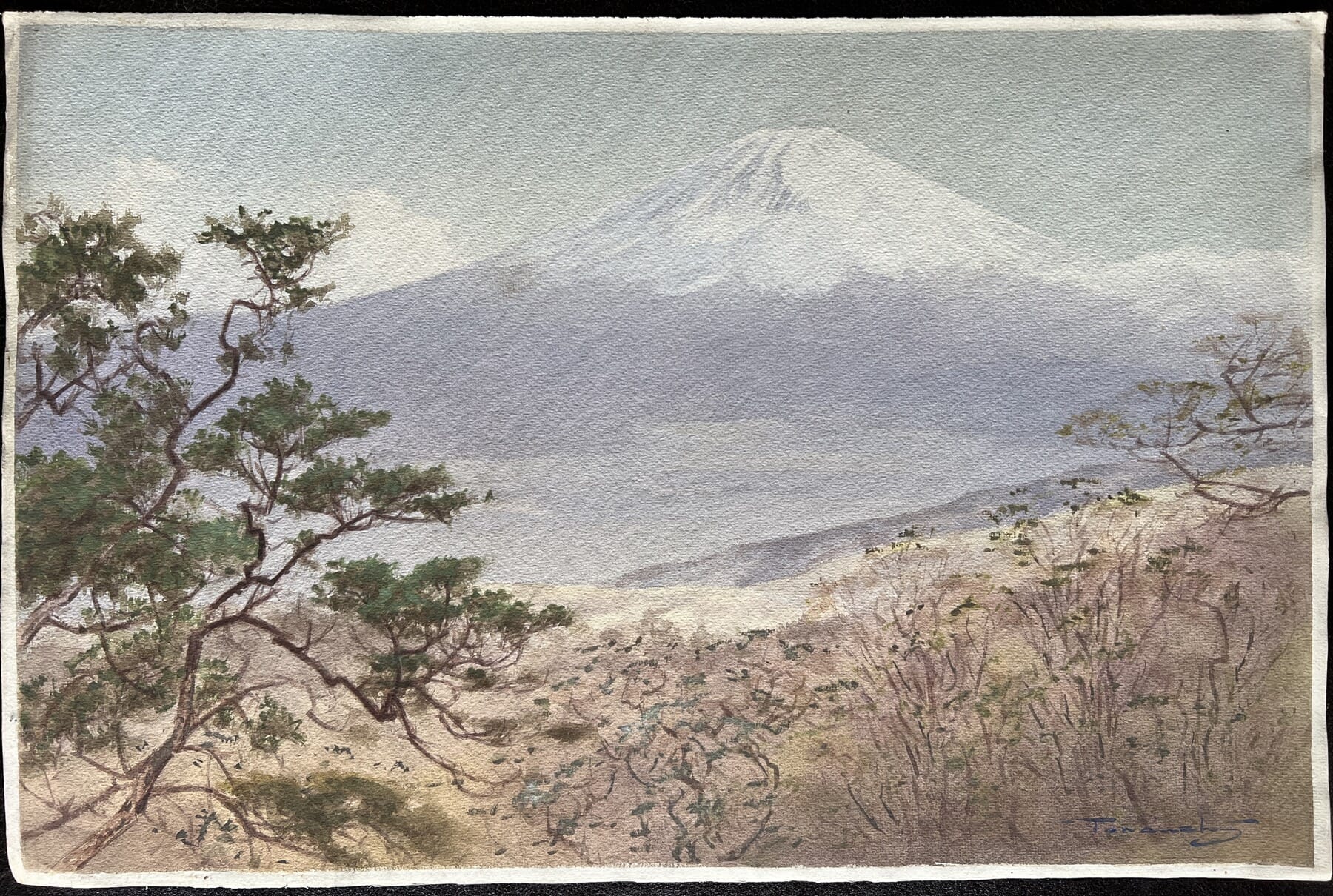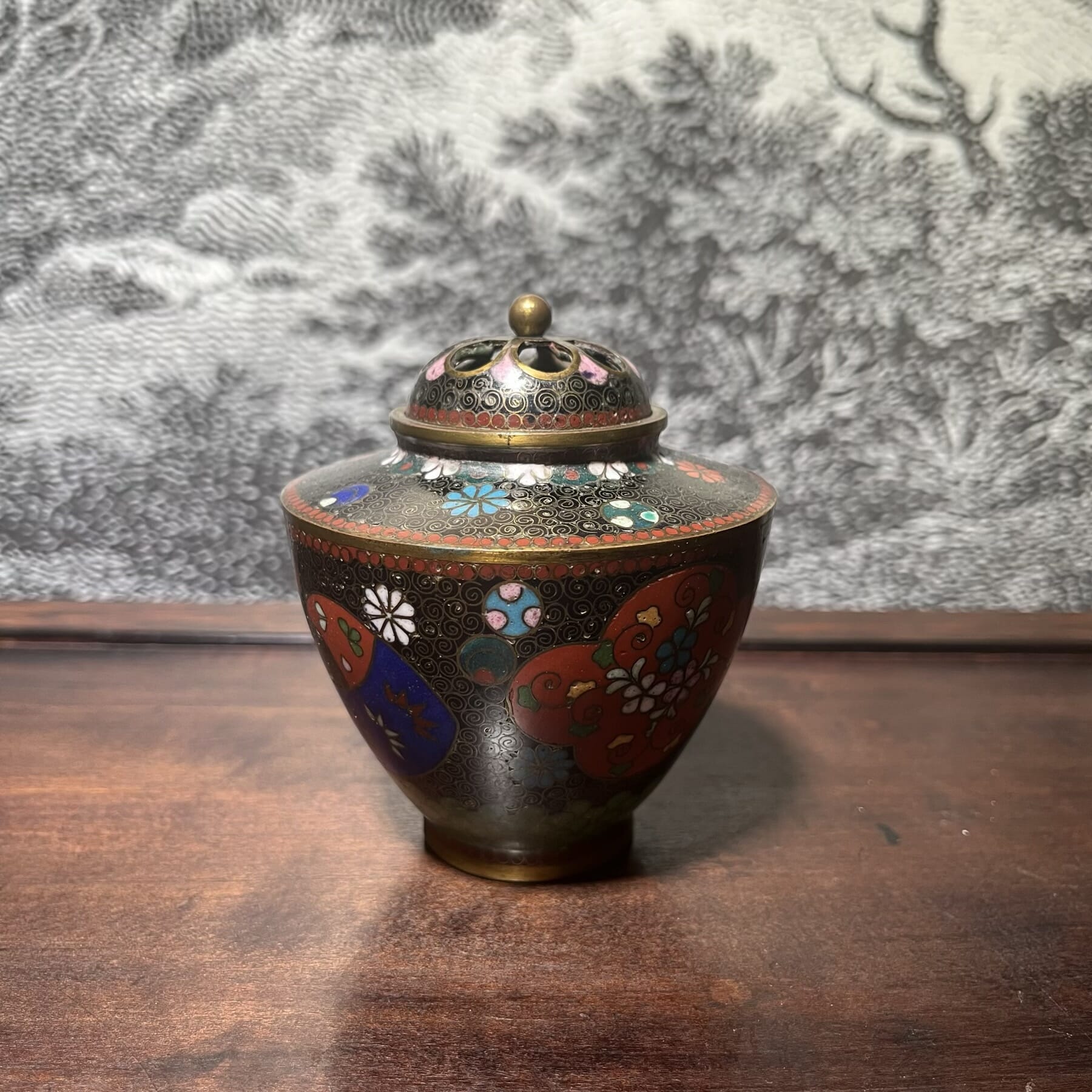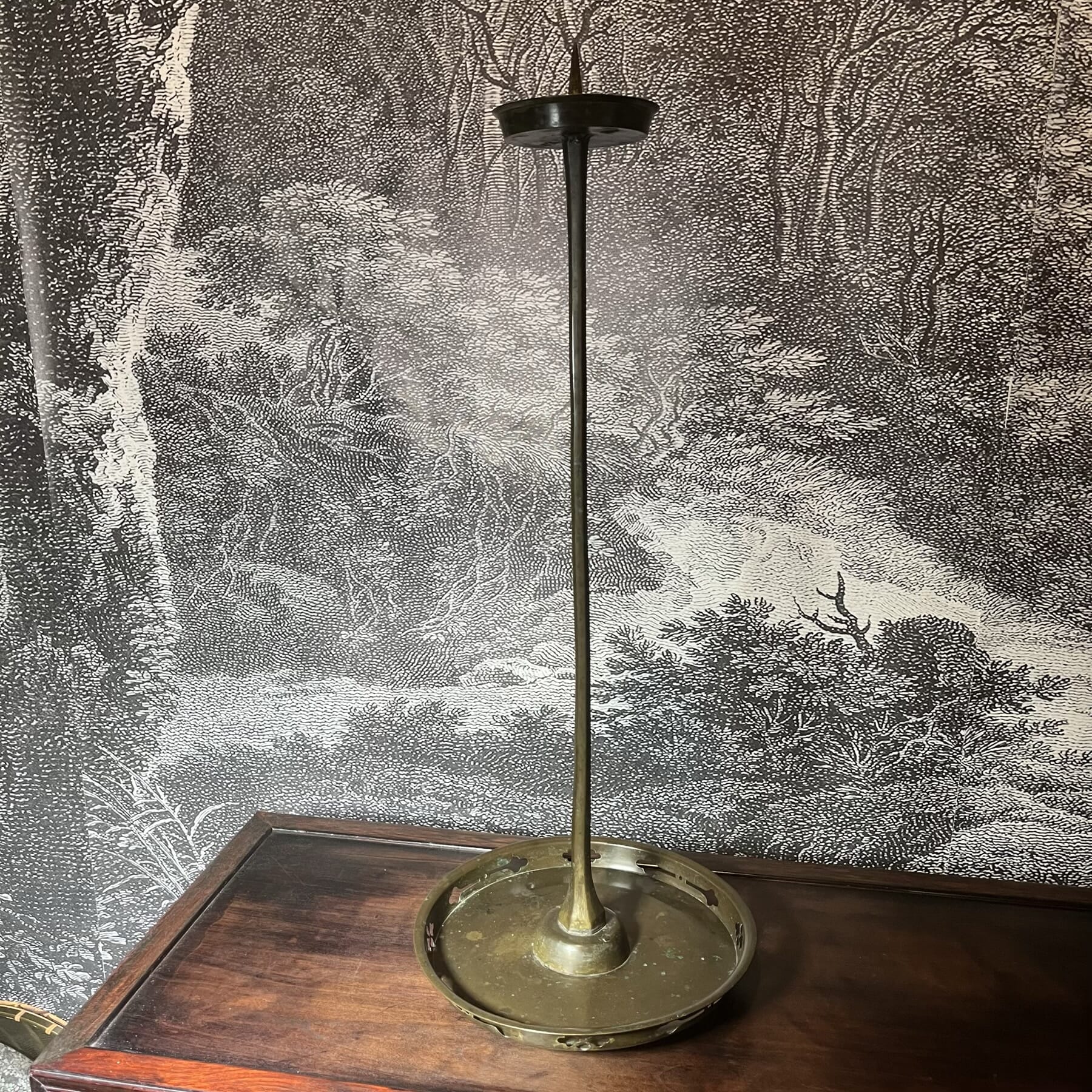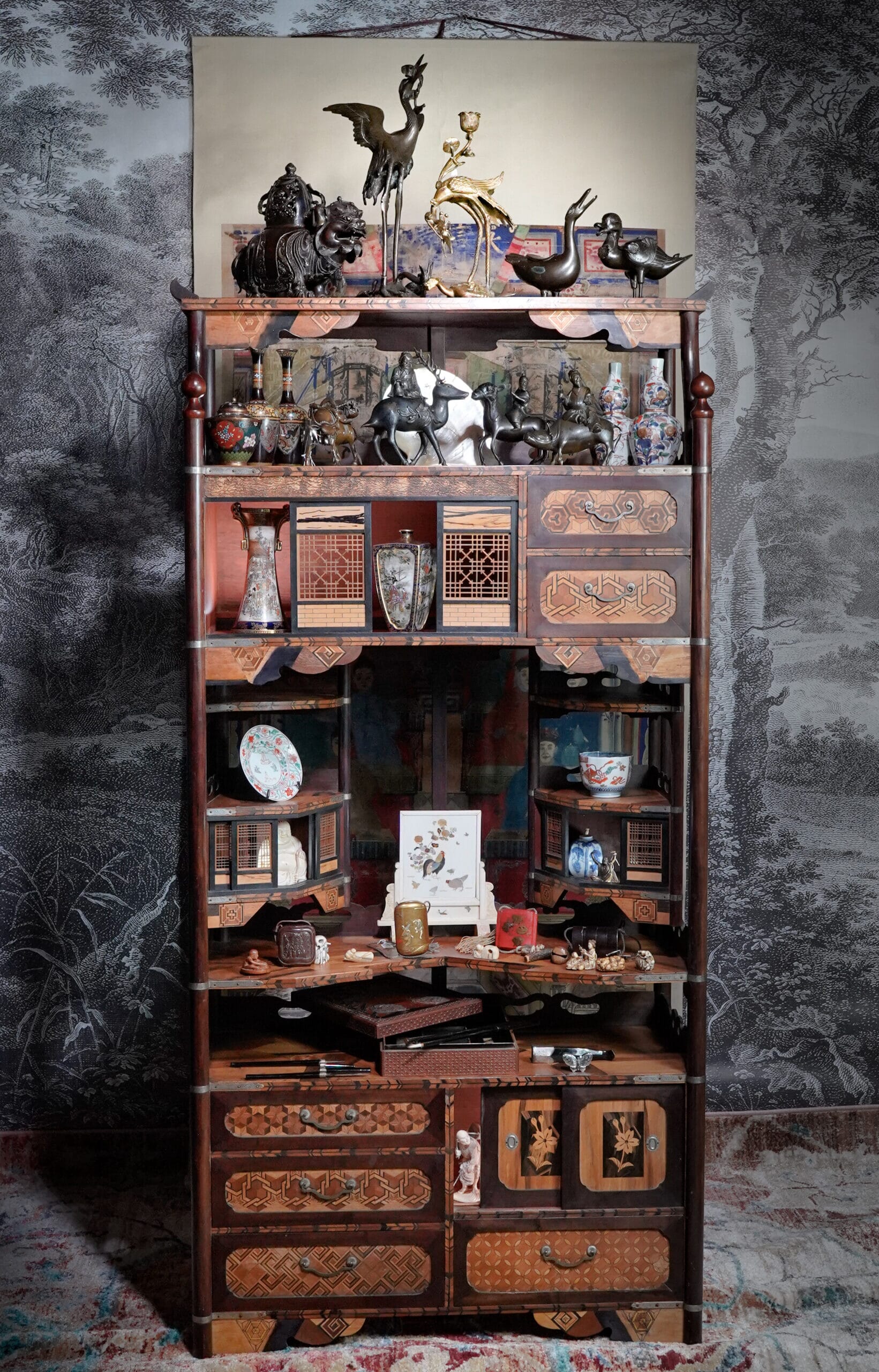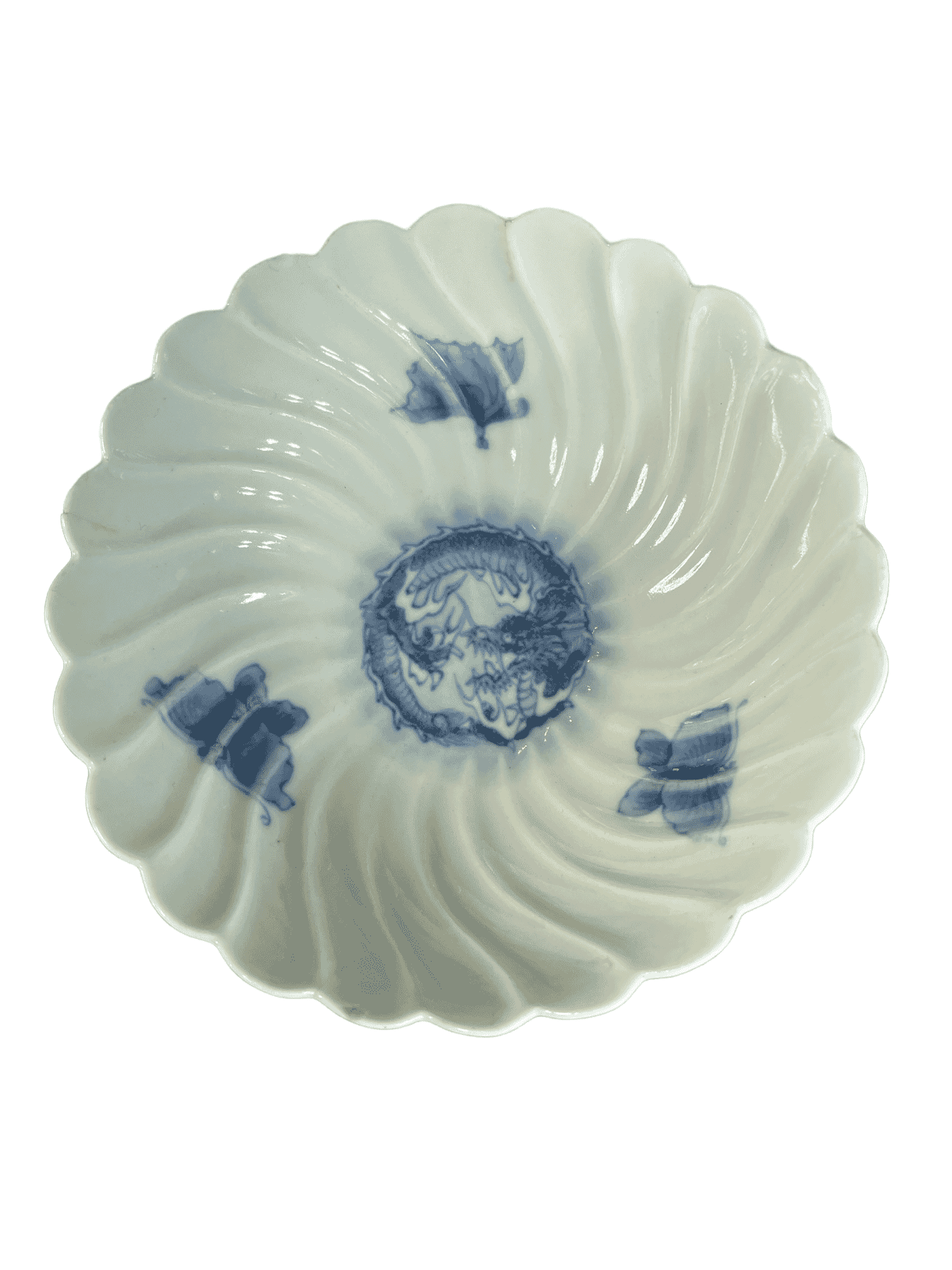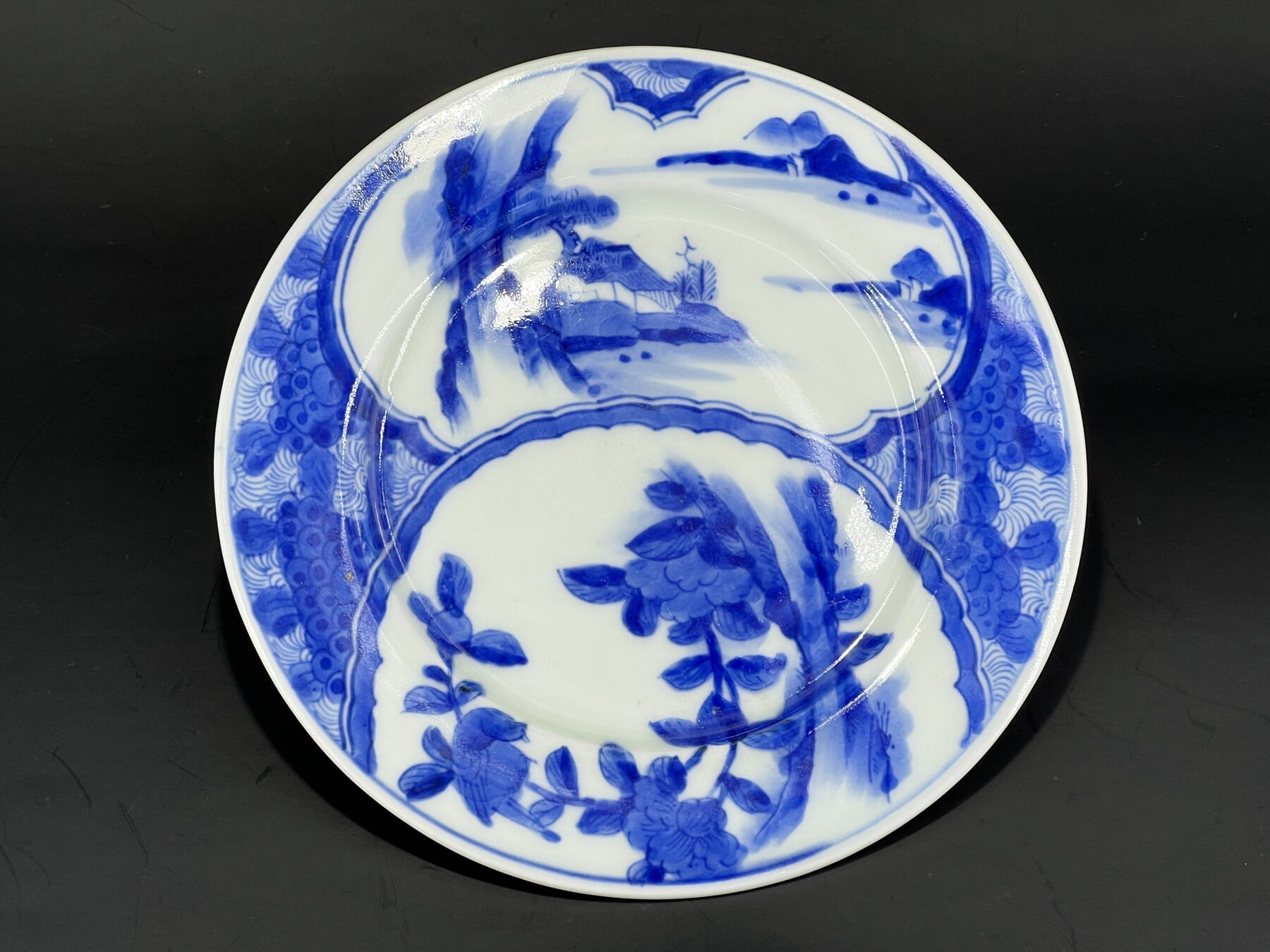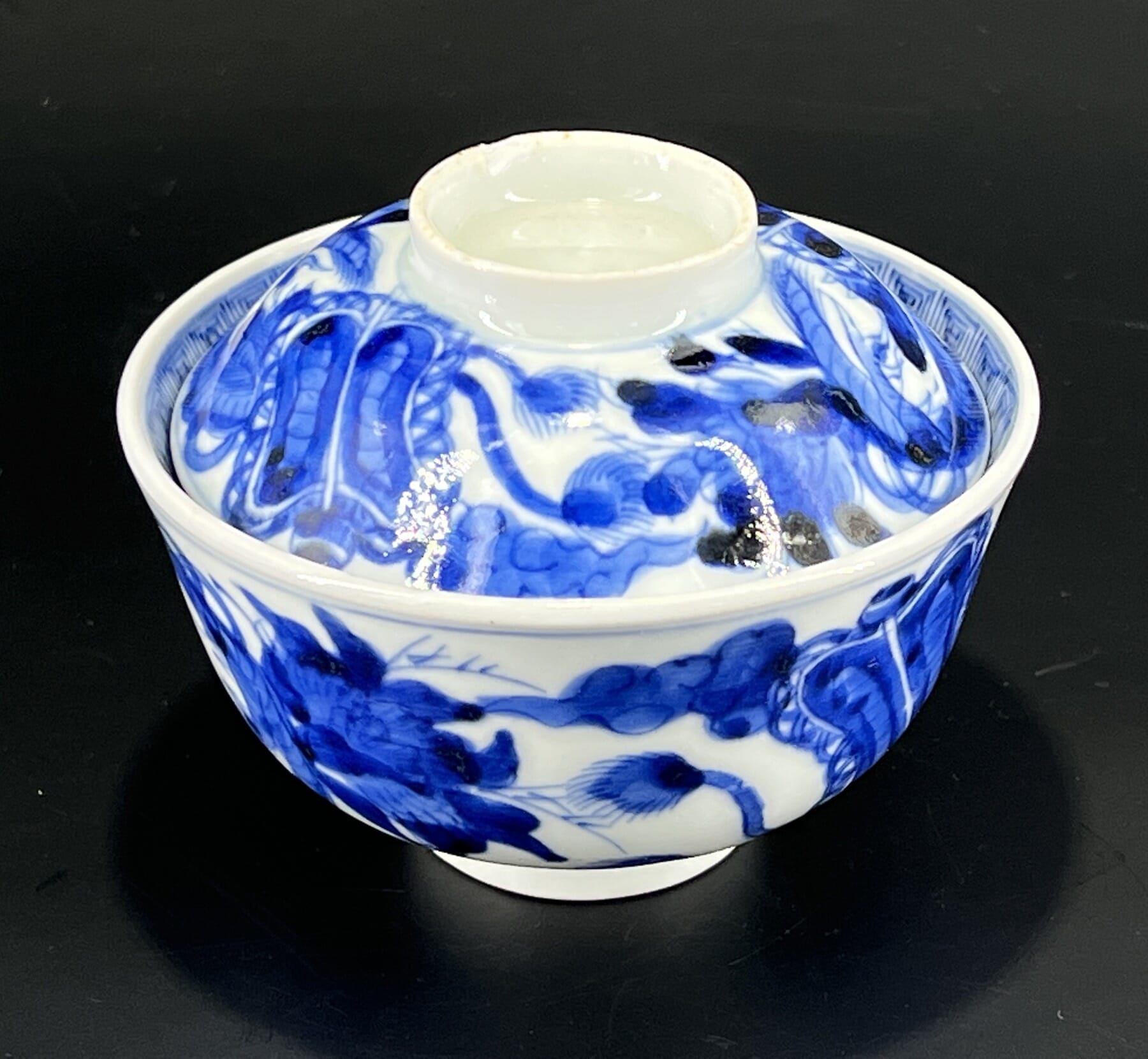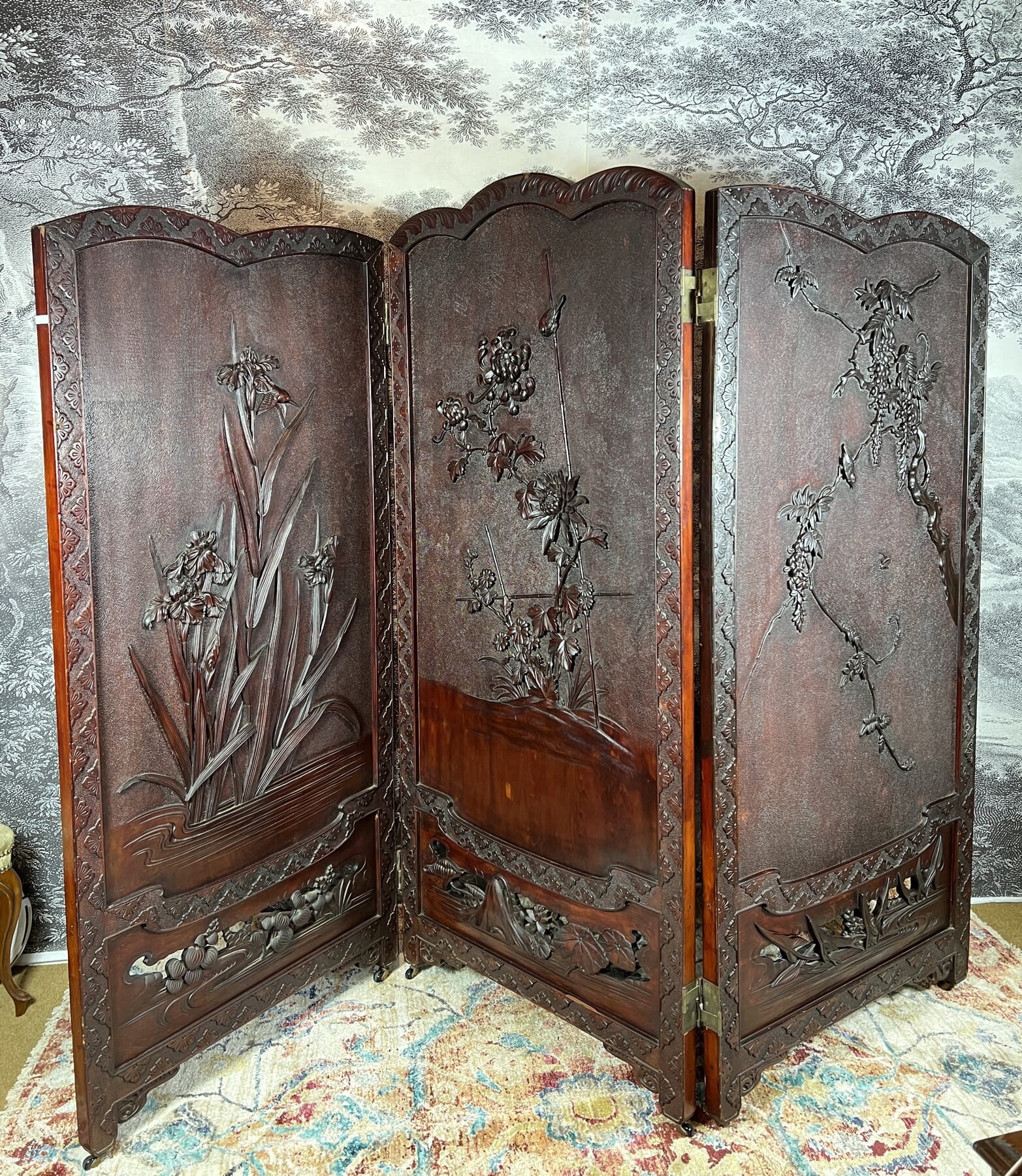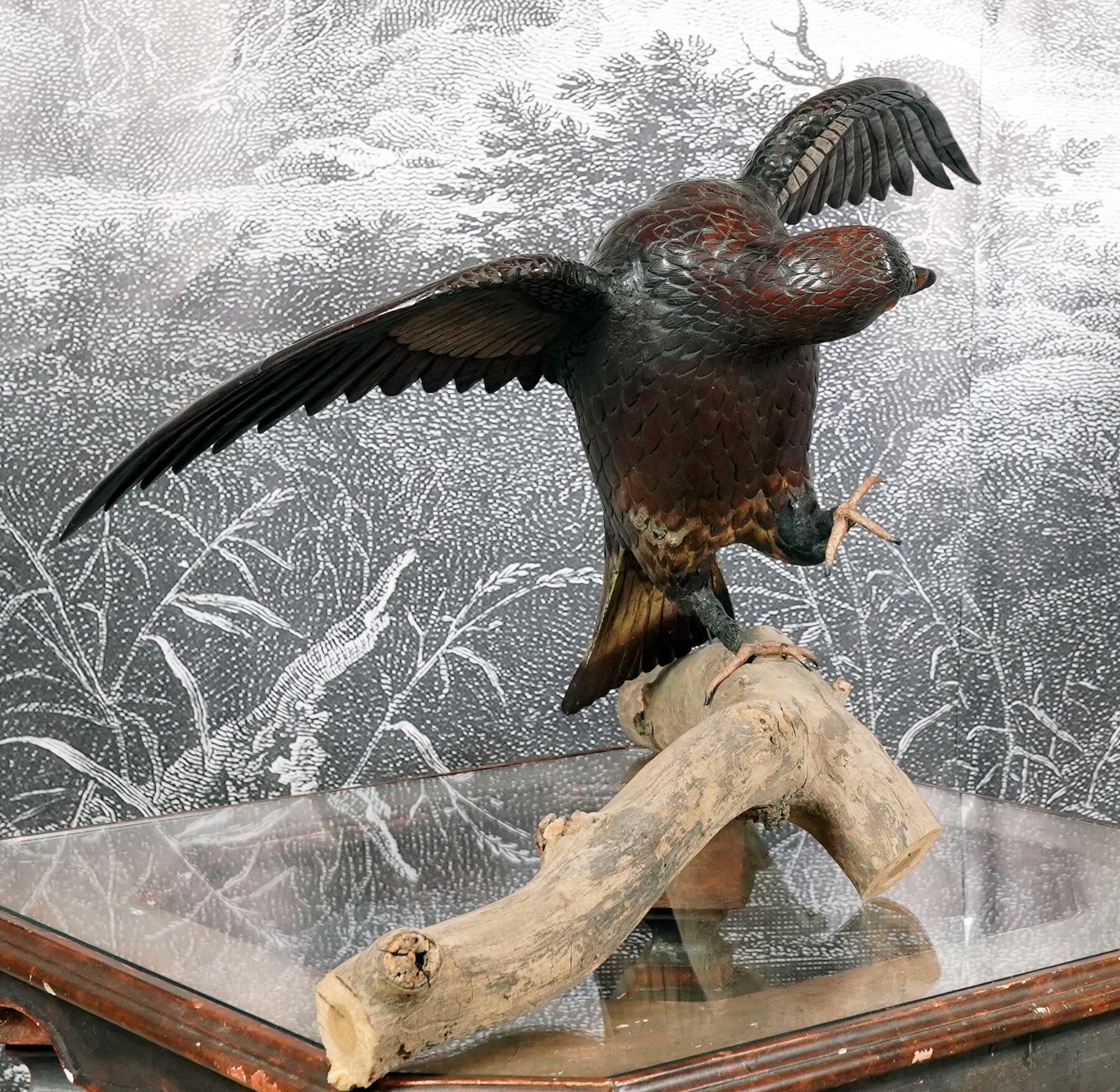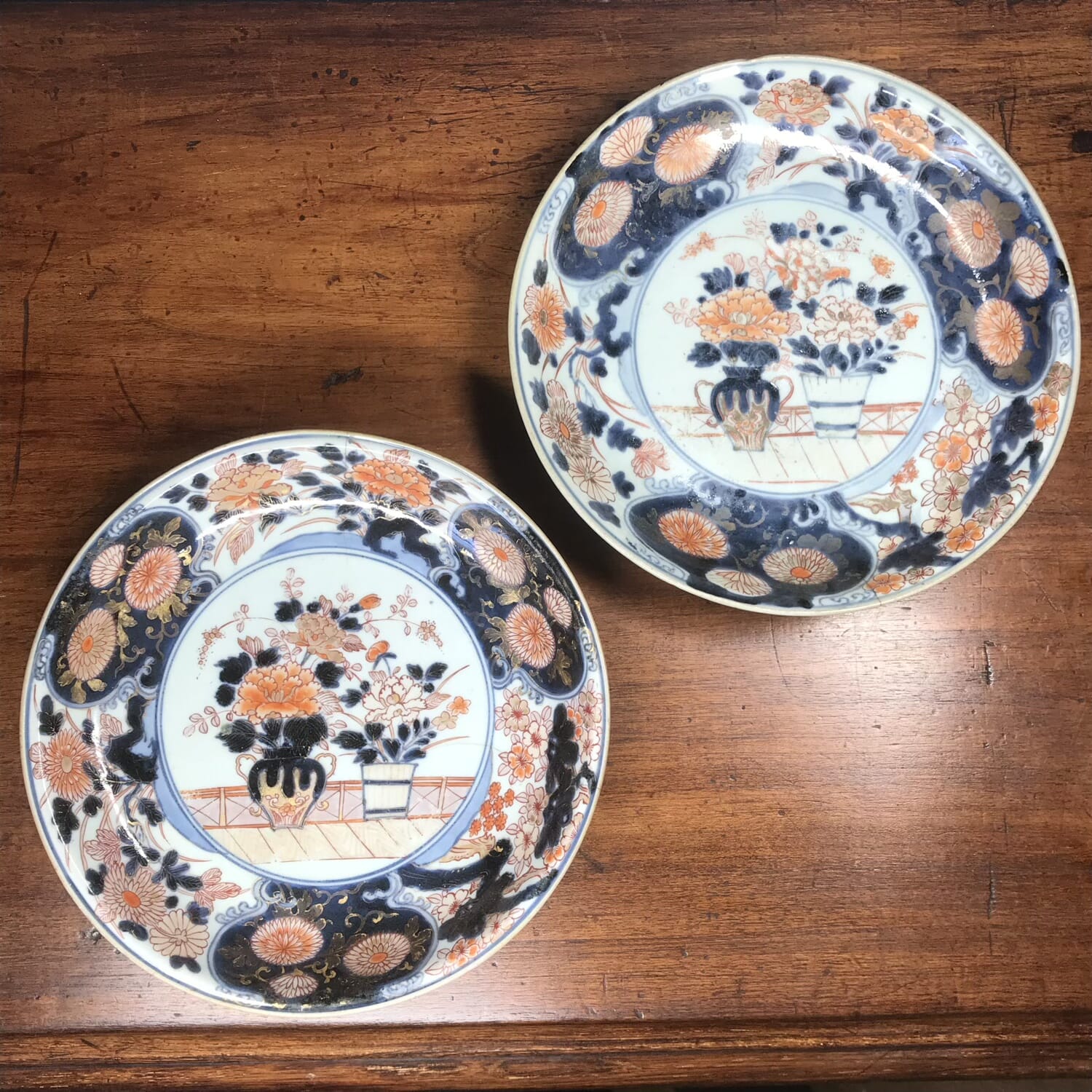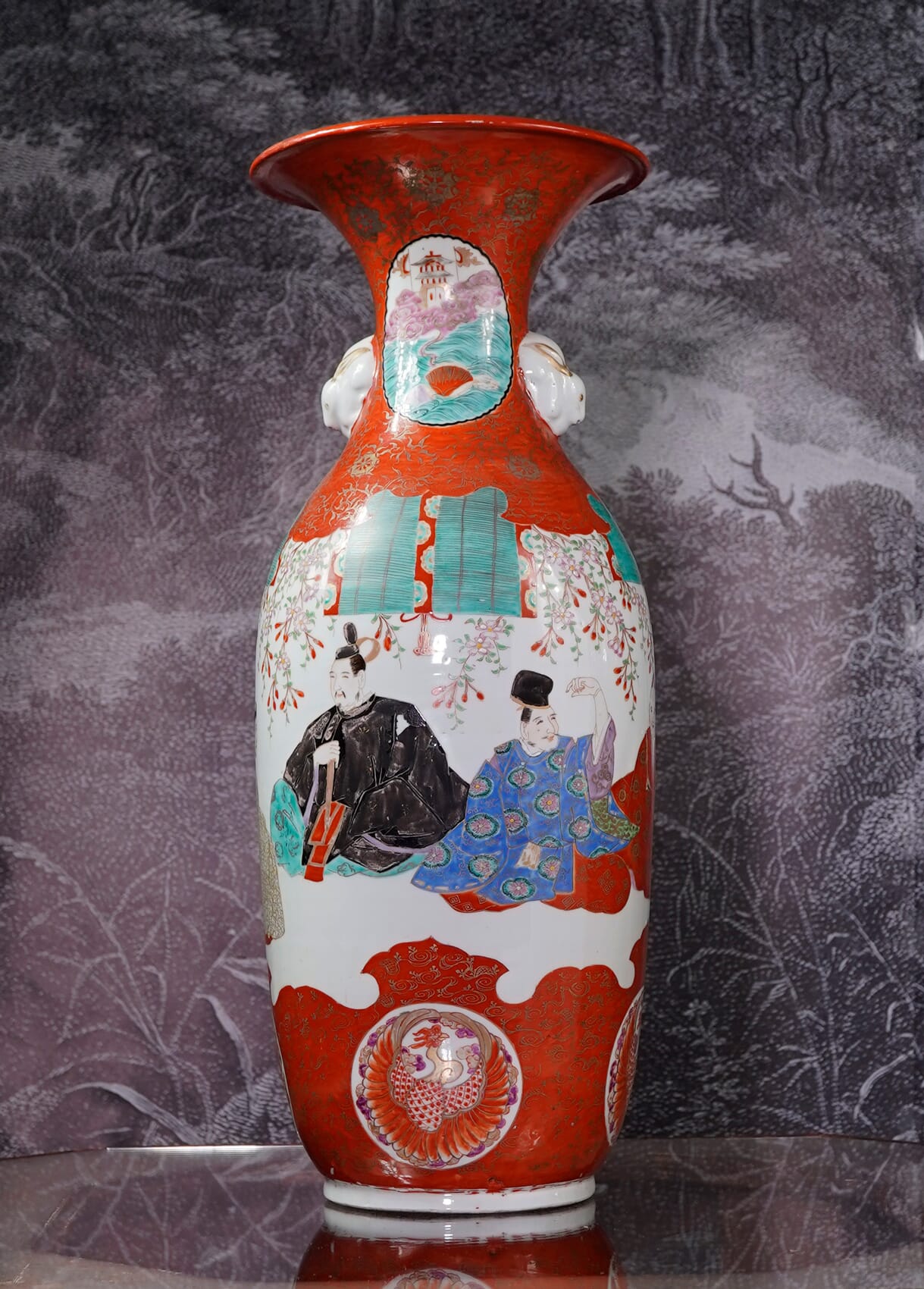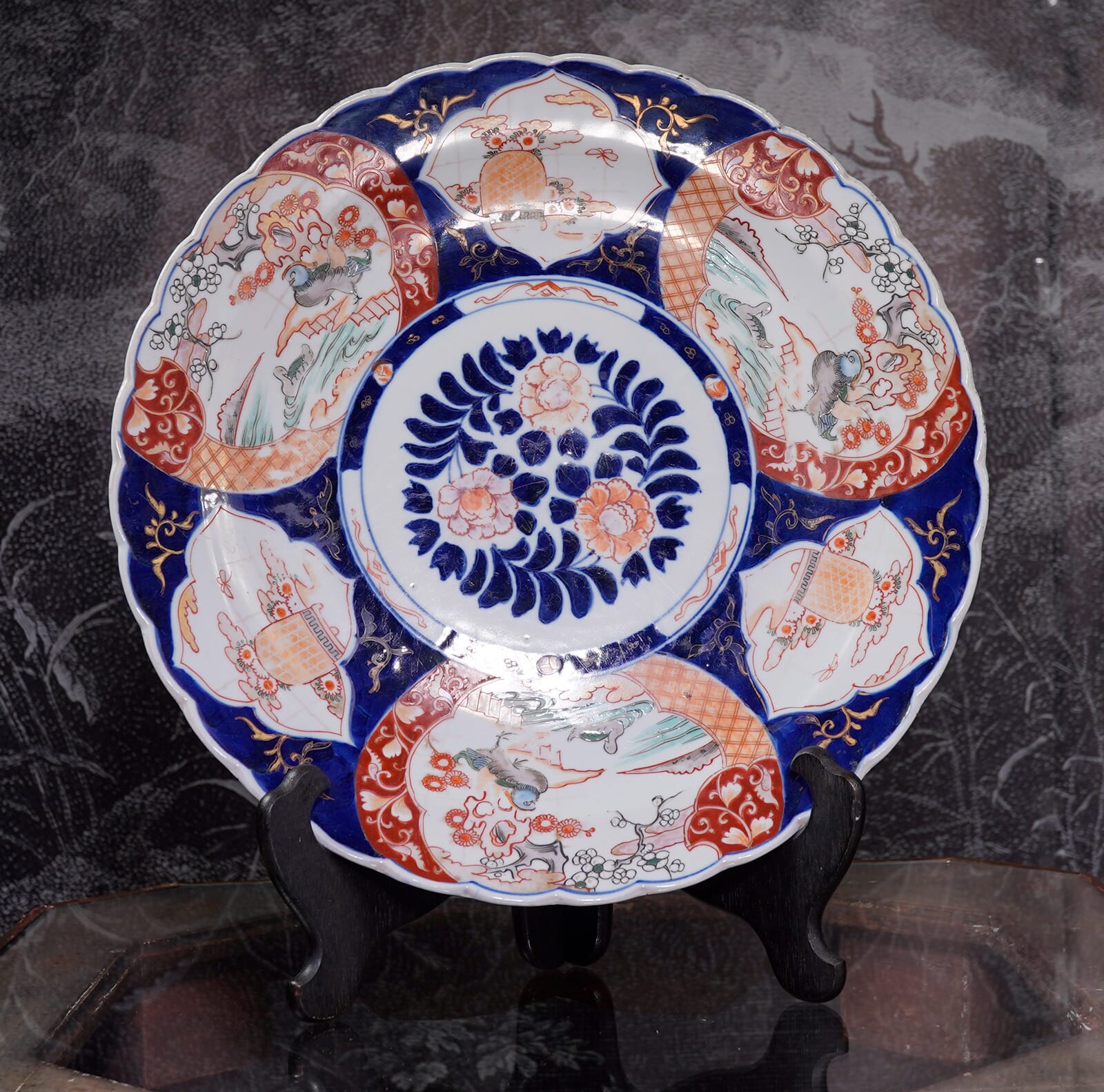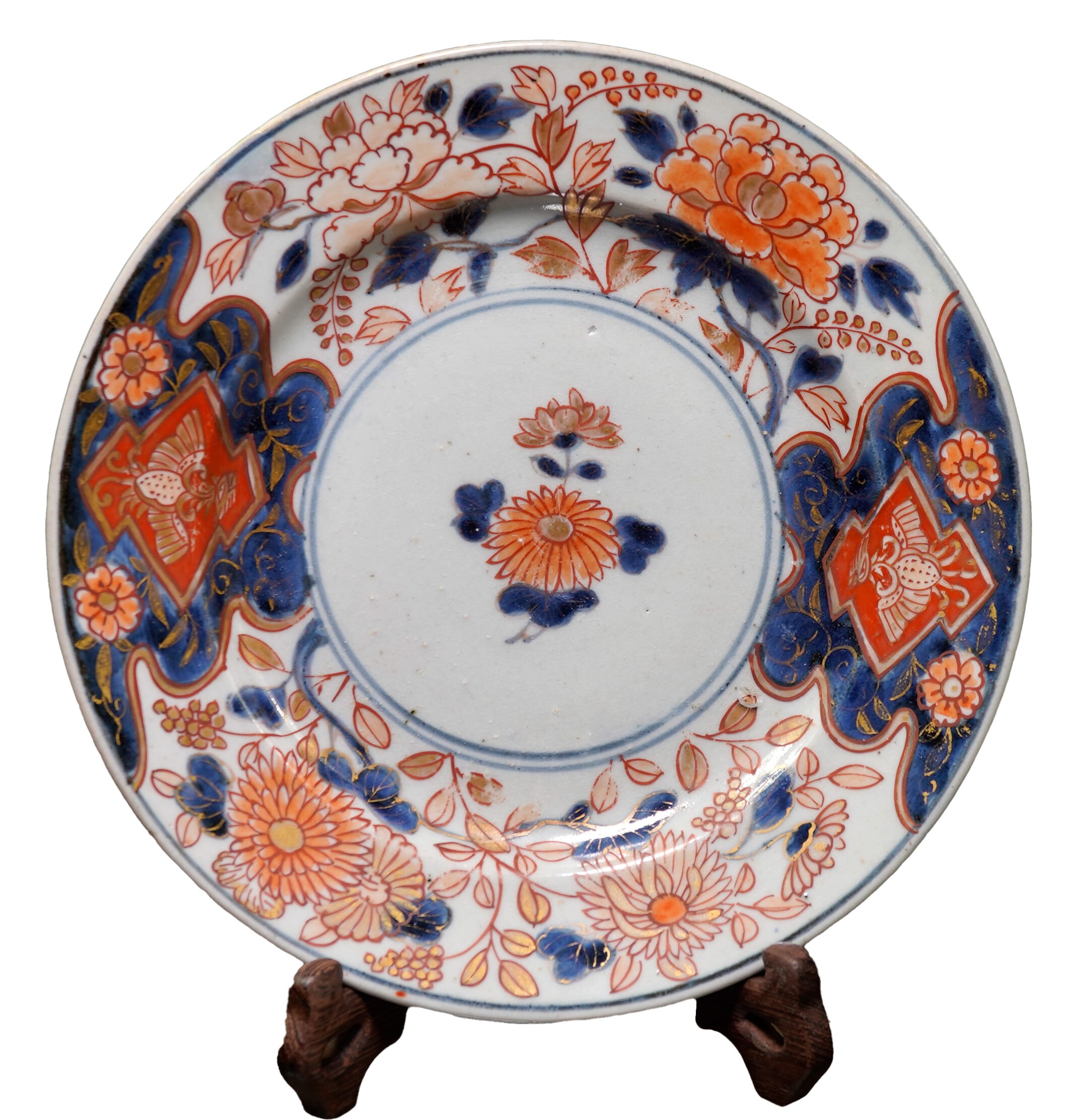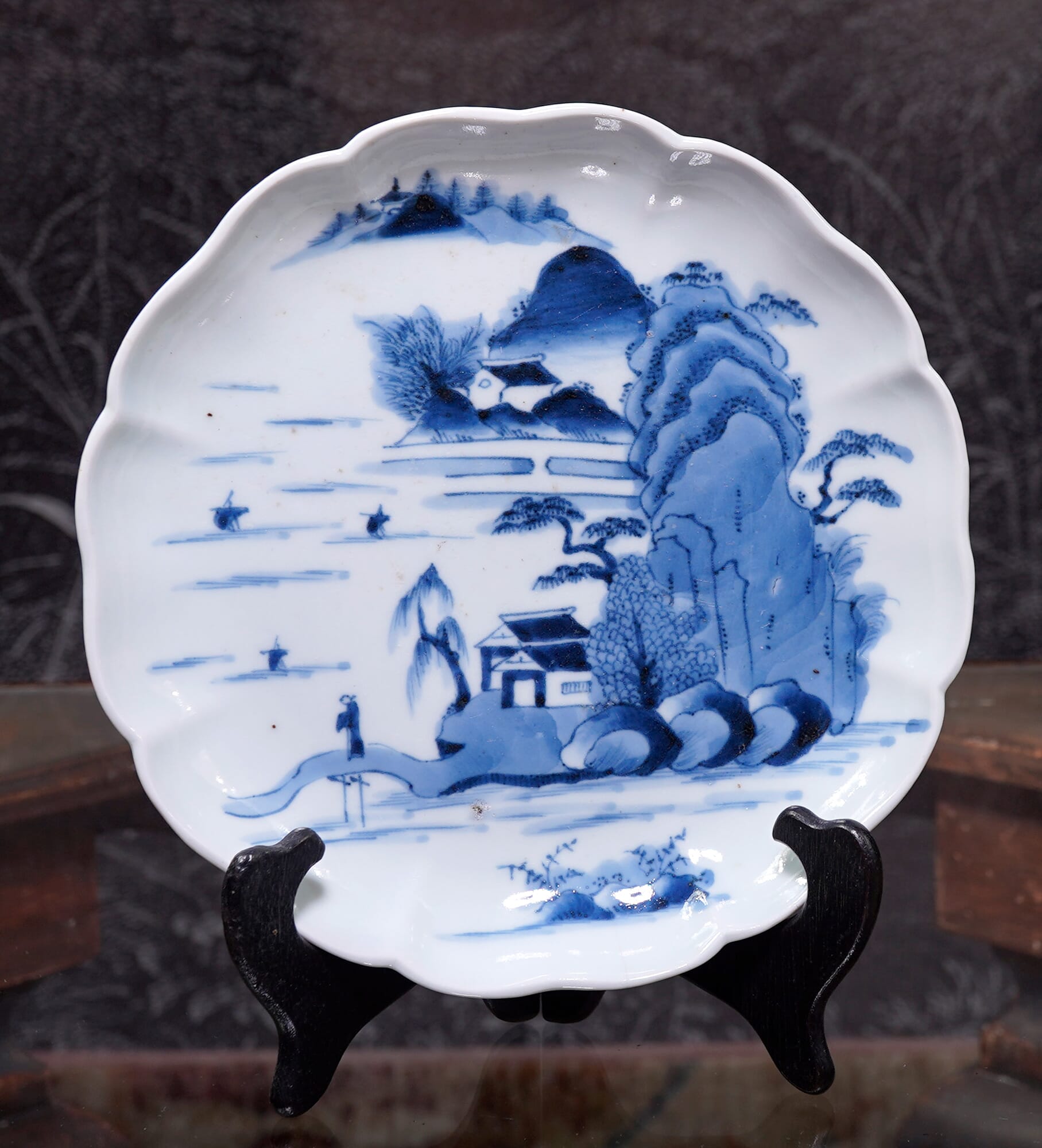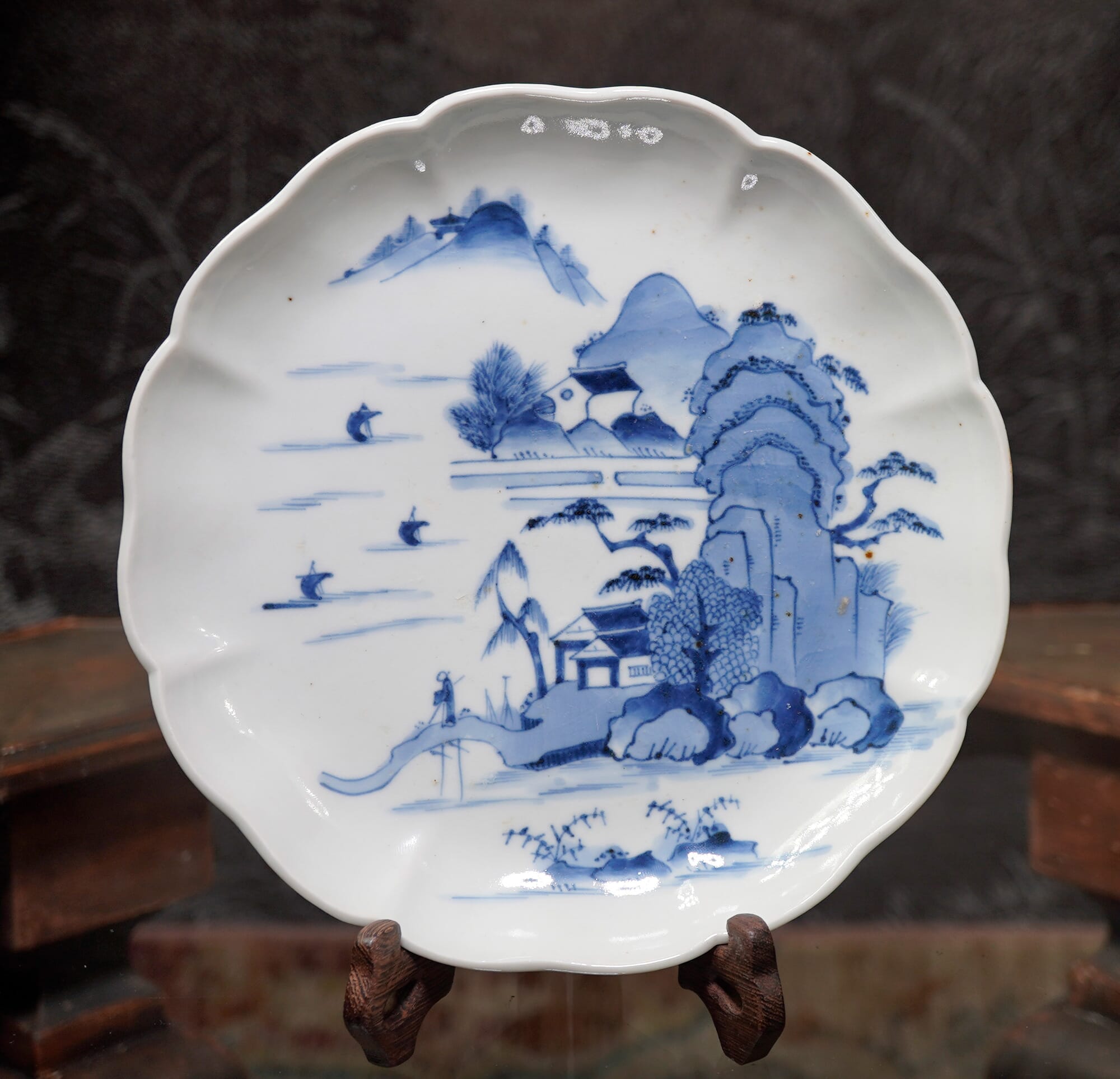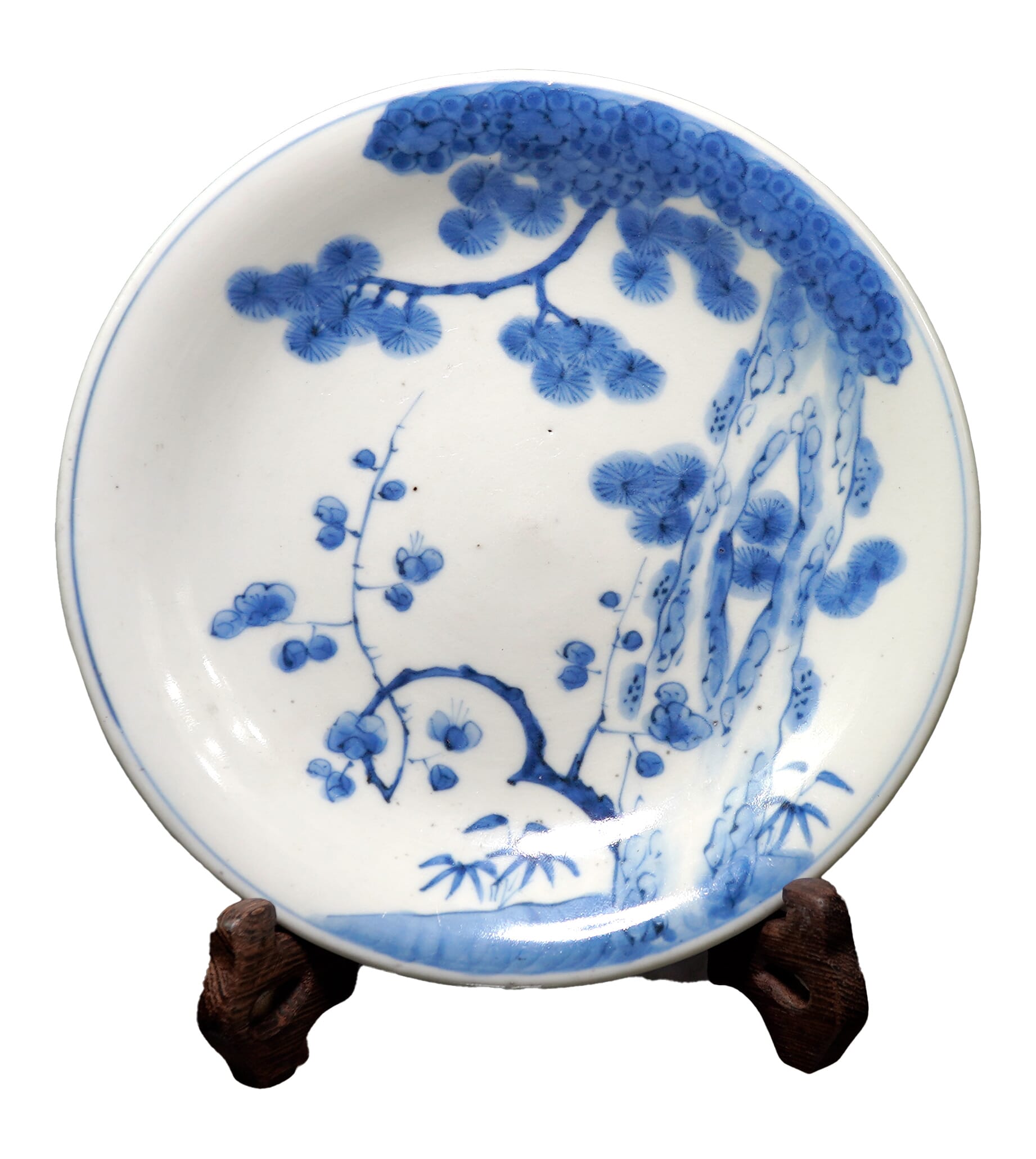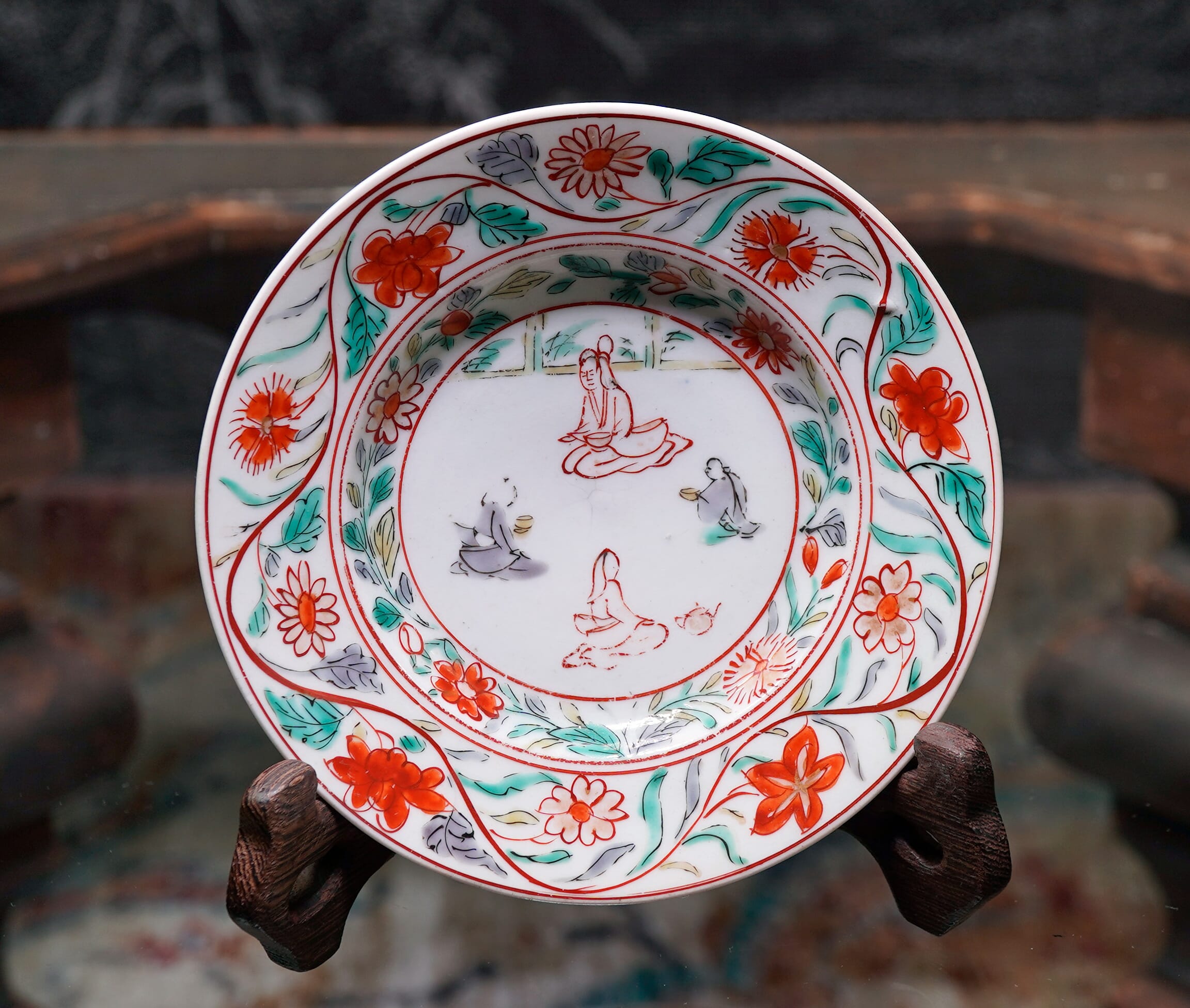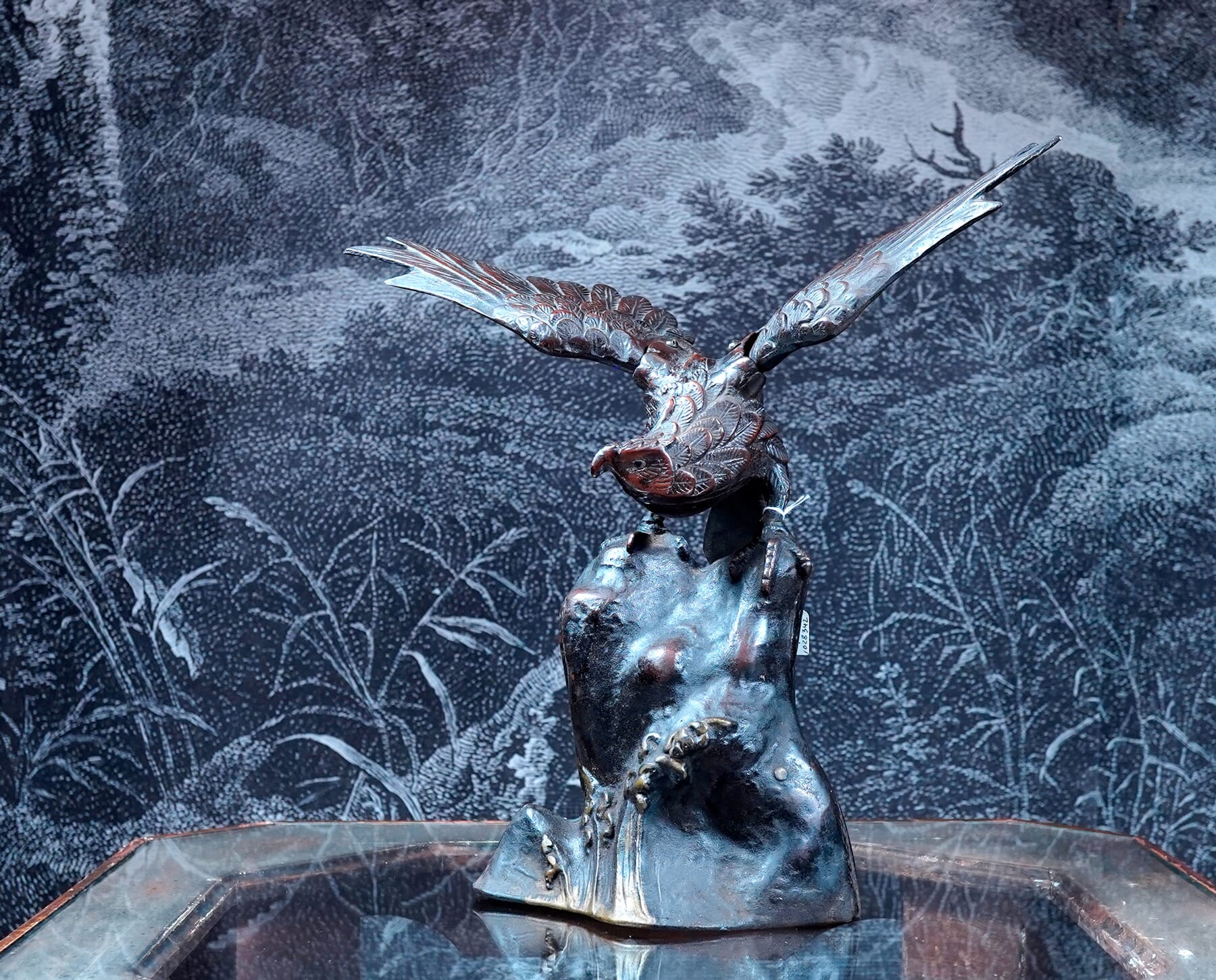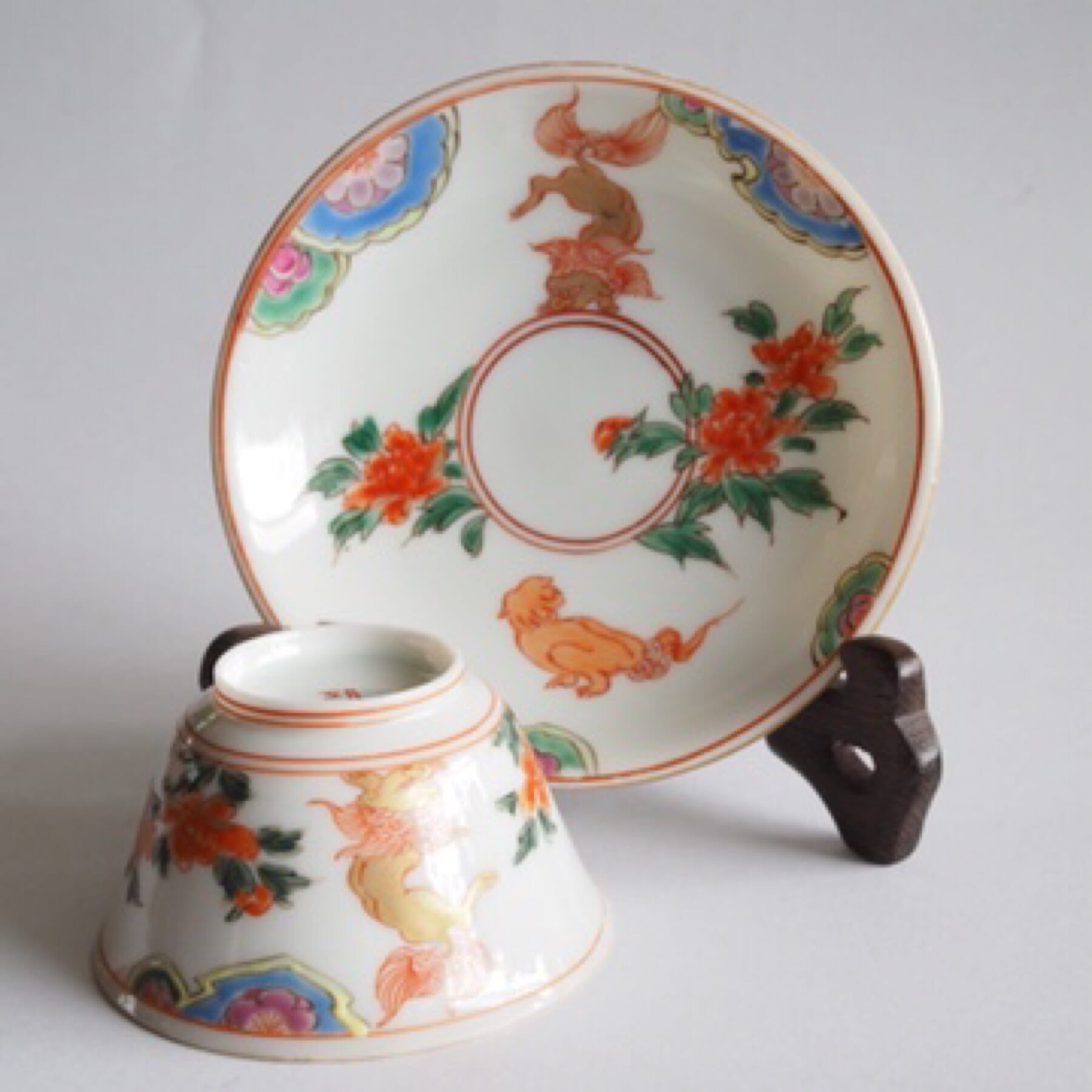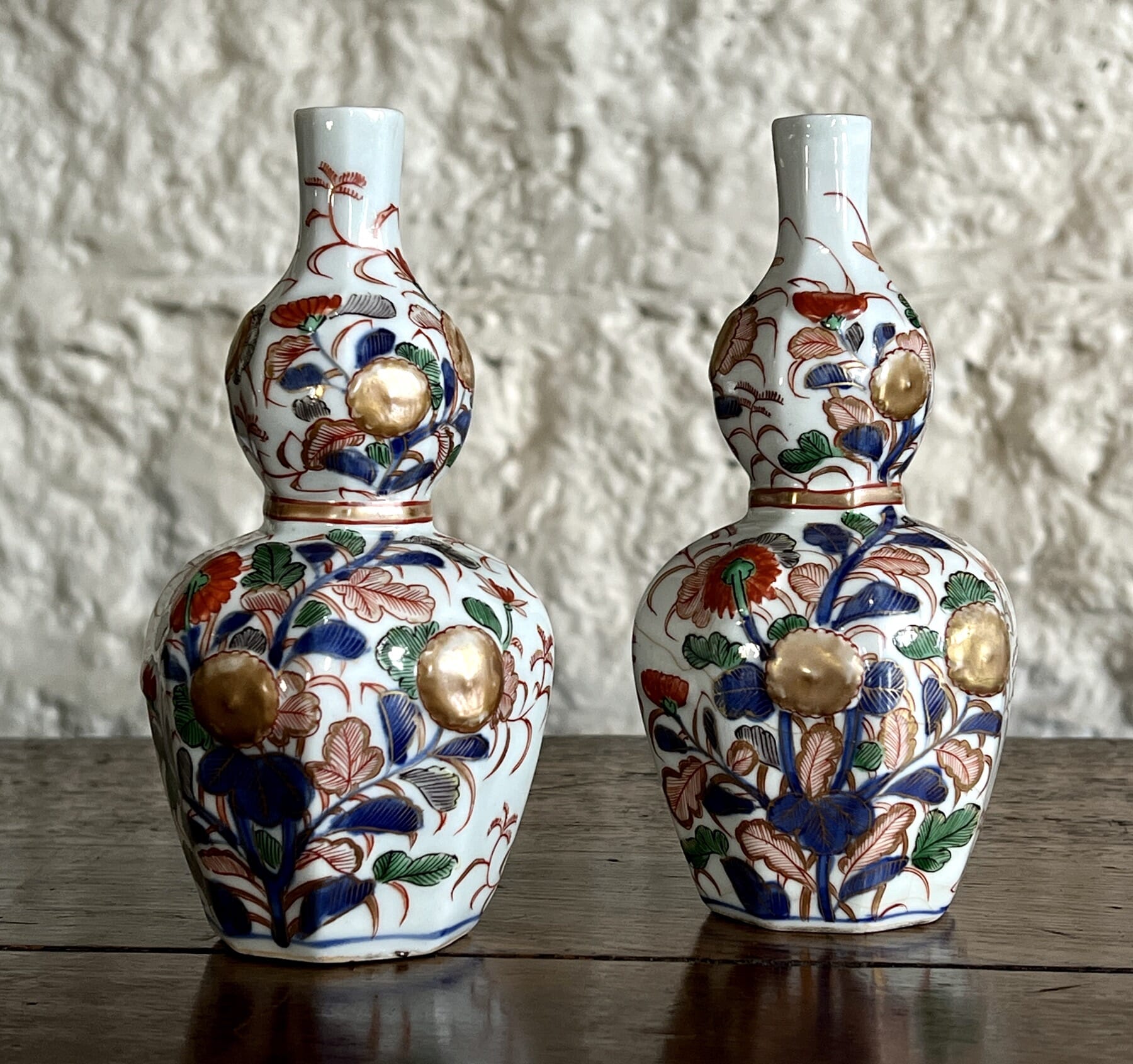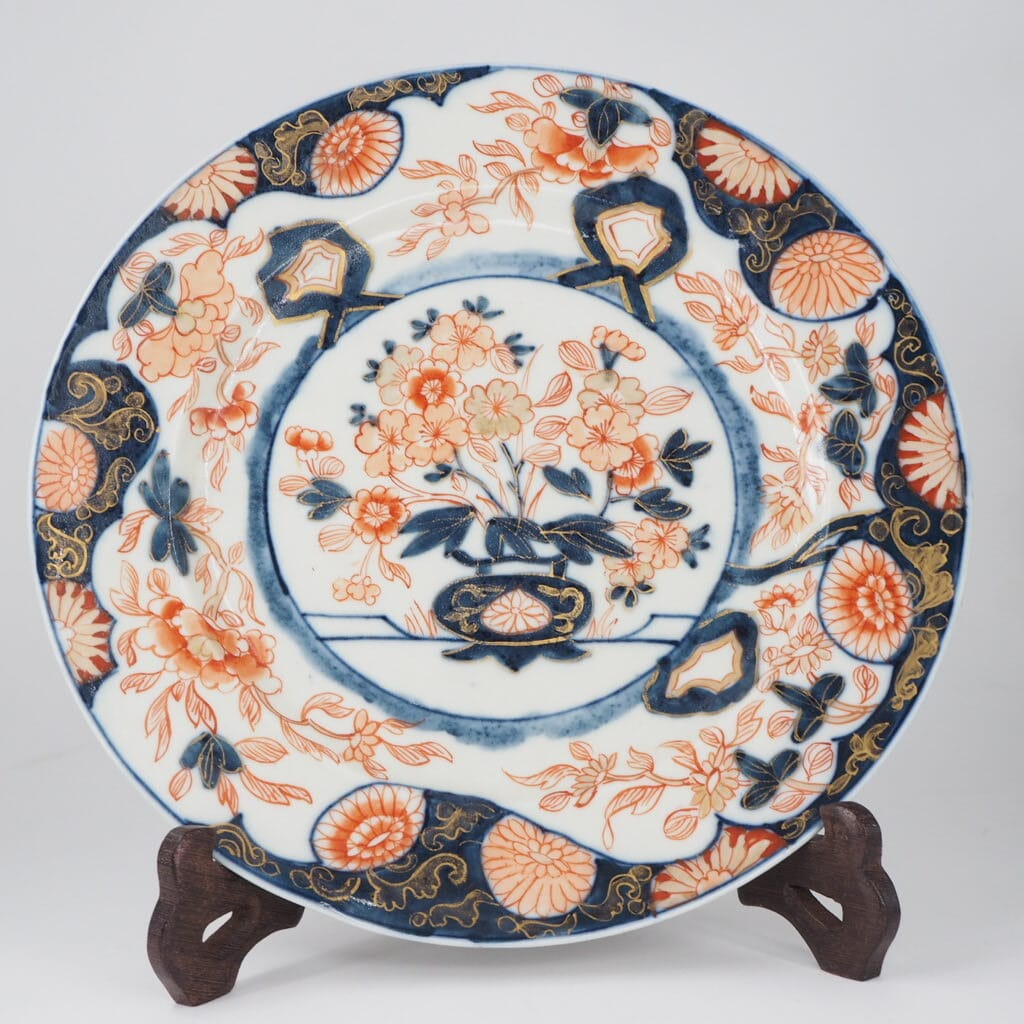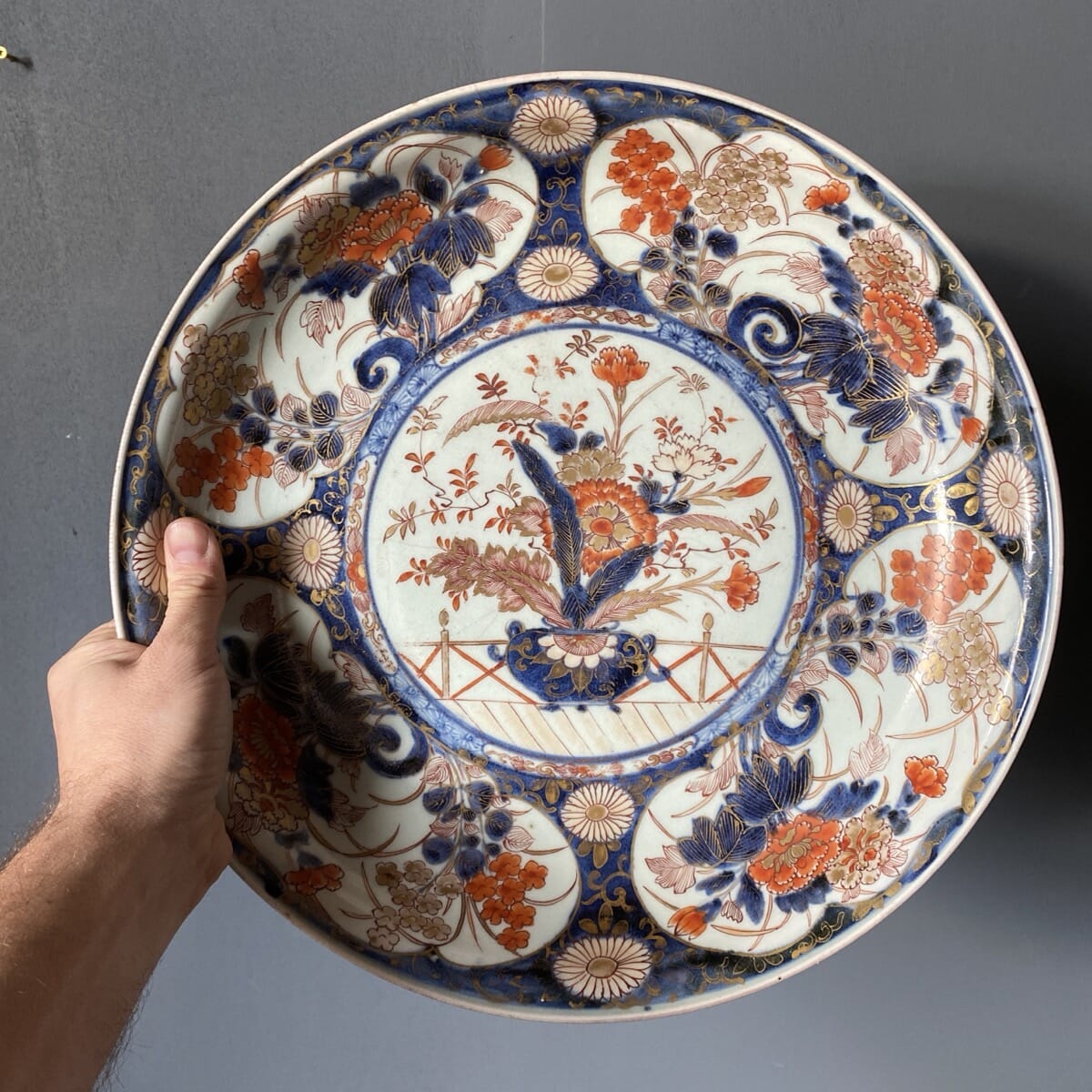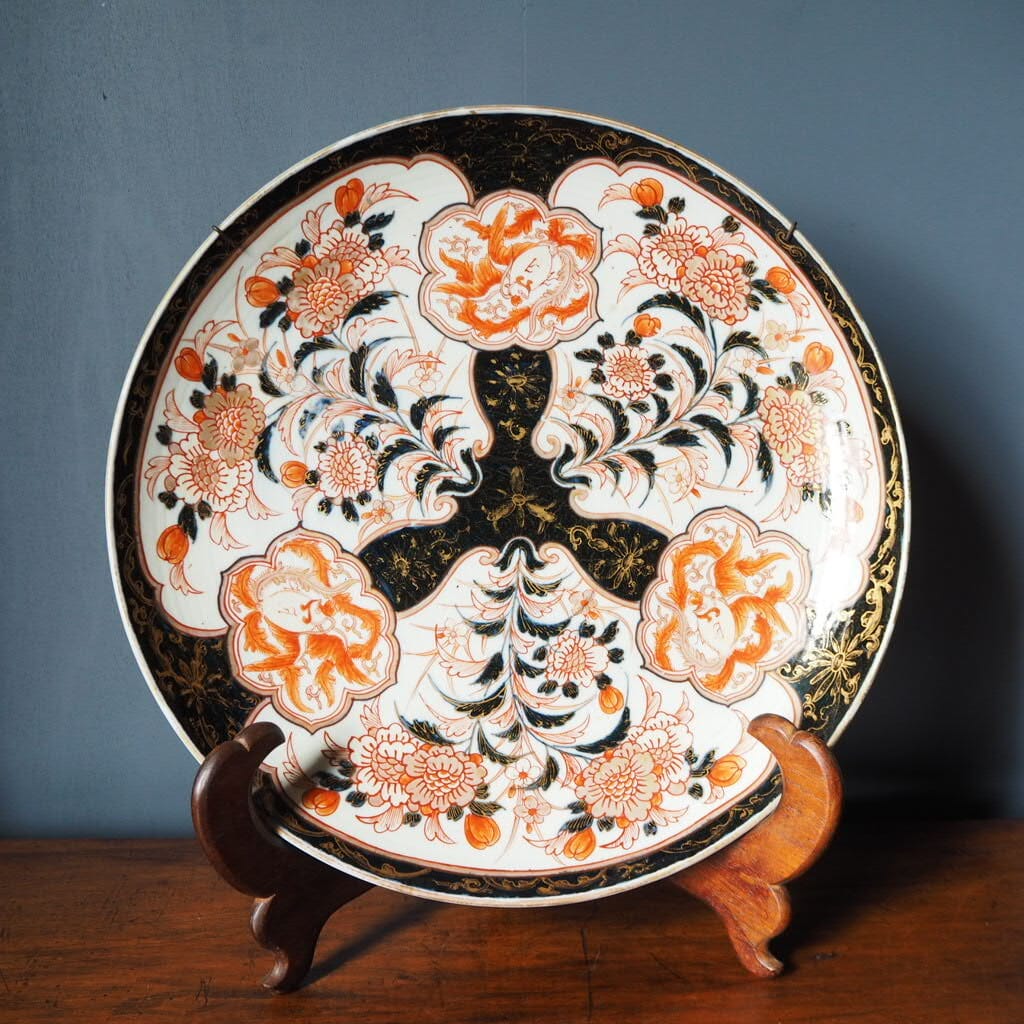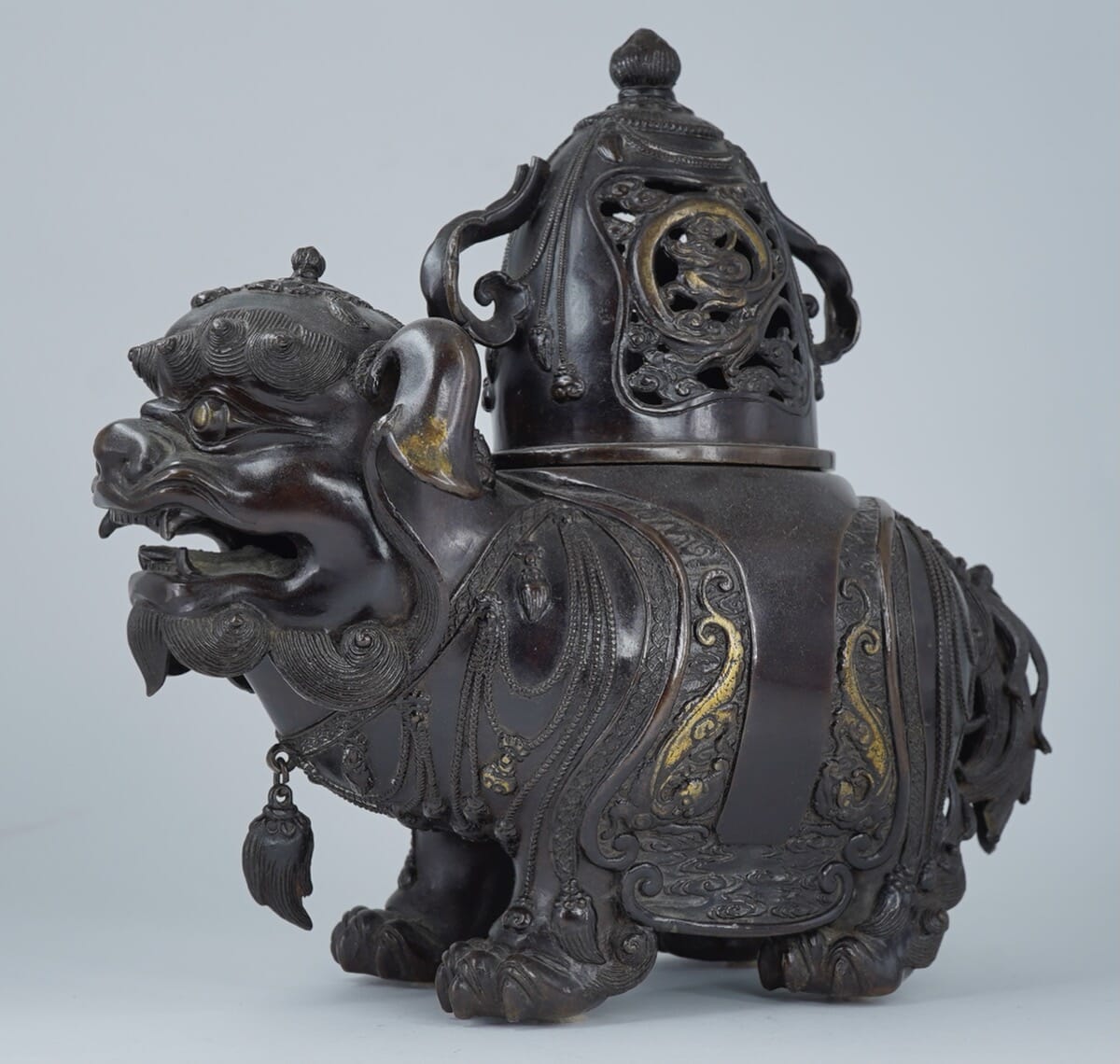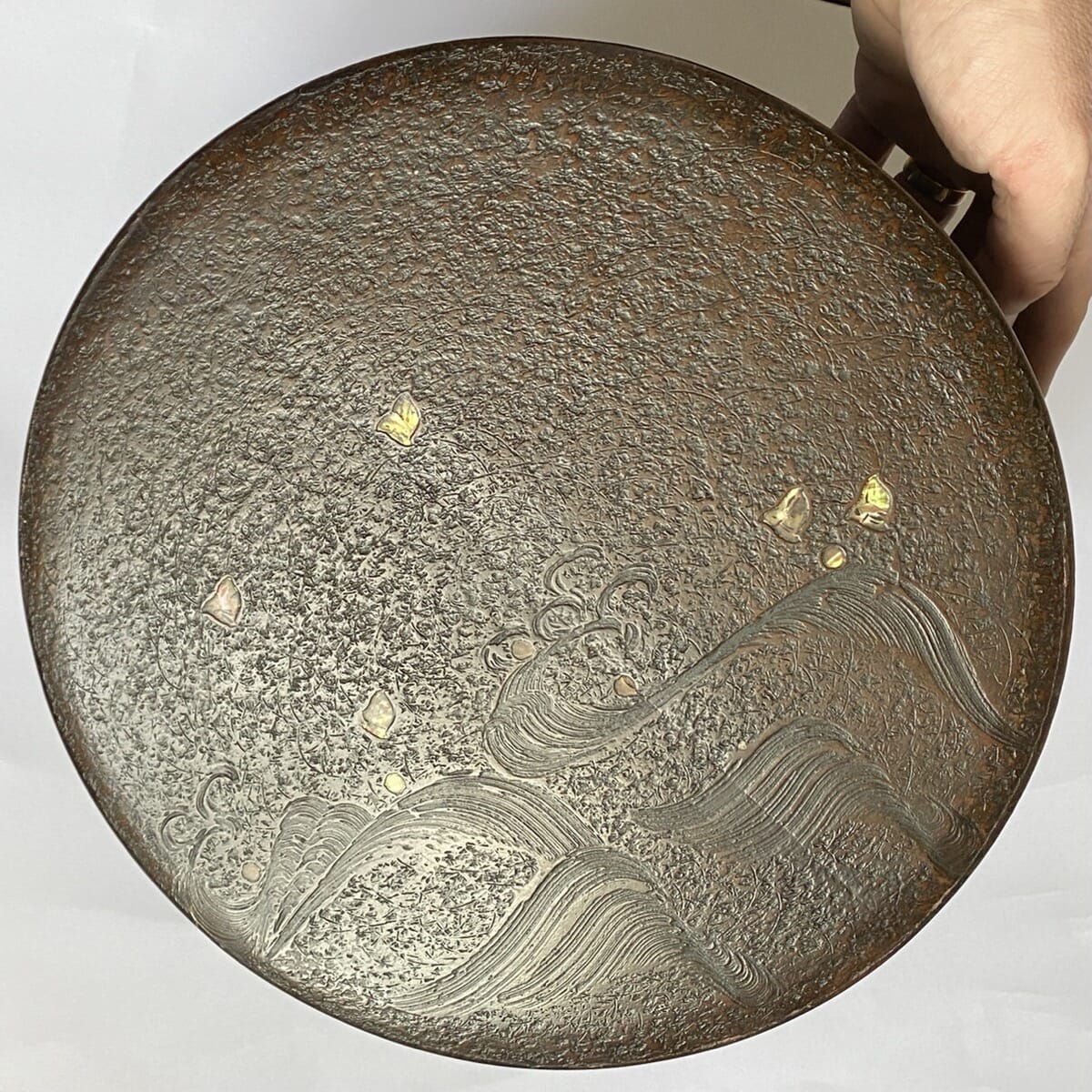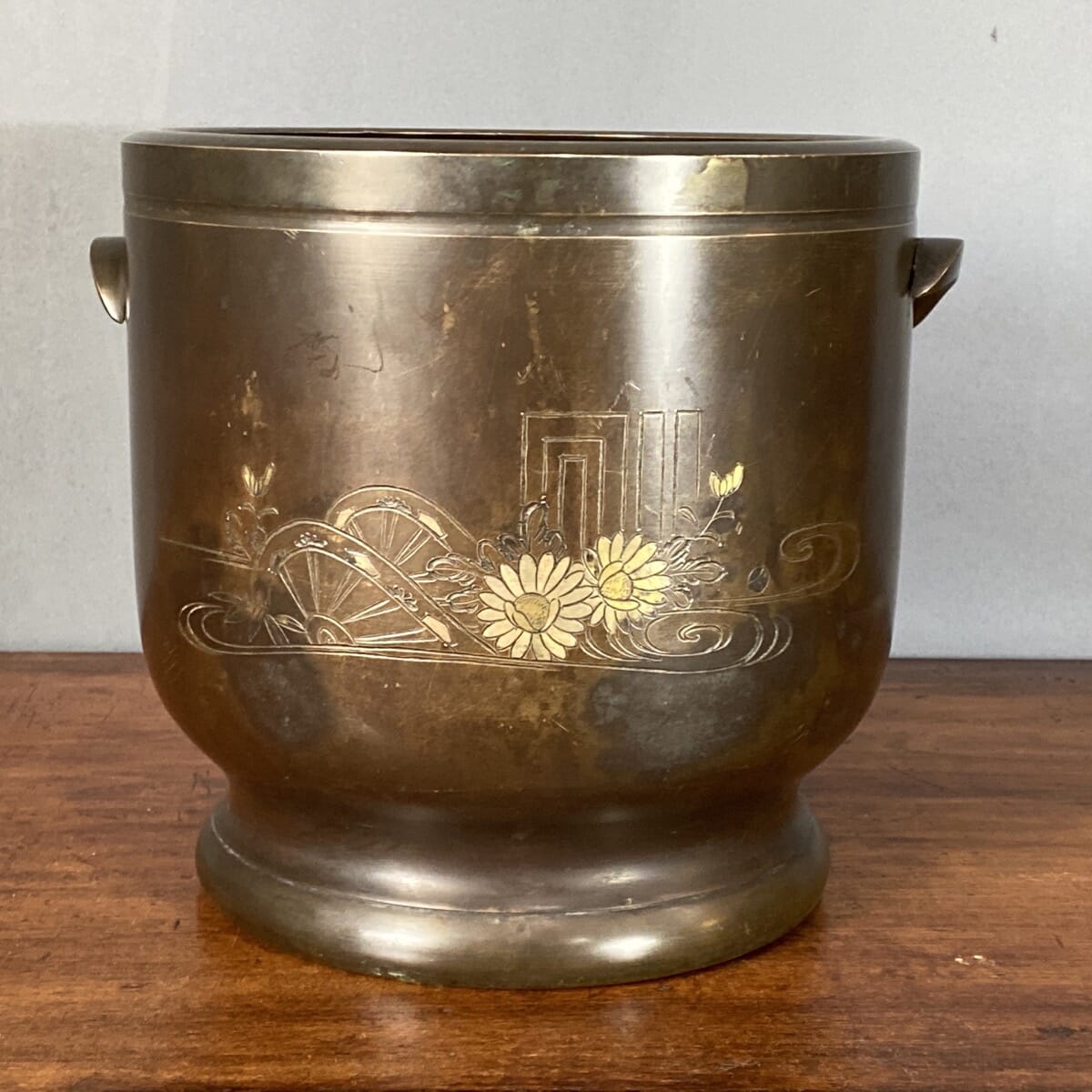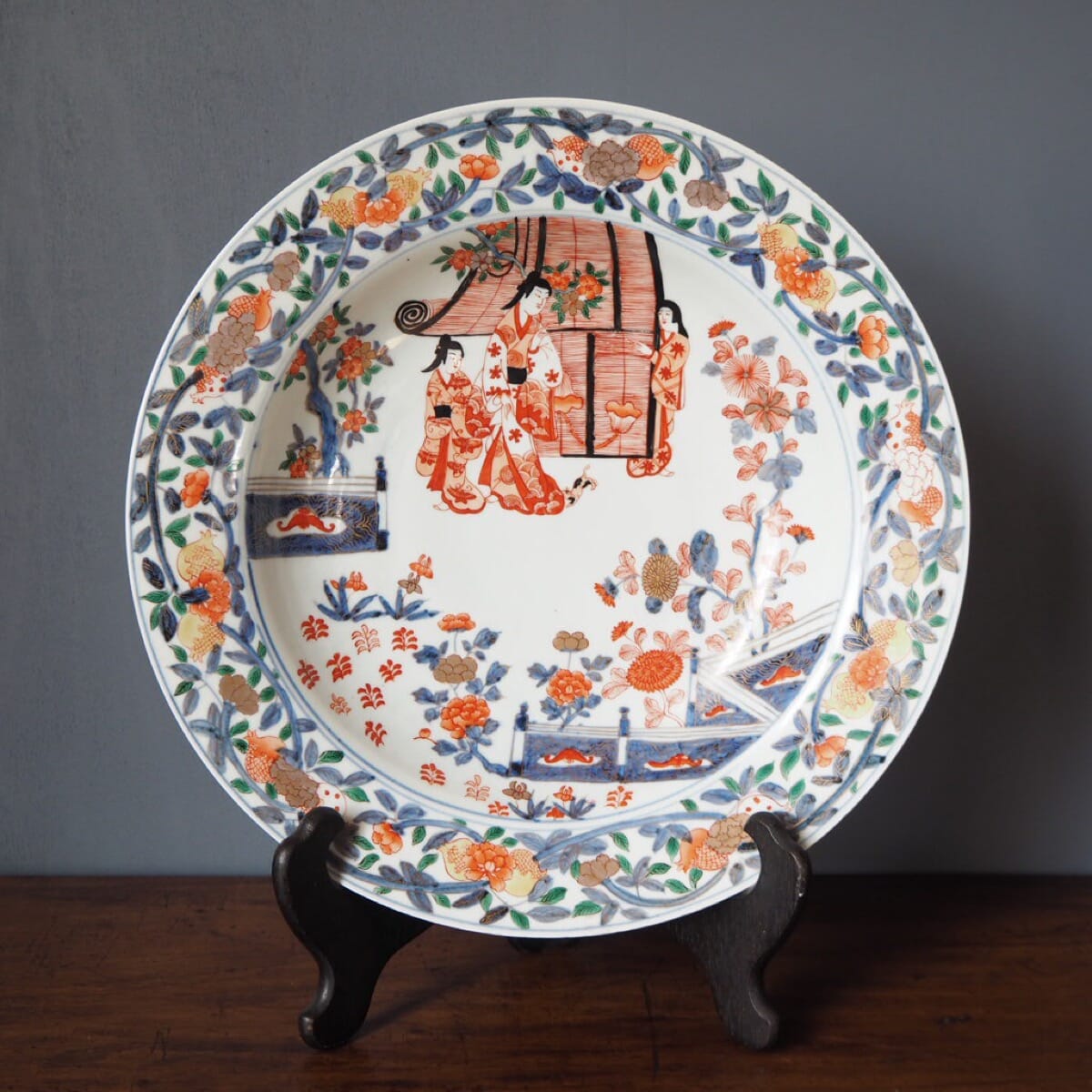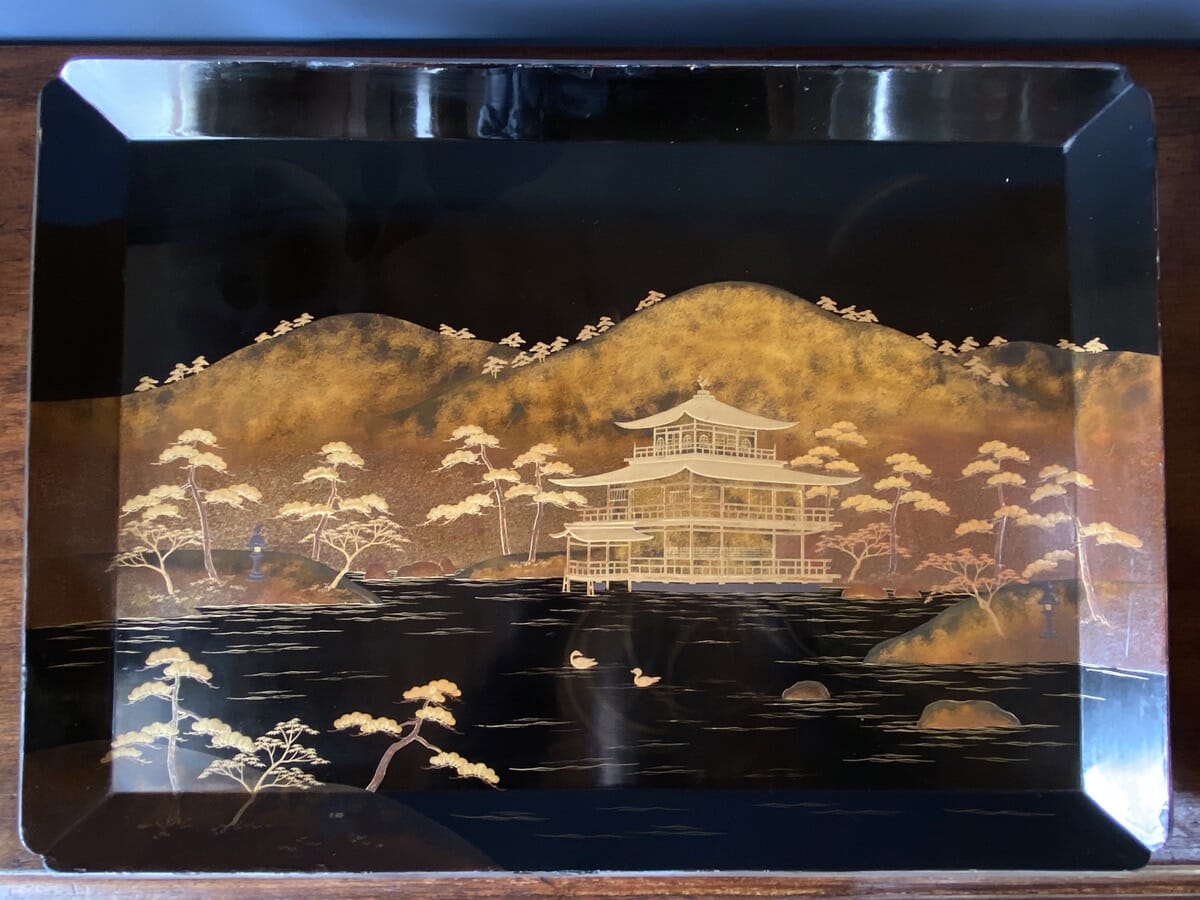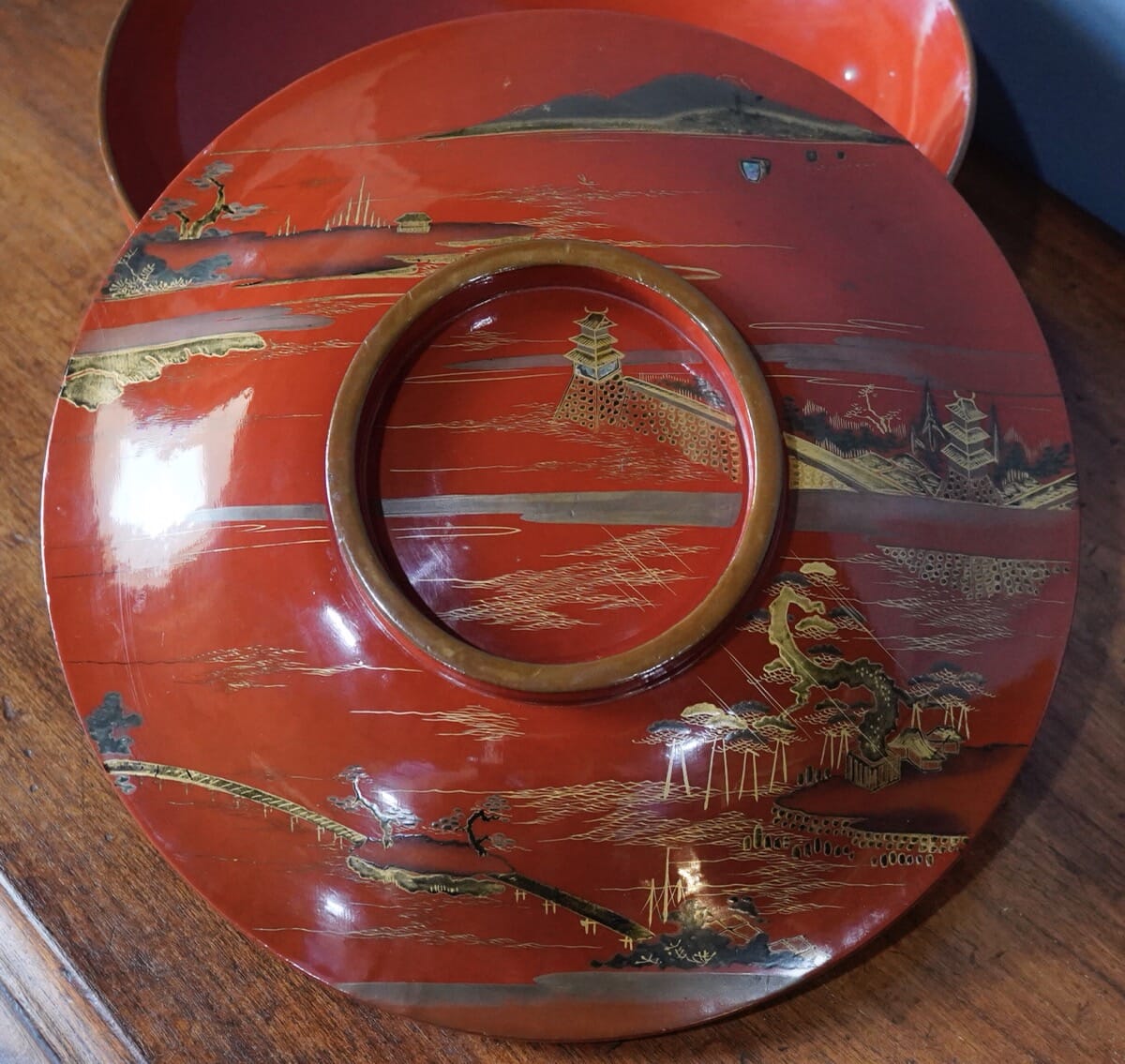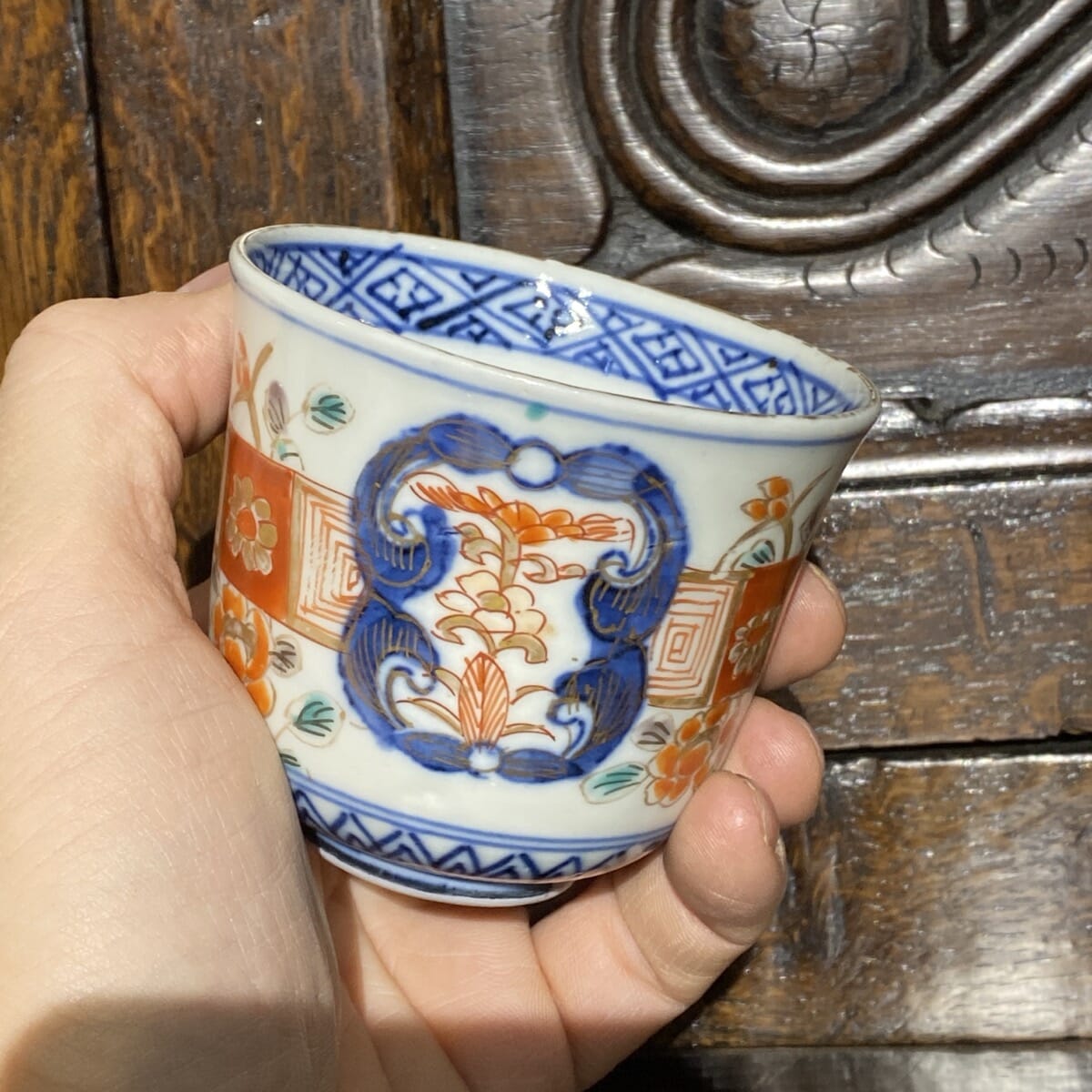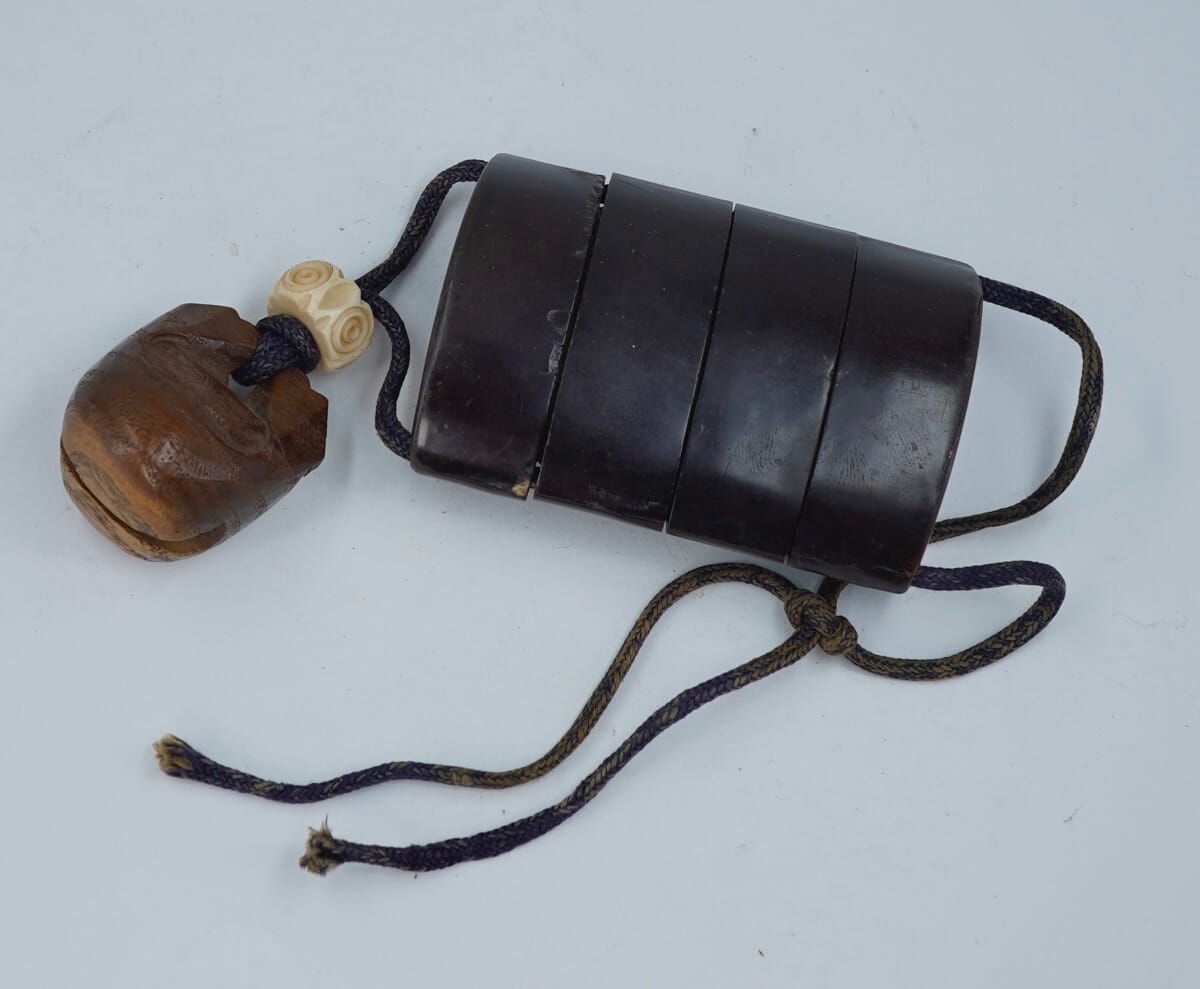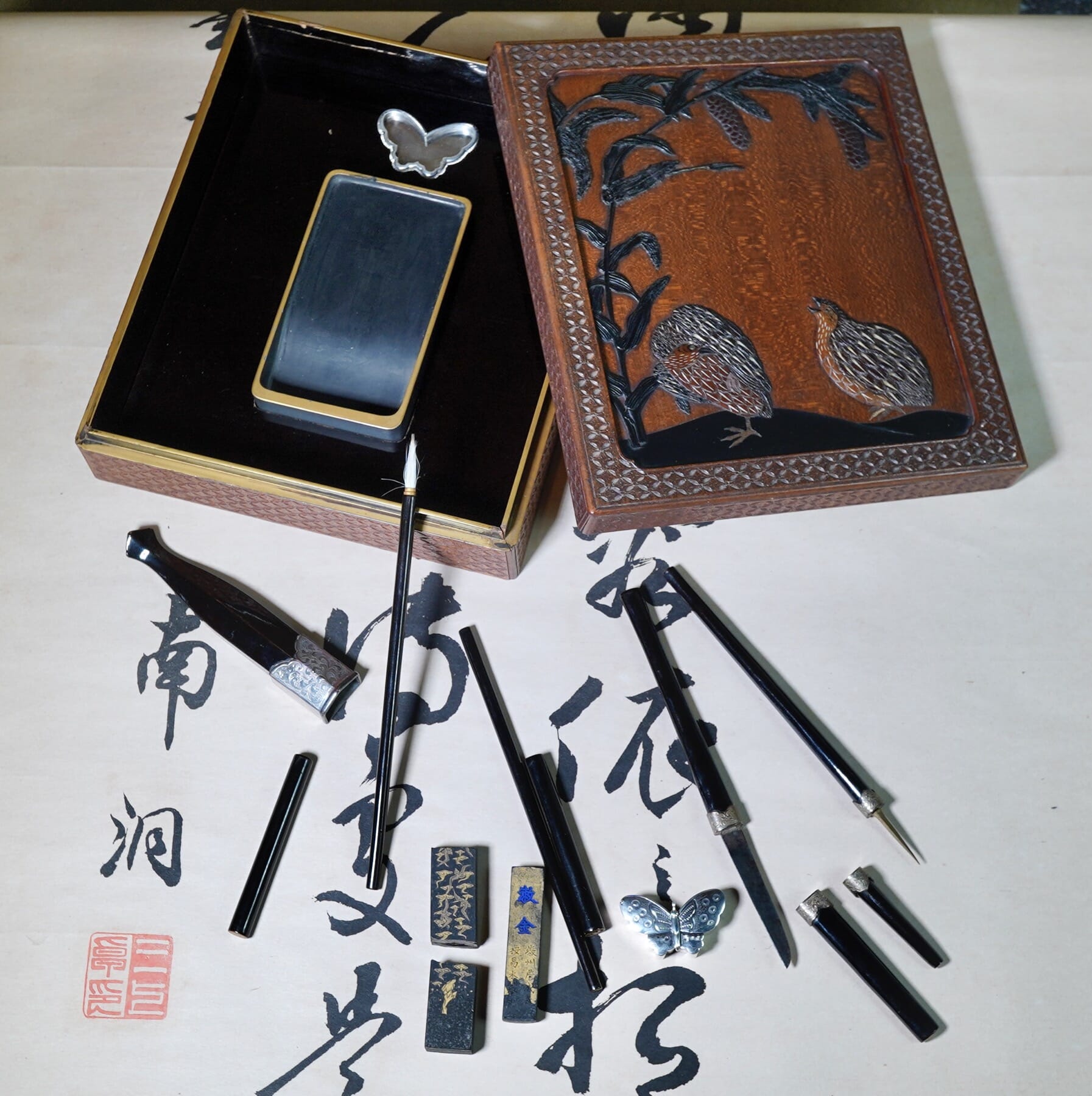
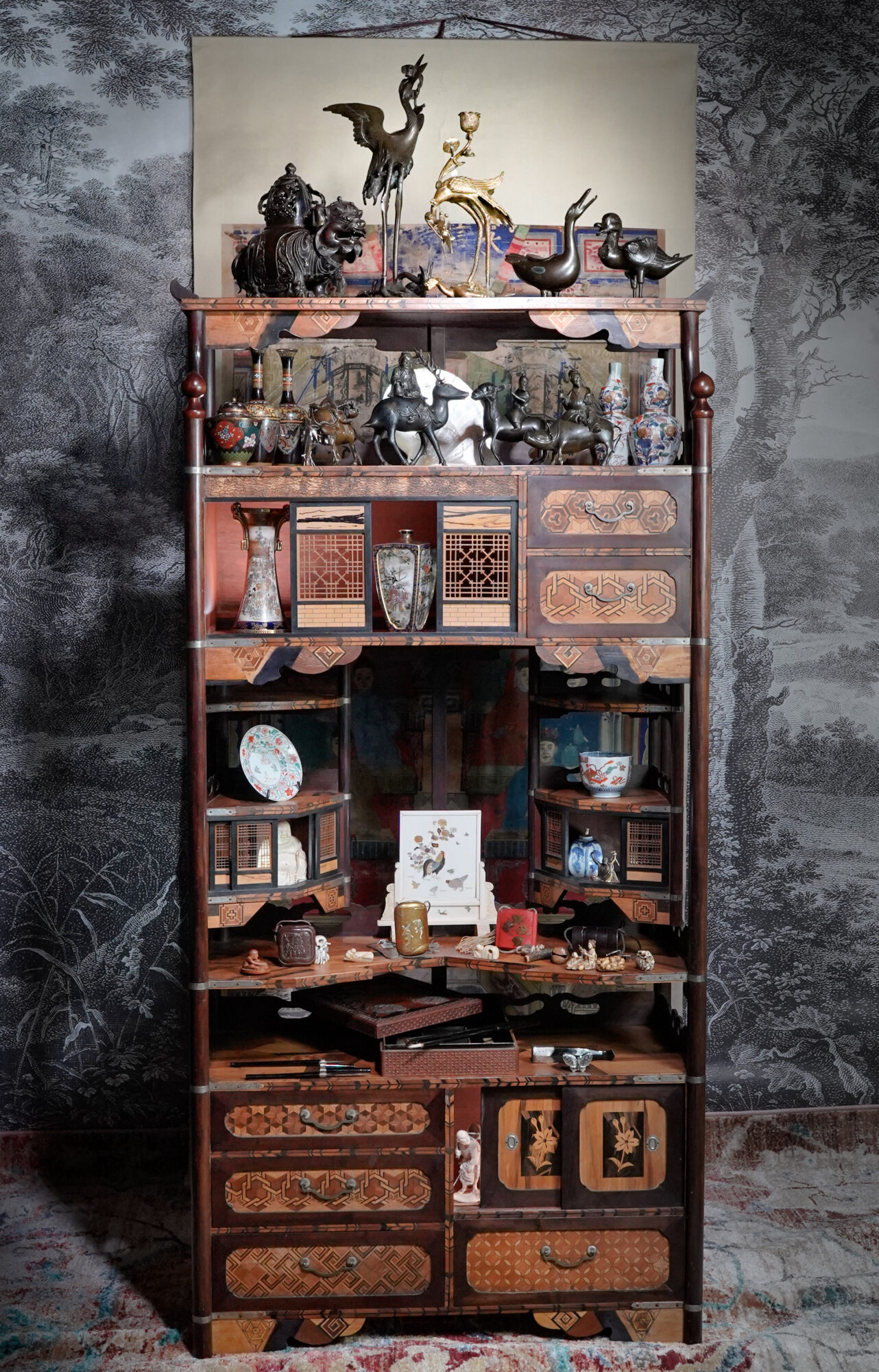
This stunning cabinet is known as a Shodana, and is seen here being used as intended – it’s a ‘curio cabinet’, to store your precious objects in.
What makes this example so interesting is the architectural element – the central portion contains two three-shelf corner partitions, the lower one having four sliding screen doors – miniature versions of the Japanese house doors – and the entire segment hinges outward, to leave the interior space clear. Above is another larger shelf section with four similar sliding doors. The open fretwork on these is amazing for its fineness and accuracy, true miniatures of the full-sized house doors in Meiji Japan. Add to that the rich wood inlay, and this is a truely spectacular piece of Japanese Meiji period craftsmanship.
Suzuribako writing box
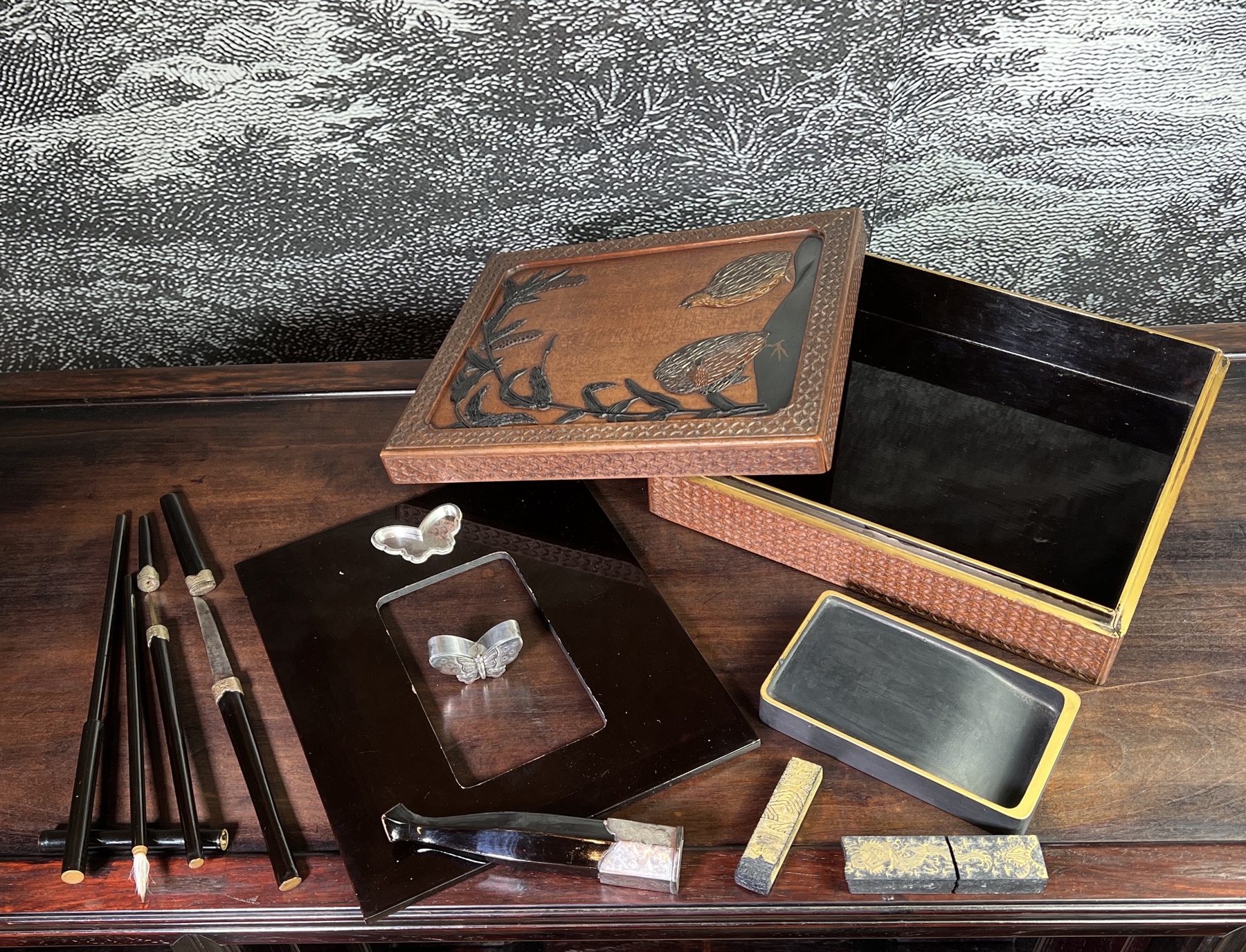
A fine quality Japanese piece fresh to stock is this Japanese Suzuribako writing box. The lid has an intricate panel of quail and a maize plant, modelled in high relief with various woods and bone, the rest of the box adorned with an intricately carved cell pattern, the interior lined in jet black lacquer with gilt foliage to the inside of lid, fitted with a full set of writing instruments, including silver butterfly Suiteki inset within a silver dish, a carved slate ink-stone with gilt rim, two brushes, a bodkin with lacquer sheath & a matching steel blade with inscribed maker’s inscription, and two gilt-decorated ink blocks.
Meiji period,
Circa 1870
23.5cm x 20.5cm, 6cm high
blade 6.5cm, in sheaf 19cm
An Inro Treasure
This is an ‘Inro’, a small box with cord to carry at your waist. Standing just 8cm tall, it was intended to contain ‘medicine’, via a series of segments that seal tightly together, a small usable compartment in the base of each.
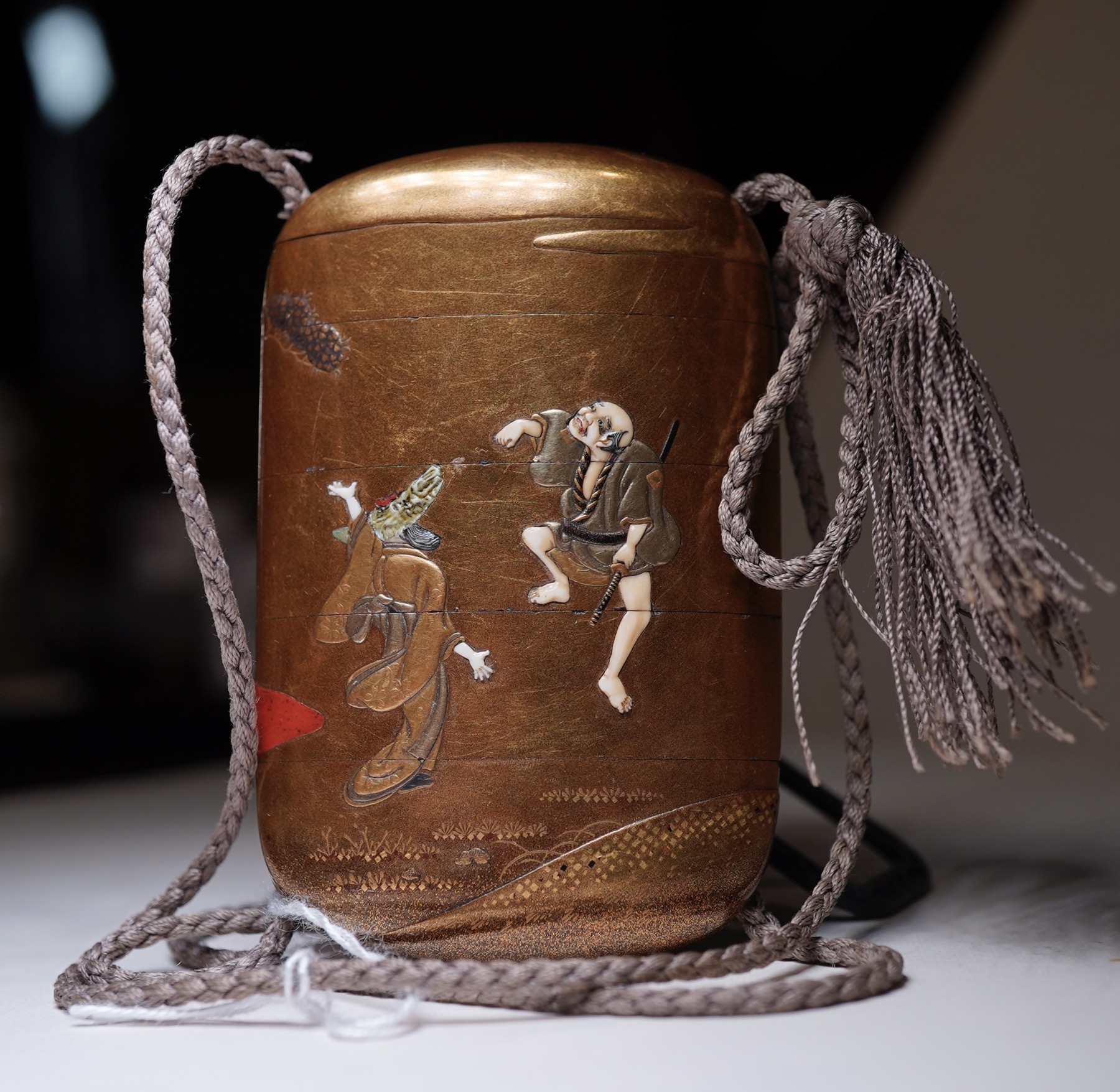

The quality of this piece speaks for itself, with a very finely detailed continuous scene – probably from a popular play – depicting two gracious ladies seeing off a bare-foot bald-headed Samurai, clutching his sword. They were enjoying a quiet picnic in the woods a moment ago, as can be seen by the red rug with picnic box, wine bottle and cup….. and the intruder on the other side, a wizen old Samurai warrior with his sword, is receiving a good telling-off by the startled ladies. No doubt it’s illustrating something form a popular play of the period – if anyone knows, please send us a message!

There is a signature to the base of the lowest segment, which is interesting as it bears to parts; first, an inlaid mother-of-pearl plaque with ‘芝山’ , and second, three characters in gold lacquer “松花齋”. These signatures reveal the origins of this piece; the lacquer case and landscape is by Shokasai, a well known & respected Edo lacquer artist, while the fine inlaid figures is by the fabled Shibayama artists, made as a joint effort & hence signed by both.
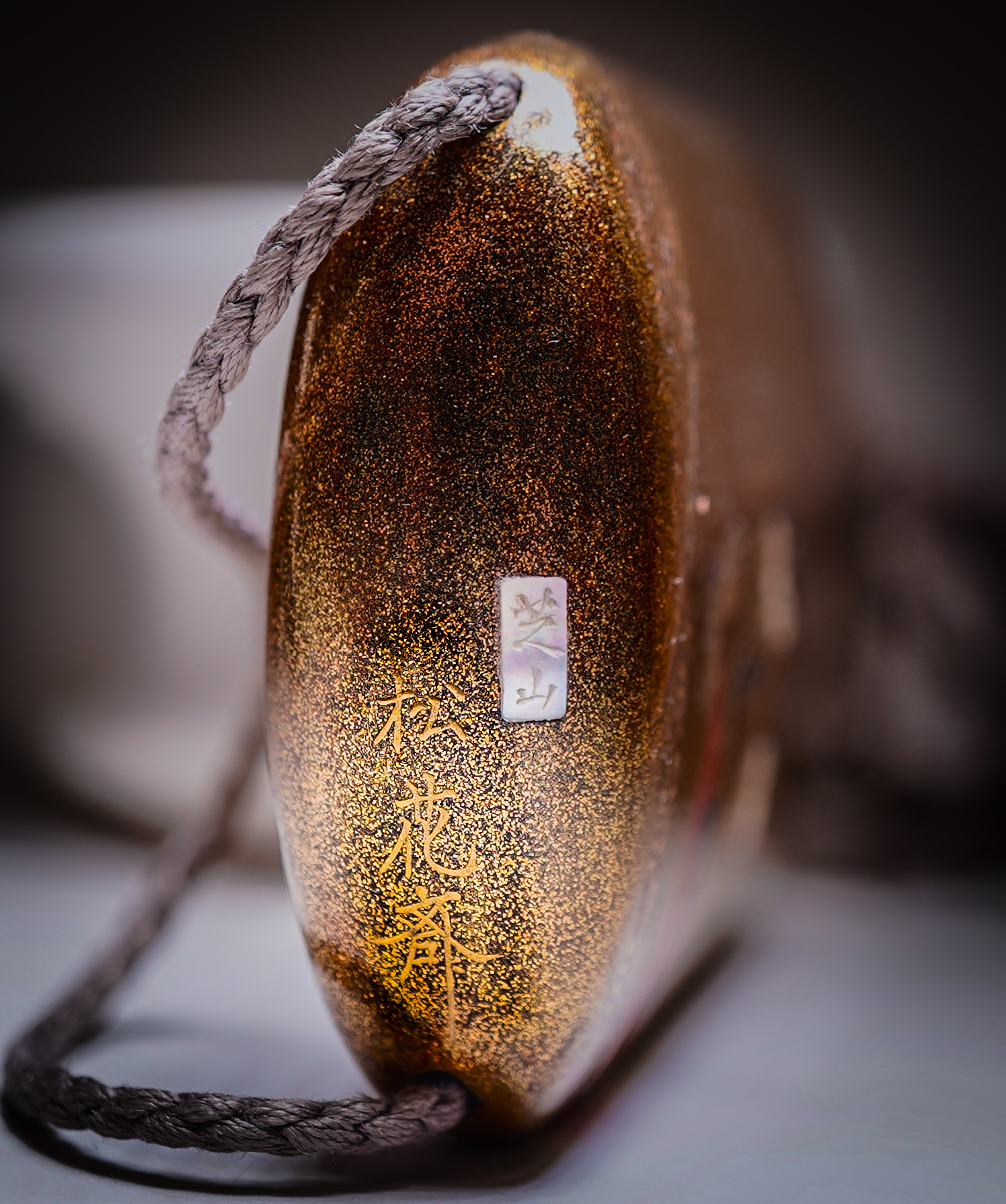
Shibayama: this Japanese family workshop of artisans was founded by Shabayama Dosho, also known as Senzo. He was a farmer from Shibayama who became a famous artist in the 18th century after moving to Edo to practice his trade. He had many descendents, such as his grandson & successor, Shibayama Naoyuki, who continued the workshop’s tradition for fine inlaid work into the 19th century. Records are not distinct when it comes to the later Edo period Shibayama artists, as they all used the simple signature “‘芝山” , for ‘Shibayama’.
Shokasai:
ref. Bonhams NY 19 Sept. 2008, lot 5036 for a comparable example.
Japanese Woodblock Prints
Japanese artists began to print in the 17th century, and technological advances meant that by the 18th century they were able to produce large & colourful images. For the multi-coloured images, a different wood block was carved for each, and carefully lined up consecutively to create the multi-colours image.
They were initially commissions by the wealthy Edo period patrons to illustrate calendars, which they gave as New Year presents. Subjects were often beautiful courtesans, actors, or illustrations of popular opera scenes. Scenic splendour and historical events followed. They were hugely popular in Japan, and specialty shops existed just to sell ‘the latest’ from the famous artists. Collectors would be inclined to ’collect the series’ by a particular artist, storing them away in specialty wooden boxes. In many ways, it was just like the present day Comic Book scene!
The simple lines, and the bright separate zones of flat colour were the result of the techniques used. They were very important factors in the development of Western Art, once collectors discovered them in the later 19th century. In fact, it’s well documented that the great ’fathers of Modern Art’ such as Gauguin and Van Gogh both collected and were inspired by Japanese Woodblocks, as they set about their quest for a break with the traditions of Western Art.
We have a selection of these vivid prints for sale, some shown below with more to come shortly.

Vase: Kyoto Satsuma, featuring rare ’Gosu Blue’ enamel, circa 1880
-
 ‘Three Courtesans playing Music’, after Eishi Hosoda (1756-1829) Japanese Woodblock Print triptych,$295.00 AUD
‘Three Courtesans playing Music’, after Eishi Hosoda (1756-1829) Japanese Woodblock Print triptych,$295.00 AUD -
 Satsuma Kyoto vase with scenic panels, pierced sides, c.1880$3,400.00 AUD
Satsuma Kyoto vase with scenic panels, pierced sides, c.1880$3,400.00 AUD -
 Japanese woodblock print of Samurai, 19th C.$390.00 AUD
Japanese woodblock print of Samurai, 19th C.$390.00 AUD -
 Japanese woodblock print, two ladies by Toschikata, c.1890Sold
Japanese woodblock print, two ladies by Toschikata, c.1890Sold
Satsuma
Satsuma is a favorite Japanese decorative item, and is distinct & unique
-
 Rare Japanese Satsuma dish with Ancient Egyptian motifs, c. 1920Sold
Rare Japanese Satsuma dish with Ancient Egyptian motifs, c. 1920Sold -
 Japanese Satsuma boy with drum figure – lamp base, c. 1920$245.00 AUD
Japanese Satsuma boy with drum figure – lamp base, c. 1920$245.00 AUD -
 Small Japanese Satsuma button stud, late 19th centurySold
Small Japanese Satsuma button stud, late 19th centurySold -
 Satsuma spherical toggle fitting, flowers & butterflies, c. 1880$185.00 AUD
Satsuma spherical toggle fitting, flowers & butterflies, c. 1880$185.00 AUD -
 Satsuma belt buckles, scenic panels, c. 1895Sold
Satsuma belt buckles, scenic panels, c. 1895Sold -
 Japanese Satsuma cup+ saucer, C. 1895$125.00 AUD
Japanese Satsuma cup+ saucer, C. 1895$125.00 AUD -
 Japanese Satsuma pottery vase, flower garden & verse, Meiji 19th century$65.00 AUD
Japanese Satsuma pottery vase, flower garden & verse, Meiji 19th century$65.00 AUD -
 Satsuma belt buckle, cranes in a garden, 19th century$165.00 AUD
Satsuma belt buckle, cranes in a garden, 19th century$165.00 AUD -
 Set of 4 Satsuma buttons, wisteria, c. 1900$580.00 AUD
Set of 4 Satsuma buttons, wisteria, c. 1900$580.00 AUD -
 Japanese Satsuma covered box, Meiji period, 19th centurySold
Japanese Satsuma covered box, Meiji period, 19th centurySold -
 Japanese Satsuma pottery cup & saucer, enlightened scholars, c1890Sold
Japanese Satsuma pottery cup & saucer, enlightened scholars, c1890Sold -
 Pair of Satsuma vases, scenes and faces, c.1880$350.00 AUD
Pair of Satsuma vases, scenes and faces, c.1880$350.00 AUD -
 Japanese Satsuma tea kettle, rare ‘Minogame’ Turtle form , signed Makuzu Kozan , c. 1900Sold
Japanese Satsuma tea kettle, rare ‘Minogame’ Turtle form , signed Makuzu Kozan , c. 1900Sold -
 Japanese Satsuma lidded pot, painted iris, c. 1900$120.00 AUD
Japanese Satsuma lidded pot, painted iris, c. 1900$120.00 AUD -
Product on sale
 Japanese Satsuma ‘bucket’ vase, warriors, circa 1890Original price was: $320.00 AUD.$288.00 AUDCurrent price is: $288.00 AUD.
Japanese Satsuma ‘bucket’ vase, warriors, circa 1890Original price was: $320.00 AUD.$288.00 AUDCurrent price is: $288.00 AUD.
The Allure of Japan
-
 Rare Japanese lacquer plaque, gold printed Mt Fuji view H.Musino patent c.1900Sold
Rare Japanese lacquer plaque, gold printed Mt Fuji view H.Musino patent c.1900Sold -
 Japanese Inro, by Shibayama & Shokasai, Edo-Meiji period 19th c.Sold
Japanese Inro, by Shibayama & Shokasai, Edo-Meiji period 19th c.Sold -
 Unusual Japanese Cloisonné & bronze wirework peach-shape basket, c.1900$280.00 AUD
Unusual Japanese Cloisonné & bronze wirework peach-shape basket, c.1900$280.00 AUD -
 Fukutaro Terauchi, Large Watercolour of Mount Fuji, 1930’s$395.00 AUD
Fukutaro Terauchi, Large Watercolour of Mount Fuji, 1930’s$395.00 AUD -
 Japanese Cloisonné sensor, C.1900$340.00 AUD
Japanese Cloisonné sensor, C.1900$340.00 AUD -
 ‘Three Courtesans playing Music’, after Eishi Hosoda (1756-1829) Japanese Woodblock Print triptych,$295.00 AUD
‘Three Courtesans playing Music’, after Eishi Hosoda (1756-1829) Japanese Woodblock Print triptych,$295.00 AUD -
 Tall bronze pricket candlestick, wide base drip pan, Japanese 19th century$345.00 AUD
Tall bronze pricket candlestick, wide base drip pan, Japanese 19th century$345.00 AUD -
 Meiji Suzuribako writing box with inlaid quail amongst maize, c.1870$2,200.00 AUD
Meiji Suzuribako writing box with inlaid quail amongst maize, c.1870$2,200.00 AUD -
 Japanese Shodhana cabinet, hinging Meiji period, c.1880Sold
Japanese Shodhana cabinet, hinging Meiji period, c.1880Sold -
 Japanese porcelain spiral fluted bowl with underglaze blue butterflies and central dragon, c.1900$280.00 AUD
Japanese porcelain spiral fluted bowl with underglaze blue butterflies and central dragon, c.1900$280.00 AUD -
 Japanese blue & white plate, landscapes & flower panels, 19th century$480.00 AUD
Japanese blue & white plate, landscapes & flower panels, 19th century$480.00 AUD -
 Japanese bowl & cover, hidden dragon pattern, Guangxu mark (1875-1908), late 19th century$440.00 AUD
Japanese bowl & cover, hidden dragon pattern, Guangxu mark (1875-1908), late 19th century$440.00 AUD -
 Japanese large wooden screen, carved with birds & flowers, ex- Purrumbete, Western District, c.1890Sold
Japanese large wooden screen, carved with birds & flowers, ex- Purrumbete, Western District, c.1890Sold -
 Japanese carved wooden Eagle, life-size on branch, 19th century$495.00 AUD
Japanese carved wooden Eagle, life-size on branch, 19th century$495.00 AUD -
 Pair of Japanese Imari plates, flower vases, Circa 1700$1,850.00 AUD
Pair of Japanese Imari plates, flower vases, Circa 1700$1,850.00 AUD -
 Large Japanese Porcelain vase with rabbit handles, C. 1880$780.00 AUD
Large Japanese Porcelain vase with rabbit handles, C. 1880$780.00 AUD -
 Large Japanese Imari charger, c.1880$450.00 AUD
Large Japanese Imari charger, c.1880$450.00 AUD -
 Japanese kinran-de Imari plate, circa 1720$420.00 AUD
Japanese kinran-de Imari plate, circa 1720$420.00 AUD -
 Japanese blue & white landscape plate, flower form, c.1700$680.00 AUD
Japanese blue & white landscape plate, flower form, c.1700$680.00 AUD -
 Japanese blue & white landscape plate, flower form, c.1700$680.00 AUD
Japanese blue & white landscape plate, flower form, c.1700$680.00 AUD -
 Japanese Sometsuke dish , ‘three friends’ pattern, 18th century$740.00 AUD
Japanese Sometsuke dish , ‘three friends’ pattern, 18th century$740.00 AUD -
 Japanese small dish, polychrome flowers & central figures, early 18th$680.00 AUD
Japanese small dish, polychrome flowers & central figures, early 18th$680.00 AUD -
 Japanese bronze-patinated iron eagle sculpture, c. 1900$345.00 AUD
Japanese bronze-patinated iron eagle sculpture, c. 1900$345.00 AUD -
 Japanese tea bowl and saucer, orange flowers and gilt dragons, c.1900Sold
Japanese tea bowl and saucer, orange flowers and gilt dragons, c.1900Sold -
 Pair of Japanese Imari vases, octagonal gourd shape with moulded & painted chrysanthemum, 18th c.Sold
Pair of Japanese Imari vases, octagonal gourd shape with moulded & painted chrysanthemum, 18th c.Sold -
 Japanese Imari plate, flower urn pattern, c. 1720$780.00 AUD
Japanese Imari plate, flower urn pattern, c. 1720$780.00 AUD -
 Large Japanese Imari charger, flower vase, circa 1700$4,750.00 AUD
Large Japanese Imari charger, flower vase, circa 1700$4,750.00 AUD -
 Large Japanese Imari charger, 17th century$4,500.00 AUD
Large Japanese Imari charger, 17th century$4,500.00 AUD -
 Japanese bronze ‘ShiShi’ -komainu- censor, Meiji Period, 19th century$2,450.00 AUD
Japanese bronze ‘ShiShi’ -komainu- censor, Meiji Period, 19th century$2,450.00 AUD -
 Japanese lacquer hat box, waterfall & butterflies inlayed/incised, c. 1900Sold
Japanese lacquer hat box, waterfall & butterflies inlayed/incised, c. 1900Sold -
 Bronze jardinière, incised flowers, Japanese c. 1880$175.00 AUD
Bronze jardinière, incised flowers, Japanese c. 1880$175.00 AUD -
 Japanese Imari charger, domestic scene, Edo period 19th century$3,450.00 AUD
Japanese Imari charger, domestic scene, Edo period 19th century$3,450.00 AUD -
 Japanese Lacquer tray, lakeside pavilion, c. 1900$340.00 AUD
Japanese Lacquer tray, lakeside pavilion, c. 1900$340.00 AUD -
 Large Japanese red lacquer bowl & lid, landscape in gold, c. 1900$325.00 AUD
Large Japanese red lacquer bowl & lid, landscape in gold, c. 1900$325.00 AUD -
 Japanese beaker, Imari colours, 18th century$580.00 AUD
Japanese beaker, Imari colours, 18th century$580.00 AUD -
 Japanese Inro, horn with wooden bell netsuke, 19th/20th century$420.00 AUD
Japanese Inro, horn with wooden bell netsuke, 19th/20th century$420.00 AUD


